Digi 50M1589 Wireless Embedded ARM Module User Manual ConnectCore 9P 9215 HRM
Digi International Inc Wireless Embedded ARM Module ConnectCore 9P 9215 HRM
Digi >
Hardware reference manual
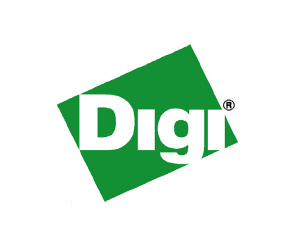
ConnectCore™
9P 9215 and Wi-9P 9215
Hardware Reference
90000879_F
Release date: March 2009
©2008 Digi International Inc.
All rights reserved.
Digi, Digi International, the Digi logo, a Digi International Company, Digi JumpStart Kit, ConnectCore,
NET+, NET+OS and NET+Works are trademarks or registered trademarks of Digi International, Inc. in the
United States and other countries worldwide. All other trademarks are the property of their respective
owners.
Information in this document is subject to change without notice and does not represent a commitment
on the part of Digi International.
Digi provides this document “as is,” without warranty of any kind, either expressed or implied, including,
but not limited to, the implied warranties of fitness or merchantability for a particular purpose. Digi may
make improvements and/or changes in this manual or in the product(s) and/or the program(s) described
in this manual at any time.
This product could include technical inaccuracies or typographical errors. Changes are periodically made
to the information herein; these changes may be incorporated in new editions of the publication.

Contents
. . . . . . . . . . . . . . . . . . . . . . . . . . . . . . . . . . . . . . . . . . . . . . . . . . . . . . . . . . . . . . . .
. . . . . . .
Customer support .............................................................................. 9
Chapter 1: About the Module ............................. 11
Features and functionality ............................................................12
Module variant ................................................................................12
Module pinout ..........................................................................13
Pinout legend: Type ..........................................................................13
X1 pinout .......................................................................................13
X2 pinout .......................................................................................17
Configuration pins — CPU .............................................................25
Default module CPU configuration .........................................................25
Configuration pins — Module .........................................................26
Identification of the module ................................................................26
Module pin configuration ....................................................................26
Clock generation .......................................................................27
Clock frequencies .............................................................................27
Changing the CPU speed .....................................................................28
Boot process ............................................................................28
Chip selects .............................................................................29
Chip select memory map ....................................................................29
SDRAM banks ............................................................................29
Multiplexed GPIO pins .................................................................29

4ConnectCore 9P 9215 and Wi-9P 9215 Hardware Reference
GPIO multiplex table .........................................................................30
Module LEDs .............................................................................34
Description .....................................................................................35
ConnectCore
Wi-9P default use .............................................................................35
External interrupts ............................................................................35
Interfaces ................................................................................36
10/100 Mbps Ethernet port ..................................................................36
UART ............................................................................................36
SPI ...............................................................................................36
I2C bus ..........................................................................................36
RTC ..............................................................................................37
WLAN ............................................................................................37
ADC ..............................................................................................37
FIM ...............................................................................................37
External Address/Data Bus ..................................................................37
WLAN ............................................................................................37
Antenna .........................................................................................38
Power ....................................................................................38
Power supply ...................................................................................38
Internal voltage ...............................................................................38
Chapter 2: About the Development Board ............... 39
What’s on the development board? ........................................................39
The development board ......................................................................40
User interface ..........................................................................41
General information ...................................................................41

. . . . .
www.digiembedded.com 5
Antenna switch ............................................................................... 41
Switches and pushbuttons ............................................................ 42
Reset control, S3 ............................................................................. 42
Power switch, S2 ............................................................................. 42
User pushbuttons, S6 and S7 ................................................................ 43
Legend for multi-pin switches .............................................................. 43
Module configuration switches, S4 ........................................................ 43
Wake-up button, S8 .......................................................................... 43
Serial Port B MEI configuration switches, S1 ............................................. 43
Jumpers ................................................................................. 45
Jumper functions ............................................................................. 45
Battery and Battery Holder .......................................................... 46
LEDs ...................................................................................... 47
WLAN LED LE7 ................................................................................. 47
Power LEDs, LE3 and LE4 .................................................................... 47
User LEDs, LE5 and LE6 ...................................................................... 47
Serial status LEDs ............................................................................. 48
Status LEDs Serial Port D LEDs .............................................................. 48
Status LEDs Serial Port B LEDs .............................................................. 48
Serial UART ports ...................................................................... 49
Serial port D, RS232 .......................................................................... 49
Serial port A TTL interface ................................................................. 50
Serial port C TTL interface ................................................................. 50
Serial port B, MEI interface ................................................................. 51
I2C interface ........................................................................... 52
I2C header ..................................................................................... 53

6ConnectCore 9P 9215 and Wi-9P 9215 Hardware Reference
I2C digital I/O expansion .....................................................................53
SPI interface ............................................................................54
Pin allocation ..................................................................................55
Current Measurement Option ........................................................55
How the CMO works ..........................................................................56
JTAG interface ..........................................................................57
Standard JTAG ARM connector, X13 ........................................................57
PoE module connectors - IEEE802.3af ..............................................58
The PoE module ...............................................................................59
X9 ................................................................................................60
X26 ..............................................................................................60
POE_GND .......................................................................................60
Power Jack, X24 ...............................................................................60
Ethernet interface .....................................................................60
RJ-45 pin allocation, X19 ....................................................................61
LEDs .............................................................................................62
WLAN interface .........................................................................62
Peripheral (expansion) headers ......................................................63
Peripheral application header, X33 ........................................................63
Module and test connectors ..........................................................64
Module connectors ............................................................................65
Test connectors ...............................................................................65
X10 pinout ......................................................................................66
X11 pinout ......................................................................................66
X20 pinout ......................................................................................67
X21 pinout ......................................................................................68

. . . . .
www.digiembedded.com 7
Appendix A:Specifications ................................................................. 69
Mechanical information .............................................................. 69
Network interface ..................................................................... 69
Ethernet ....................................................................................... 69
WLAN ........................................................................................... 70
Environmental information .......................................................... 70
Thermal specifications ............................................................... 71
Additional design recommendations ...................................................... 72
Safety statements ..................................................................... 73
Power requirements .................................................................. 73
IEEE802.11 a/b/g WLAN .............................................................. 74
Typical module current / power measurements ................................. 75
Typical power save current / power measurements ............................. 75
ConnectCore 9P 9215 Module ........................................................ 77
Top view ....................................................................................... 77
Module, side view ............................................................................ 77
ConnectCore Wi-9P 9215 Module .................................................... 79
Module, top view ............................................................................. 79
Module, side view ............................................................................ 79
Layout recommendation .............................................................. 80
Reset and edge sensitive input timing requirements ............................ 84
Antenna specifications: 2 dBi Dipole ............................................... 85
Attributes ...................................................................................... 85
Dimensions .................................................................................... 85
Antenna strength (radiation pattern) diagram ........................................... 86
Antenna specifications: 5.5 dBi Dipoles ............................................ 87

8ConnectCore 9P 9215 and Wi-9P 9215 Hardware Reference
Attributes ......................................................................................87
Dimensions .....................................................................................88
Radiation pattern: H-Plane (2.0 and 5.0 GHz) ............................................88
Radiation pattern: E-plane (2.0 and 5.0 GHz) ............................................89
Appendix B:Certifications ................................................................. 91
FCC Part 15 Class B ....................................................................91
Appendix C:Change log .................................................................... 97
Revision B ...............................................................................97
Revision C ...............................................................................97
Revision D ...............................................................................97
Revision E ................................................................................98
Revision F ................................................................................98

. . . . .
www.digiembedded.com 9
This guide provides information about the Digi ConnectCore 9P 9215 embedded core
module.
Conventions used
in this guide
This table describes the typographic conventions used in this guide:
. . . . . . . . . . . . . . . . . . . . . . . . . . . . . . . . . . . . . . . . . . . . . . . . . . . . . . . . . . . . . . . . . . . . . . . . . . . . . . . . . .
Digi information
Related
documentation
For additional documentation, see the Documentation folder under the Digi
JumpStart kit Start menu tab.
Documentation
updates
Be aware that if you see differences between the documentation you received in
your package and the documentation on the web site, the web site content is the
latest version.
Customer support To get help with a question or technical problem with this product, or to make
comments and recommendations about our products or documentation, use the
following contact information:
This convention Is used for
italic type Emphasis, new terms, variables, and document titles.
monospaced type Filenames, pathnames, and code examples.
To contact Digi International by Use
United States telephone: 1 877 912 3444
International telephone: 1 952 912 3444
Address: Digi International
11001 Bren Road East
Minnetonka, MN 55343 U.S.A
Web site: www.digiembedded.com

10 ConnectCore 9P 9215 and Wi-9P 9215 Hardware Reference

11
About the Module
CHAPTER 1
The ConnectCore 9P 9215 family of modules delivers powerful network-enabled
core processor solutions with up to 16 MB of NOR flash, up to 32 MB SDRAM, a rich
set of integrated peripherals, and superior design flexibility.
At the heart of the modules is a Digi 32-bit ARM9-based NS9215 processor running at
150 MHz. Key features include 10/100 Mbit Ethernet, two on-chip Flexible Interface
Modules (FIMs), 256-bit AES accelerator, power management modes with dynamic
clock scaling, and a rich set of on-chip peripherals. Based on Digi 802.11 baseband
technology, the ConnectCore Wi-9P 9215 also provides an additional 802.11a/b/g
interface with enterprise-grade WPA2/802.11i support.
The unique FIMs on the NS9215 processor are two independent 300 MHz DRPIC165X
processor cores that allow customers to dynamically select application-specific
interfaces in software. The growing list of supported interfaces includes UART,
SD/SDIO, CAN bus, USB-device low-speed, 1-Wire®, USB device low-speed, parallel
bus interface, and others.
Utilizing the Digi NET+ARM processor and secure 802.11a/b/g WLAN technology, the
family of ConnectCore 9P 9215 modules offers the industry’s only network-enabled
core module with true long-term product availability to meet the extended life
cycle requirements of embedded product designs.
For further information about the NS9215, see the NS9215 Hardware Reference.

12 ConnectCore 9P 9215 and Wi-9P 9215 Hardware Reference
Chapter 1
. . . . . . . . . . . . . . . . . . . . . . . . . . . . . . . . . . . . . . . . . . . . . . . . . . . . . . . . . . . . . . . . . . . . . . . . . . . . . . . . . .
Features and functionality
32-bit NET+ARM (ARM926EJ-S) RISC processor NS9215 @ 150MHz
ARM9 core with memory management unit (MMU)
4K data cache/4K instruction cache
8MB SDRAM (can support a maximum of 64MB SDRAM)
4MB NOR Flash (can support a maximum of 16MB NOR flash)
10 general purpose timers; ConnectCore 9P 9215 supports 7 as timer/counters
and one quadrature decoder
64 GPIOs signals with up to five different multiplexing schemes (all are on
connector X2)
Tw o 8 0 - p i n c o n n e c t o r s
Up to four UARTs
One SPI channel, multiplexed on different places
Integrated 10/100Mbps Ethernet MAC/PHY
Integrated IEEE802.11a/b/g WLAN with U.FL connectors on module
(ConnectCore Wi-9P 9215 specific)
I2C interface
JTAG signals available on module connector
8 ADC (analog to digital converter) inputs
2x flexible interface modules (FIMs) running at max. 300 MHz, integrated in
NS9215 processor
2 LEDs (LE1: green, and LE2:orange) available on module
16-bit data and 17-bit address buses, both are buffered
Single +3.3V power supply
Module variant The ConnectCore 9P 9215 module is currently available in standard variants below.
Please visit the Digi website or contact us for additional population options.
Product numbers: Features
CC-9P-V502-C 150 MHz CPU speed, 8MB SDRAM, 4 MB NOR flash, RTC, 10/100 Mbps
Ethernet
CC-9P-V501-C 150 MHz CPU speed, 8MB SDRAM, 2MB NOR flash, RTC, 10/100 Mbps
Ethernet29

. . . . .
www.digiembedded.com 13
. . . . . . . . . . . . . . . . . . . . . . . . . . . . . . . . . . . . . . . . . . . . . . . . . . . . . . . . . . . . . . . . . . . . . . . . . . . . . . . . . .
Module pinout
The module has two 80 pins connectors, X1 and X2. The next tables describe each
pin, its properties, and its use on the development board.
Pinout legend:
Type
X1 pinout
I Input
O Output
I/O Input or output
PPower
X1 pin
number
Type Module functionality Usage on
Development board
Comments
1 P GND GND
2 P GND GND
3 I RSTIN# RSTIN# 10k pull-up on module
4 O PWRGOOD PWRGOOD Output of the reset controller
push pull with 470R current
limiting resistor
5 O RSTOUT# RSTOUT# Output of logical AND function
between NS9215 RESET_DONE
and NS9215 RESET_OUT#
6 I TCK TCK JTAG - 10k pull-up on module
7 I TMS TMS JTAG - 10k pull-up on module
8 I TDI TDI JTAG - 10k pull-up on module
9 O TDO TDO JTAG - 10k pull-up on module
10 I TRST# TRST# JTAG - 2k2 pull-down on module
11 O RTCK RTCK JTAG - Optional
12 I CONF2/OCD_EN# CONF2/OCD_EN# 10k pull-up on module
13 I LITTLE# / BIG
ENDIAN
LITTLE# / BIG
ENDIAN
2k2 series resistor on module
14 I WLAN_LED#
(CC Wi-9P 9215)
WLAN_LED#
(CC Wi-9P 9215)
Low active WLAN Disable
signal
15 I SOFT_CONF0 SOFT_CONF0 2k2 series resistor on module
16 I SOFT_CONF1 SOFT_CONF1 2k2 series resistor on module
17 I SOFT_CONF2 SOFT_CONF2 2k2 series resistor on module

14 ConnectCore 9P 9215 and Wi-9P 9215 Hardware Reference
Chapter 1
18 I SOFT_CONF3 SOFT_CONF3 2k2 series resistor on module
19 O Reserved
(WLAN_LED#)
Reserved
(WLAN_LED#)
Active low signal coming from
low-active WLAN signal. This
signal comes directly from the
Piper chip without series resistor.
20 P GND GND
21 I/O D0 D0 Buffered Data - only active when
either CS0# or CS2# is active
NS9215 D[31:16]
22 I/O D1 D1
23 I/O D2 D2
24 I/O D3 D3
25 I/O D4 D4
26 I/O D5 D5
27 I/O D6 D6
28 I/O D7 D7
29 I/O D8 D8
30 I/O D9 D9
31 I/O D10 D10
32 I/O D11 D11
33 I/O D12 D12
34 I/O D13 D13
35 I/O D14 D14
36 I/O D15 D15
37 P GND GND
38 O AO AO Buffered Address always active
39 O A1 A1
40 O A2 A2
41 O A3 A3
42 O A4 A4
43 O A5 A5
44 O A6 A6
45 O A7 A7
46 O A8 A8
X1 pin
number
Type Module functionality Usage on
Development board
Comments

. . . . .
www.digiembedded.com 15
47 O A9 A9
48 O A10 A10
49 O A11 A11
50 O A12 A12
51 O A13 A13
52 O A14 A14
53 O A15 A15
54 O A16 A16
55 O GND GND
56 O EXT_OE# EXT_OE#
57 O EXT_WE# EXT_WE#
58 O CSO# CSO#
59 O CS2# CS2#
60 O BLE# BLE# NS9215 BE2#
61 O BHE# BHE# NS9215 BE3#
62 I EXT_WAIT# EXT_WAIT# 10k pull-up on module
63 O BCLK BCLK Connected over a 22R resistor to
NS9215 CLK_OUT1 pin
64 P GND GND
65 I ETH_TPIN ETH_TPIN
66 O ETH_ACTIVITY# ETH_ACTIVITY# Low active signal with 330R
resistor on module
67 I ETH_TPIP ETH_TPIP
68 O ETH_LINK# ETH_LINK Low active signal with 330R
resistor on module
69 O ETH_TPON ETH_TPON
70 O ETH_TROP ETH_TROP
71 P GND GND
72 P Reserved (USB_VBUS) Reserved (USB_VBUS)
73 I Reserved (USB_OC#) Reserved (USB_OC#)
74 I/O Reserved (USB_P) Reserved (USB_P)
75 I/O Reserved (USB_N) Reserved (USB_N)
76 O Reserved
(USB_PWREN#)
Reserved
(USB_PWREN#)
X1 pin
number
Type Module functionality Usage on
Development board
Comments

16 ConnectCore 9P 9215 and Wi-9P 9215 Hardware Reference
Chapter 1
77 I Reserved
(USB_OTG_ID)
Reserved
(USB_OTG_ID)
78 P VRTC VRTC Backup Battery for RTC, for 3V
cell.
Can be left floating, if RTC
backup not needed.
79 P VLIO VLIO Mobile: Power from Li-Ion
Battery (2.5V-5.5V)
Non-Mobile: connected to 3.3V
80 P GND GND
X1 pin
number
Type Module functionality Usage on
Development board
Comments

. . . . .
www.digiembedded.com 17
X2 pinout
X2 pin
number
Type Module functionality Usage on
Development board
Comments
1 P GND
2 P GND
3 I/O DCDA#/
DMA0_DONE/
PIC_0_GEN_IO[0]
GPIO0/
SPI_EN (dup)
4I/OCTSA#/
EIRQ0/
PIC_0_GEN_IO[1]
GPIO1/
-reserved-
5I/ODSRA#/
EIRQ1/
PIC_0_GEN_IO[2]
GPIO2/
-reserved-
6 I/O RXDA/
DMA0_PDEN/
PIC_0_GEN_IO[3]
GPIO3/
SPI_RX (dup)
7I/ORIA#/
EIRQ2/
Timer6_in/
GPIO4
SPI_CLK (dup)/
8 I/O RTSA#/ RS485CTLA
EIRQ3/
Timer6_Out/
GPIO5/
SPI_CLK (dup)/
9 I/O DTRA#/ TXCLKA
DMA0_REQ/
Timer7_In/
GPIO6/
PIC_DBG_DATA_OUT

18 ConnectCore 9P 9215 and Wi-9P 9215 Hardware Reference
Chapter 1
10 I/O TXDA/
Timer8_In/
Timer7_Out/
GPIO7/
SPI_TX (dup)
11 I/O DCDC#/
DMA1_DONE/
Timer8_Out/
GPIO8/
SPIB_EN (dup)/
12 I/O CTSC#/
I2C_SCK/
EIRQ0 (dup)/
GPIO9/
PIC_DBG_DATA_IN
13 I/O DSRC#/
QDCI/
EIRQ1 (dup)
GPIO10/
PIC_DBG_CLK
14 I/O RXDC/
DMA1_DP/
EIRQ2 (dup)/
GPIO11/
SPI_RXboot
15 I/O RIC#/ RXCLKC
I2C_SDA/
RST_DONE/
GPIO12/
SPI_CLK (dup)
When booting, NS9215 RIC#
signal is default configured as
Output, RST_DONE. To avoid
input/output conflicts, put a series
resistor on this signal if
necessary.
16 I/O RTSC#/
QDCQ/
Ext Timer Event Out Ch 9/
GPIO13/
SPI_CLKboot
17 I/O DTRC#/ TXCLKC
DMA1_REQ/
PIC_0_CAN_RXD
GPIO14/
SPI_TXDboot
X2 pin
number
Type Module functionality Usage on
Development board
Comments

. . . . .
www.digiembedded.com 19
18 I/O TXDC/
Timer9_In/
PIC_0_CAN_TXD
GPIO15/
SPI_ENboot
19 I/O DCDB# (dup)/
PIC_0_BUS_1[8]
PIC_1_BUS_1[8]
GPIO51/
20 I/O CTSB# (dup)/
PIC_0_BUS_1[9]
PIC_1_BUS_1[9]
GPIO52/
21 I/O DSRB# (dup)/
PIC_0_BUS_1[10]
PIC_1_BUS_1[10]
GPIO53/
22 I/O RXDB (dup)/
PIC_0_BUS_1[11]
PIC_1_BUS_1[11]
GPIO54/
23 I/O RIB# (dup)/
PIC_0_BUS_1[12]
PIC_1_BUS_1[12]
GPIO55/
24 I/O RTSB# (dup) / RS485CTLB (dup) /
PIC_0_BUS_1[13]
PIC_1_BUS_1[13]
GPIO56/
25 I/O TXCLKB (dup)/ DTRB# (dup) /
PIC_0_BUS_1[14]
PIC_1_BUS_1[14]
GPIO57/
26 I/O TXDB (dup)/
PIC_0_BUS_1[15]
PIC_1_BUS_1[15]
GPIO58/
X2 pin
number
Type Module functionality Usage on
Development board
Comments

20 ConnectCore 9P 9215 and Wi-9P 9215 Hardware Reference
Chapter 1
27 I/O DCDD# (dup) /
PIC_0_BUS_1[16]
PIC_1_BUS_1[16]
GPIO59/
28 I/O CTSD# (dup)/
PIC_0_BUS_1[17]
PIC_1_BUS_1[17]
GPIO60/
29 I/O DSRD# (dup)/
PIC_0_BUS_1[18]
PIC_1_BUS_1[18]
GPIO61/
30 I/O RXDD (dup)/
PIC_0_BUS_1[19]
PIC_1_BUS_1[19]
GPIO62/
31 I/O RID# (dup)/
PIC_0_BUS_1[20]
PIC_1_BUS_1[20]
GPIO63/
32 I/O RTSD# (dup) / RS485CTLD(dup) /
PIC_0_BUS_1[21]
PIC_1_BUS_1[21]
GPIO64/
33 I/O TXCLKD (dup) / DTRD# (dup) /
PIC_0_BUS_1[22]
PIC_1_BUS_1[22]
GPIO65
34 I/O TXDD (dup) /
PIC_0_BUS_1[23]
PIC_1_BUS_1[23]
GPIO66
35 I/O PIC_0_CLK[I]
PIC_0_CLK[0]
EIRQ3 (dup)/
GPIO67
36 I/O PIC_0_GEN_IO[0]
PIC_1_GEN_IO[0]
PIC_1_CAN_RXD
GPIO68
X2 pin
number
Type Module functionality Usage on
Development board
Comments

. . . . .
www.digiembedded.com 21
37 I/O PIC_0_GEN_IO[1]
PIC_1_GEN_IO[1]
PIC_1_CAN_TXD
GPIO69
38 I/O PIC_0_GEN_IO[2]
PIC_1_GEN_IO[2]
PWM0/
GPIO70
39 I/O PIC_0_GEN_IO[3]
PIC_1_GEN_IO[3]
PWM1/
GPIO71
40 I/O PIC_0_GEN_IO[4]
PIC_1_GEN_IO[4]
PWM2/
GPIO72
41 I/O PIC_0_GEN_IO[5]
PIC_1_GEN_IO[5]
PWM3/
GPIO73
42 I/O PIC_0_GEN_IO[6]
PIC_1_GEN_IO[6]
Timer0_In/
GPIO74
43 I/O PIC_0_GEN_IO[7]
PIC_1_GEN_IO[7]
Timer1_In/
GPIO75
44 I/O PIC_0_CTL_IO[0]
PIC_1_CTL_IO[0]
Timer2_In/
GPIO76
45 I/O PIC_0_CTL_IO[1]
PIC_1_CTL_IO[1]
Timer3_In/
GPIO77
46 I/O PIC_0_CTL_IO[2]
PIC_1_CTL_IO[2]
Timer4_In/
GPIO78
X2 pin
number
Type Module functionality Usage on
Development board
Comments

22 ConnectCore 9P 9215 and Wi-9P 9215 Hardware Reference
Chapter 1
47 I/O PIC_0_CTL_IO[3]
PIC_1_CTL_IO[3]
Timer5_In/
GPIO79
48 I/O PIC_0_BUS_0[0]
PIC_1_BUS_0[0]
Timer6_In (dup)/
GPIO80
49 I/O PIC_0_BUS_0[1]
PIC_1_BUS_0[1]
Timer7_In (dup)/
GPIO81
50 I/O PIC_0_BUS_0[2]
PIC_1_BUS_0[2]
Timer8_In (dup)/
GPIO82
51 I/O PIC_0_BUS_0[3]
PIC_1_BUS_0[3]
Timer9_In (dup)/
GPIO83
52 I/O PIC_0_BUS_0[4]
PIC_1_BUS_0[4]
Timer0_Out/
GPIO84
53 I/O PIC_0_BUS_0[5]
PIC_1_BUS_0[5]
Timer1_Out/
GPIO85
54 I/O PIC_0_BUS_0[6]
PIC_1_BUS_0[6]
Timer2_Out/
GPIO86
55 I/O PIC_0_BUS_0[7]
PIC_1_BUS_0[7]
Timer3_Out/
GPIO87
56 I/O PIC_0_BUS_0[13]/
PIC_1_BUS_0[13]/
Timer9_Out (dup)/
GPIO93
X2 pin
number
Type Module functionality Usage on
Development board
Comments

. . . . .
www.digiembedded.com 23
57 I/O PIC_0_BUS_0[14]/
PIC_1_BUS_0[14]/
QDCI (dup)/
GPIO94
58 I/O PIC_0_BUS_0[15]/
PIC_1_BUS_0[15]/
QDCQ (dup)/
GPIO95
59 I/O PIC_0_BUS_1[0]/
PIC_1_BUS_1[0]/
PIC_0_CAN_RXD
GPIO96
60 I/O PIC_0_BUS_1[1]/
PIC_1_BUS_1[1]/
PIC_0_CAN_TXD
GPIO97
61 I/O PIC_0_BUS_1[2]/
PIC_1_BUS_1[2]/
PIC_1_CAN_RXD
GPIO98
62 I/O PIC_0_BUS_1[3]/
PIC_1_BUS_1[3]/
PIC_1_CAN_TXD
GPIO99
63 I/O PIC_0_BUS_1[4]/
PIC_1_BUS_1[4]/
PWM4/
GPIO100
64 I/O PIC_0_BUS_1[5]/
PIC_1_BUS_1[5]/
EIRQ3/
GPIO101
65 I/O PIC_0_BUS_1[6]/
PIC_1_BUS_1[6]/
I2C_SCL (dup)/
GPIO102
4k7 pull-up on module
66 I/O PIC_0_BUS_1[7]/
PIC_1_BUS_1[7]/
I2C_SDA (dup)/
GPIO103
4k7 pull-up on module
X2 pin
number
Type Module functionality Usage on
Development board
Comments

24 ConnectCore 9P 9215 and Wi-9P 9215 Hardware Reference
Chapter 1
67 I VIN0_ADC
68 I VIN1_ADC
69 I VIN2_ADC
70 I VIN3_ADC
71 I VIN4_ADC
72 I VIN5_ADC
73 I VIN6_ADC
74 I VIN7_ADC
75 P VSS_ADC Connected on module to AGND
through 0Ω resistor
76 P VREF_ADC 100nF decoupling capacitor
between VREF_ADC and
VSS_ADC
77 P 3.3V
78 P 3.3V
79 P GND
80 P GND
X2 pin
number
Type Module functionality Usage on
Development board
Comments

. . . . .
www.digiembedded.com 25
. . . . . . . . . . . . . . . . . . . . . . . . . . . . . . . . . . . . . . . . . . . . . . . . . . . . . . . . . . . . . . . . . . . . . . . . . . . . . . . . . .
Configuration pins — CPU
None of the 64 GPIO pins on connector X2 disturb CPU boot strap functions. The
boot strap functions are controlled by address signals; the user can not disturb boot
strap functions from outside, if the module configuration signals, described below,
are correctly configured.
Default module
CPU
configuration
The user has access to six configuration signals:
LITTLE#/BIG_ ENDIAN which allows the user to select the endianess of the
module
OCD_EN# which allows the user to activate on-chip debugging
SW_CONF [3:0] which are reserved for the user; the user software can read out
these signals through the GEN ID register (@ 0xA090_0210).

26 ConnectCore 9P 9215 and Wi-9P 9215 Hardware Reference
Chapter 1
. . . . . . . . . . . . . . . . . . . . . . . . . . . . . . . . . . . . . . . . . . . . . . . . . . . . . . . . . . . . . . . . . . . . . . . . . . . . . . . . . .
Configuration pins — Module
The ConnectCore 9P 9215 and Wi-9P 9215 support the following JTAG signals: TCK,
TMS, TDI, TDO, TRST#, and RTCK. Selection can be made between ARM debug mode
and boundary scan mode with the signal OCD_EN#.
Identification of
the module
In order to make it easier for software to recognize a module and especially a
hardware variant of the module, a specific bit field made of 4-bits has been
reserved on the module. This bit field can be read out through GEN ID register and
correspond to A[12:9]. These configuration signals use the internal CPU pull-up
resistor and can be pulled down through external population option 2k2 resistors.
In the same way, 3 bits have been available on the module to identify the SDRAM
configuration scheme. This bits correspond to A[19:17]. It is impossible for the user
to disturb either the variant specific or SDRAM configuration specific bits from
outside.
The ConnectCore 9P 9215 and Wi-9P 9215 have also available 4-bit for platform
identification. This bit field can be read out through GEN ID register and correspond
to A[16:13]. Configuration of these signals is done through the SW_CONF pins.
SW_CONF0 is connected to A13 through a 2k2 series resistor, and so on for the further
SW_CONF pins. So this bit can be set high by leaving the corresponding SW_CONF pin
unconnected and set low by connecting the corresponding SW_CONF pin directly low.
The user can benefit from these pins to support application or platform specific
software configurations.
Module pin
configuration
Signal name Function PU/PD Comment
LITTLE#/BIG_
ENDIAN
Set module endianess. 0 module
boots in little endian mode. 1
module boots in big endian mode.
PU Signal LITTLE#/BIG_ENDIAN
is connected to GPIO_A3/A27
through a 2k2 series resistor.
OCD_EN# JTAG / Boundary scan function
select
0 ARM debug mode,
BISTEN# set to high
1 Boundary scan mode,
BISTEN# set to low
PU 10K
SW_CONF0 User-defined software
configuration pin; can be read in
GEN_ID register bit 4, default
high
Connected to A13 through a 2k2
series resistor.
Read bit 4 of GEN ID register (@
0xA0900210).

. . . . .
www.digiembedded.com 27
. . . . . . . . . . . . . . . . . . . . . . . . . . . . . . . . . . . . . . . . . . . . . . . . . . . . . . . . . . . . . . . . . . . . . . . . . . . . . . . . . .
Clock generation
Clock frequencies Hardware strapping determines the initial powerup PLL settings. The table below
summarizes the default clock frequencies for the ConnectCore 9P 9215 and Wi-9P
9215 modules:
SW_CONF1 User-defined software
configuration pin; can be read in
GEN ID register bit 5, default
high
Connected to A14 through a 2k2
series resistor.Read bit 5 of GEN
ID register (@ 0xA0900210).
SW_CONF2 User-defined software
configuration pin; can be read in
GEN ID register bit 6, default
high
Connected to A15 through a 2k2
series resistor. Read bit 6 of GEN
ID register (@ 0xA0900210).
SW_CONF3 User-defined software
configuration pin; can be read in
GEN ID register bit 7, default
high
Connected to A16 through a 2k2
series resistor. Read bit 7 of GEN
ID register (@ 0xA0900210).
Signal name Function PU/PD Comment
Hardware strapping:
"PLL reference clock divider setting:
A[4:0] = 0x1D (0b11101)
NR = 5
"PLL output divider setting:
A[6:5] = 0x3 (0b11)
OD = 0
"PLL bypass setting:
A[7] = 0x1 (0b1)
Normal operation
PLL frequency formula:
PLL Vco = (RefClk / NR+1) * (NF+1)
ClkOut = PLL Vco / (OD+1)
RefClk (Crystal) = 29.4912MHz
NF = 0x3C (reset value - can only be changed by software).
PLL Vco = (29.4912 / 6) * 61 = 299.8272 MHz
ClkOut = 299.8272 MHz
Resulting clock settings:

28 ConnectCore 9P 9215 and Wi-9P 9215 Hardware Reference
Chapter 1
Changing the
CPU speed
After powerup, software can change the PLL settings by writing to the PLL
configuration register (@ 0xA090_0188)
Important: When PLL parameters are changed, a reset is provided for the PLL to
stabilize. Applications using this feature need to be aware the SDRAM contents will be
lost. See reset behavior in the table below.
. . . . . . . . . . . . . . . . . . . . . . . . . . . . . . . . . . . . . . . . . . . . . . . . . . . . . . . . . . . . . . . . . . . . . . . . . . . . . . . . . .
Boot process
The ConnectCore 9P 9215 and Wi-9P 9215 modules boot directly from NOR flash.
The start-up code is located at address 0x00000000 during the boot process. When
the system is booted, the SDRAM is remapped to address 0x00000000 and NOR Flash
to 0x50000000 by modifying the address map in the AHB decoder.
PIC clock = 299.8272 MHz
CPU clock = 299.8272 MHz / 2 = 149.9136 MHz
AHB clock = 149.9136 MHz / 2 = 74.9568 MHz
Reset Behavior RESET
_n pin
SRESET
_n pin
PLL
Config
Reg.
Update
Watchdog
Time-Out
Reset
SPI boot YES YES YES YES
Strapping PLL YES NO NO NO
Other strappings (Endianess) YES NO NO NO
GPIO configuration YES NO NO NO
Other (ASIC) registers YES YES YES YES
SDRAM keeps its contents NO YES NO YES

. . . . .
www.digiembedded.com 29
. . . . . . . . . . . . . . . . . . . . . . . . . . . . . . . . . . . . . . . . . . . . . . . . . . . . . . . . . . . . . . . . . . . . . . . . . . . . . . . . . .
Chip selects
The module has eight chip selects: four for dynamic memory and four for static
memory. Each chip select has a 256MB range.
Chip select
memory map
. . . . . . . . . . . . . . . . . . . . . . . . . . . . . . . . . . . . . . . . . . . . . . . . . . . . . . . . . . . . . . . . . . . . . . . . . . . . . . . . . .
SDRAM banks
The module provides connection to 1 SDRAM chip, connected to CS1# (SDM_CS0#).
The other SDRAM chip selects are not used.
The standard module has one of these SDRAM onboard: 1Mx16x4-banks. A13 is the
highest address connected. BA0 and BA1 are connected to A21 and A22,
respectively.
. . . . . . . . . . . . . . . . . . . . . . . . . . . . . . . . . . . . . . . . . . . . . . . . . . . . . . . . . . . . . . . . . . . . . . . . . . . . . . . . . .
Multiplexed GPIO pins
The 64 GPIOs pins available on the module connector are multiplexed with other
functions like:
Name CPU
Sig.
name
Pin Address range Size
[Mb]
Usage Comments
SDM_CS0# CS1# D6 0x00000000–
0x0FFFFFFF
256 SDRAM bank 0 First bank on module
SDM_CS1# CS3# B5 0x10000000–
0x1FFFFFFF
256 not used
SDM_CS2# CS5# A4 0x20000000–
0x2FFFFFFF
256 not used
SDM_CS3# CS7# B4 0x30000000–
0x3FFFFFFF
256 not used
EXT_CS0# CS0# C6 0x40000000–
0x4FFFFFFF
256 external, CS0#
INT_CS1# CS2# B6 0x50000000–
0x5FFFFFFFF
256 NOR-Flash Program memory on
module
EXT_CS2# CS4# C5 0x60000000–
0x6FFFFFFFF
256 external, CS2#
INT_CS3# CS6# A3 0x70000000–
0x7FFFFFFF
256 internal, CS3# Reserved for internal usage

30 ConnectCore 9P 9215 and Wi-9P 9215 Hardware Reference
Chapter 1
UART
SPI
Ethernet
DMA
I2C port
Timers and interrupt inputs
Memory bus data
Pin notes GPIO [15:0] allow five multiplex modes.
GPIO [103:16] and GPIO_A [3:0] have four multiplex modes.
Using a pin as GPIO means always to give up other functionalities. Some
functions are duplicated to enhance the chance to use them without giving up
other vital functions.
Using original and (dup) functions in parallel is not recommended.
Default function of GPIOs after CPU power up is function 03, except GPIO12
(function 02-reset_done) and GPIO [31:16] (function 00 - DATA[15:0]).
GPIO multiplex
table
In the GPIO multiplex table below,
the default function is written bold,
# means low active signal,
(dup) means function is available multiple times.
Port
name,
Function
03
Alternate function
00
Alternate function
01
Alternate
function 02
Alternate
function 04 (only
GPIO00...GPIO15)
On module, default
used as
GPIO0 DCDA# DMA0_DONE PIC_0_GEN_IO[0] SPI_EN# (dup) DCDA# / SPI_EN#
GPIO1 CTSA# EIRQ0 PIC_0_GEN_IO[1] Reserved CTSA#
GPIO2 DSRA# EIRQ1 PIC_0_GEN_IO[2] Reserved DSRA#
GPIO3 RXDA# DMA0_PDEN PIC_0_GEN_IO[3] SPI_RXD (dup) RXDA / SPI_RXD
GPIO4 RIA# EIRQ2 Timer6_In SPI_CLK (dup) RIA# / SPI_CLK
GPIO5 RTSA# / 485CTLA EIRQ3 Timer6_Out SPI_CLK (dup) RTSA#
GPIO6 TXCLKA / DTRA# DMA0_REQ Timer7_In PIC_DBG_DATA_OUT DTRA#
GPIO7 TXDA Timer8_In Timer7_Out SPI_TXD (dup) TXDA / SPI_TXD
GPIO8 DCDC# / TXCLKC DMA1_DONE Timer8_Out SPI_EN# (dup) DCDC#
GPIO9 CTSC# I2C_SCL EIRQ0 (dup) PIC_DBG_DATA_IN CTSC#
GPIO10 DSRC# QDCI EIRQ1 (dup) PIC_DBG_CLK DSRC#

. . . . .
www.digiembedded.com 31
GPIO11 RXDC# DMA1_PDEN EIRQ2 (dup) SPI_RXD (boot) RXDC
GPIO12 RXCLKC / RIC# I2C_SDA RESET_DONE SPI_CLK (dup) RIC# 1
GPIO13 RXCLKC / RTSC#
/485CTLC
QDCQ Timer9_out SPI_CLK (boot) RXCLKC / RTSC#
GPIO14 TXCLKC / DTRC# DMA1_REQ PIC_0_CAN_RXD SPI_TXD (boot) TXCLKC
GPIO15 TXDC Timer9_In PIC_0_CAN_TXD SPI_EN# (boot) TXDC
GPIO16 D0 DCDB# EIRQ0 (dup) Reserved for upper data
lines
GPIO17 D1 CTSB# EIRQ1 (dup) Reserved for upper data
lines
GPIO18 D2 DSRB# EIRQ2 (dup) Reserved for upper data
lines
GPIO19 D3 RXDB EIRQ3 (dup) Reserved for upper data
lines
GPIO20 D4 RIB# DMA0_DONE (dup) Reserved for upper data
lines
GPIO21 D5 RTSB# / 485CTLB DMA0_PDEN (dup) Reserved for upper data
lines
GPIO22 D6 TXCLKB / DTRB# DMA1_DONE (dup) Reserved for upper data
lines
GPIO23 D7 TXDB PIC_1_CAN_RXD Reserved for upper data
lines
GPIO24 D8 DCDD# PIC_1_CAN_TXD Reserved for upper data
lines
GPIO25 D9 CTSD# RESET_DONE (dup) Reserved for upper data
lines
GPIO26 D10 DSRD# PIC_1_GEN_IO[0] Reserved for upper data
lines
GPIO27 D11 RXDD PIC_1_GEN_IO[1] Reserved for upper data
lines
GPIO28 D12 RID# PIC_1_GEN_IO[2] Reserved for upper data
lines
GPIO29 D13 RTSD# / 485CTLD PIC_1_GEN_IO[3] Reserved for upper data
lines
GPIO30 D14 TXCLKD / DTRD# Reserved Reserved for upper data
lines
Port
name,
Function
03
Alternate function
00
Alternate function
01
Alternate
function 02
Alternate
function 04 (only
GPIO00...GPIO15)
On module, default
used as

32 ConnectCore 9P 9215 and Wi-9P 9215 Hardware Reference
Chapter 1
GPIO31 D15 TXDD Reserved Reserved for upper data
lines
GPIO32 MII_MDC PIC_0_GEN_IO[0] Reserved MII Interface
GPIO33 MII_TXC PIC_0_GEN_IO[1] Reserved MII Interface
GPIO34 MII_RXC PIC_0_GEN_IO[2] Reserved MII Interface
GPIO35 MII_MDIO PIC_0_GEN_IO[3] Reserved MII Interface
GPIO36 MII_RXDV PIC_0_GEN_IO[4] Reserved MII Interface
GPIO37 MII_RXER PIC_0_GEN_IO[5] Reserved MII Interface
GPIO38 MII_RXD0 PIC_0_GEN_IO[6] Reserved MII Interface
GPIO39 MII_RXD1 PIC_0_GEN_IO[7] Reserved MII Interface
GPIO40 MII_RXD2 PIC_1_GEN_IO[0] Reserved MII Interface
GPIO41 MII_RXD3 PIC_1_GEN_IO[1] Reserved MII Interface
GPIO42 MII_TXEN PIC_1_GEN_IO[2] Reserved MII Interface
GPIO43 MII_TXER PIC_1_GEN_IO[3] Reserved MII Interface
GPIO44 MII_TXD0 PIC_1_GEN_IO[4] Reserved MII Interface
GPIO45 MII_TXD1 PIC_1_GEN_IO[5] Reserved MII Interface
GPIO46 MII_TXD2 PIC_1_GEN_IO[6] Reserved MII Interface
GPIO47 MII_TXD3 PIC_1_GEN_IO[7] Reserved MII Interface
GPIO48 MII_COL Reserved Reserved MII Interface
GPIO49 MII_CRS Reserved Reserved MII Interface
GPIO50 MII_PHY_Int PIC_1_CLK (I) PIC_1_CLK(0) MII Interface
GPIO51 DCDB# (dup) PIC_0_BUS_1[8] PIC_1_BUS_1[8] DCDB#
GPIO52 CTSB# (dup) PIC_0_BUS_1[9] PIC_1_BUS_1[9] CTSB#
GPIO53 DSRB# (dup) PIC_0_BUS_1[10] PIC_1_BUS_1[10] DSRB#
GPIO54 RXDB (dup) PIC_0_BUS_1[11] PIC_1_BUS_1[11] RXDB
GPIO55 RIB# (dup) PIC_0_BUS_1[12] PIC_1_BUS_1[12] RIB#
GPIO56 RTSB# / 485CTLB
(dup)
PIC_0_BUS_1[13] PIC_1_BUS_1[13] RTSB#
GPIO57 TXCLKB (dup) /
DTRB# (dup)
PIC_0_BUS_1[14] PIC_1_BUS_1[14] DTRB#
GPIO58 TXDB (dup) PIC_0_BUS_1[15] PIC_1_BUS_1[15] TXDB
GPIO59 DCDD# (dup) PIC_0_BUS_1[16] PIC_1_BUS_1[16] DCDD#
GPIO60 CTSD# (dup) PIC_0_BUS_1[17] PIC_1_BUS_1[17] CTSD#
Port
name,
Function
03
Alternate function
00
Alternate function
01
Alternate
function 02
Alternate
function 04 (only
GPIO00...GPIO15)
On module, default
used as

. . . . .
www.digiembedded.com 33
GPIO61 DSRD# (dup) PIC_0_BUS_1[18] PIC_1_BUS_1[18] DSRD#
GPIO62 RXDD (dup) PIC_0_BUS_1[19] PIC_1_BUS_1[19] RXDD
GPIO63 RID# (dup) PIC_0_BUS_1[20] PIC_1_BUS_1[20] RID#
GPIO64 RTSD# / 485CTLD
(dup)
PIC_0_BUS_1[21] PIC_1_BUS_1[21] RTSD#
GPIO65 TXCLKD (dup) /
DTRD# (dup)
PIC_0_BUS_1[22] PIC_1_BUS_1[22] DTRD#
GPIO66 TXDD (dup) PIC_0_BUS_1[23] PIC_1_BUS_1[23] TXDD
GPIO67 PIC_0_CLK (I) PIC_0_CLK (O) EIRQ3 (dup) PIC_0_CLK
GPIO68 PIC_0_GEN_IO[0] PIC_1_GEN_IO[0] PIC_1_CAN_RXD PIC_0_GEN_IO[0]
GPIO69 PIC_0_GEN_IO[1] PIC_1_GEN_IO[1] PIC_1_CAN_TXD PIC_0_GEN_IO[1]
GPIO70 PIC_0_GEN_IO[2] PIC_1_GEN_IO[2] PWM0 PIC_0_GEN_IO[2]
GPIO71 PIC_0_GEN_IO[3] PIC_1_GEN_IO[3] PWM1 PIC_0_GEN_IO[3]
GPIO72 PIC_0_GEN_IO[4] PIC_1_GEN_IO[4] PWM2 PIC_0_GEN_IO[4]
GPIO73 PIC_0_GEN_IO[5] PIC_1_GEN_IO[5] PWM3 PIC_0_GEN_IO[5]
GPIO74 PIC_0_GEN_IO[6] PIC_1_GEN_IO[6] Timer0_In PIC_0_GEN_IO[6]
GPIO75 PIC_0_GEN_IO[7] PIC_1_GEN_IO[7] Timer1_In PIC_0_GEN_IO[7]
GPIO76 PIC_0_CTL_IO[0] PIC_1_CTL_IO[0] Timer2_In PIC_0_CTL_IO[0]
GPIO77 PIC_0_CTL_IO[1] PIC_1_CTL_IO[1] Timer3_In PIC_0_CTL_IO[1]
GPIO78 PIC_0_CTL_IO[2] PIC_1_CTL_IO[2] Timer4_In PIC_0_CTL_IO[2]
GPIO79 PIC_0_CTL_IO[3] PIC_1_CTL_IO[3] Timer5_In PIC_0_CTL_IO[3]
GPIO80 PIC_0_BUS_0[0] PIC_1_BUS_0[0] Timer6_In (dup) Timer6_In
GPIO81 PIC_0_BUS_0[1] PIC_1_BUS_0[1] Timer7_In (dup) Timer7_In
GPIO82 PIC_0_BUS_0[2] PIC_1_BUS_0[2] Timer8_In (dup) Timer8_In
GPIO83 PIC_0_BUS_0[3] PIC_1_BUS_0[3] Timer9_In (dup) Timer9_In
GPIO84 PIC_0_BUS_0[4] PIC_1_BUS_0[4] Timer0_Out Timer0_Out
GPIO85 PIC_0_BUS_0[5] PIC_1_BUS_0[5] Timer1_Out Timer1_Out
GPIO86 PIC_0_BUS_0[6] PIC_1_BUS_0[6] Timer2_Out Timer2_Out
GPIO87 PIC_0_BUS_0[7] PIC_1_BUS_0[7] Timer3_Out Timer3_Out
GPIO88 PIC_0_BUS_0[8] PIC_1_BUS_0[8] Timer4_Out User LED 0 => LED 1
(on module)
GPIO89 PIC_0_BUS_0[9] PIC_1_BUS_0[9] Timer5_Out User LED 1 => LED 2
(on module)
Port
name,
Function
03
Alternate function
00
Alternate function
01
Alternate
function 02
Alternate
function 04 (only
GPIO00...GPIO15)
On module, default
used as

34 ConnectCore 9P 9215 and Wi-9P 9215 Hardware Reference
Chapter 1
1 Put a series resistor on the baseboard in this case to avoid input/output conflict between RESET_DONE (output/boot
default) and RIC# (input/configuration default).
. . . . . . . . . . . . . . . . . . . . . . . . . . . . . . . . . . . . . . . . . . . . . . . . . . . . . . . . . . . . . . . . . . . . . . . . . . . . . . . . . .
Module LEDs
By default, the ConnectCore 9P/Wi-9P modules use the LE1 and LE2 LEDs as
described:
ConnectCore Wi-9P module: To indicate WLAN-related information, such as
association status and network activity.
ConnectCore 9Pand Wi-9Pmodules: LE1 will flash a repeating blink pattern in
a major system failure; for example, a processor exception or Power on Self
Te s t f a i lu r e .
GPIO90 PIC_0_BUS_0[10] PIC_1_BUS_0[10] Timer6_Out (dup) GPIO reserved on
module
GPIO91 PIC_0_BUS_0[11] PIC_1_BUS_0[11] Timer7_Out (dup) Reserved NAND_R/B#
GPIO92 PIC_0_BUS_0[12] PIC_1_BUS_0[12] Timer8_Out (dup) GPIO reserved on
module
GPIO93 PIC_0_BUS_0[13] PIC_1_BUS_0[13] Timer9_Out (dup) Timer9_Out
GPIO94 PIC_0_BUS_0[14] PIC_1_BUS_0[14] QDCI (dup) QDCI
GPIO95 PIC_0_BUS_0[15] PIC_1_BUS_0[15] QDCQ (dup) QDCQ
GPIO96 PIC_0_BUS_1[0] PIC_1_BUS_1[0] PIC_0_CAN_RXD PIC_0_CAN_RXD
GPIO97 PIC_0_BUS_1[1] PIC_1_BUS_1[1] PIC_0_CAN_TXD PIC_0_CAN_TXD
GPIO98 PIC_0_BUS_1[2] PIC_1_BUS_1[2] PIC_1_CAN_RXD PIC_1_CAN_RXD
GPIO99 PIC_0_BUS_1[3] PIC_1_BUS_1[3] PIC_1_CAN_TXD PIC_1_CAN_TXD
GPIO100 PIC_0_BUS_1[4] PIC_1_BUS_1[4] PWM4 PWM4
GPIO101 PIC_0_BUS_1[5] PIC_1_BUS_1[5] EIRQ3 EIRQ3
GPIO102 PIC_0_BUS_1[6] PIC_1_BUS_1[6] I2C_SCL (dup) I2C_SCL
GPIO103 PIC_0_BUS_1[7] PIC_1_BUS_1[7] I2C_SDA (dup) I2C_SDA
GPIO_A0 A24 I2C_SCL dupe EIRQ0 (dup) Reserved EIRQ0
GPIO_A1 A25 I2C_SDA dupe EIRQ1 (dup) Reserved EIRQ1 - USB
GPIO_A2 A26 CS0_WE# EIRQ2 (dup) GPIO reserved on
module
GPIO_A3 A27 CS0_OE# UART_REFCLK Little/Big Endian
Port
name,
Function
03
Alternate function
00
Alternate function
01
Alternate
function 02
Alternate
function 04 (only
GPIO00...GPIO15)
On module, default
used as

. . . . .
www.digiembedded.com 35
Description
ConnectCore
Wi-9P default use
External
interrupts
The ConnectCore 9P 9215 and Wi-9P 9215 modules provide access to four external
interrupts signals, which are multiplexed with other functions on the GPIO pins.
Every interrupt is multiplexed to two or three different GPIO pins. These duplicate
signals are marked as (dup) in the GPIO table.
ID Connects to Default Description
LE1 GPIO88 Off Setting to output logic “0” turns on the LED.
LE2 GPIO89 Off Setting to output logic “0” turns on the LED.
ID Color LED Blink pattern Status / Activity
LE1 Green Link integrity On The unit is associated to an access point
(infrastructure mode)
Slow The unit is in ad-hoc mode
Quick The unit is scanning for a network
LE2 Yellow Network activity Blinking Network traffic is received or transmitted
Off Network is idle
Note: The network activity LED is used for diagnostic purposes during boot-up.
External interrupt GPIO multiplexing Other functions,
1st position
Comments
EIRQ0 GPIO1
GPIO9
X2.4
X2.12
EIRQ1 GPIO2
GPIO10
X2.5
X2.13
EIRQ2 GPIO4
GPIO11
X2.7
X2.14
EIRQ3 GPIO5
GPIO67
GPIO101
X2.8
X2.35
X2.64
EIRQ3# is used on the development
board to implement I²C I/O expander
interrupt functionality.

36 ConnectCore 9P 9215 and Wi-9P 9215 Hardware Reference
Chapter 1
. . . . . . . . . . . . . . . . . . . . . . . . . . . . . . . . . . . . . . . . . . . . . . . . . . . . . . . . . . . . . . . . . . . . . . . . . . . . . . . . . .
Interfaces
10/100 Mbps
Ethernet port
The NS9215 10/100 Mbps Ethernet MAC allows a glueless connection of a 3.3V MII PHY
chip that generates the physical Ethernet signals.
The module has a MII PHY chip in a 56-pin QFN package on board. By default, the
module does not have a transformer or Ethernet connector; the base board must
provide these parts. However, it's possible to populate a specific RJ45 connector with
magnetics on the module. The appropriate RJ-45 is Midcom MIC2412A-5108W-LF3.
A PHY clock of 25 MHz is generated in the PHY chip with a 25 MHz crystal.
GPIO90 is controlling the PHY RESET# signal. This GPIO has a 2k2 pull-down resistor
to GND populated on the module. GPIO90 must be asserted high before PHY can be
used. When not used, the PHY can be put in low-power mode by asserting GPIO90
low.
The PHY address on the MII bus is 0x7 (0b00111).
The module does not only provide access to the Ethernet signals coming out of the
PHY, but supports also two status LEDs: ETH_ACTIVITY# and ETH_LINK#.
UART The module provides up to four UART ports with all handshake signals, used in
asynchronous mode:
Port A = GPIOO through GPIO7
Port B = GPIO51 through GPIO58
Port C = GPIO8 through GPIO15
Port D = GPIO59 through GPIO66
The module supports baud rates up to 1.8432 Mbps in asynchronous mode. Each
UART has a 64-byte TX and RX FIFO available.
SPI The module provides one SPI port which can be used in either master or slave mode.
Master: 33.33 Mbps
Slave: 7.50 Mbps
The SPI module is made of four signals: RXD, TXD, CLK and CS#
I2C bus The I2C bus is completely free on the module - no EEPROM and no RTC - since the RTC
is in the processor.
The I²C clock is max 400kHz.
I2C signals are provided on the module with 4k7 pull-up resistors.

. . . . .
www.digiembedded.com 37
RTC The RTC is integrated in the processor and has its own 32.768 KHz clock crystal.
When powered by VBAT, RTC unit will function until VBAT (X1.78) reaches a
threshold of 2.3 - 2.4V - then the internal unit switches off.
The battery current without +3.3V power applied is up to 40µA. The current is
used to power the RTC, 32.768kHz oscillator and 64-byte internal RAM.
When the development board ships from the factory the battery is disabled. To
enable the battery, place a jumper on the development board at J2.
WLAN In addition to the wired Ethernet interface, the ConnectCore Wi-9P 9215 module also
offers an integrated dual-diversity 802.11a/b/g interface with data rates up to 54
Mbps. Two U.FL antenna connectors are provided on the module.
ADC The ADC on the module provides 12-bit resolution / 1 MHz conversion capabilities,
single-ended 8:1 multiplexed inputs, rail-to-rail input range, 12-bit output
(DMA/direct), and external reference.
FIM The Flexible Interface Modules (FIM) are based on two independent 8-bit DRPIC1655X
cores running at 300 MHz maximum core clock (4x NS9215 bus speed) with 192-byte
data and 2 KB program SRAM. The FIMs allow the flexible software-based selection of
Digi-provided application specific hardware interfaces such as UART, SD/SDIO, 1-Wire,
CAN bus, and others.
External
Address/Data Bus
The modules provide a 17-bit address and 16-bit data bus with 2 external chip selects
for peripheral connections.
WLAN In addition to the wired Ethernet interface, the ConnectCore Wi-9P 9215 module also
offers an integrated dual-diversity 802.11a/b/g interface with data rates up to 54
Mbps. Two U.FL antenna connectors are provided on the module.
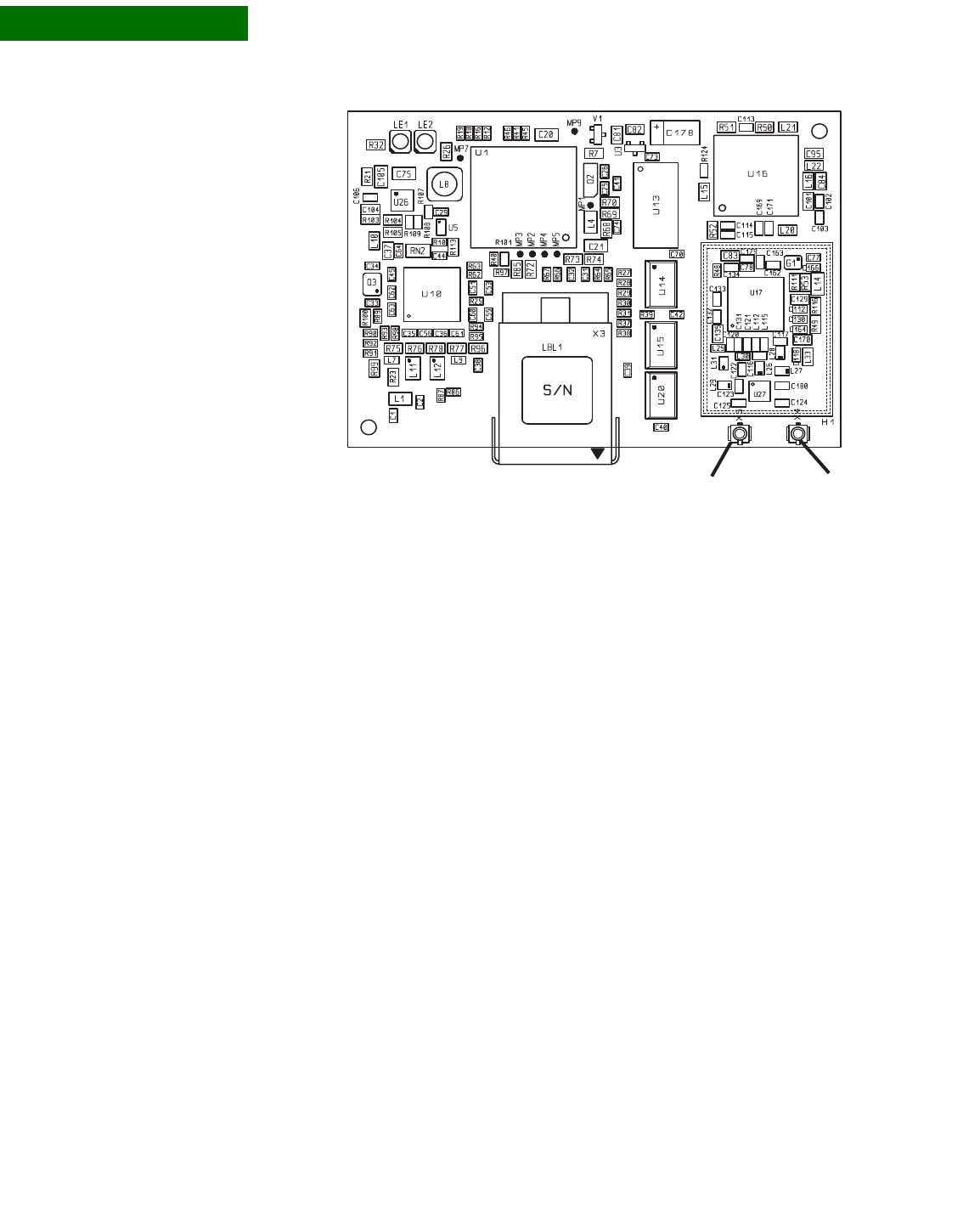
38 ConnectCore 9P 9215 and Wi-9P 9215 Hardware Reference
Chapter 1
Antenna
For the ConnectCore Wi-9P 9215, connect antenna to the primary connector and
secondary connector.
Note: When disconnecting U.FL connectors, the use of U.FL plug extraction tool
(Hirose P/N U.FL-LP-N-2 or U.FL-LP(V)-N-2) is strongly recommended to avoid
damage to the U.FL connectors on the ConnectCore Wi-9P 9215 module.
To mate U.FL connectors, the mating axes of both connectors must be aligned. The
"click" will confirm fully mated connection.
Do not attempt insertion at an extreme angle.
. . . . . . . . . . . . . . . . . . . . . . . . . . . . . . . . . . . . . . . . . . . . . . . . . . . . . . . . . . . . . . . . . . . . . . . . . . . . . . . . . .
Power
Power supply The module has +3.3V and VLIO supply pins.
VLIO can be connected either to a Li-Ion battery (2.5V - 5.5V) in a mobile application,
or it can be connected directly to +3.3V. Connecting VLIO to a battery causes
efficiency to be gained without an additional voltage regulator.
Internal voltage The internal 1.8V core voltage is generated through a high-efficiency synchronous
step-down converter, which uses VLIO as input voltage. The core voltage regulator
can provide up to 600mA.
Primary
Secondary

39
About the Development Board
CHAPTER 2
The ConnectCore 9P 9215 Development board supports the ConnectCore 9P 9215
and Wi-9P 9215 modules. This chapter describes the components of the
development board and explains how to configure the board for your requirements.
The development board has two 4x20 pin connectors that are 1:1 copies of the
module pins.
What’s on the
development
board?
RJ-45 Ethernet connector
2 x RP-SMA antenna connectors.
–Connection to module via U.FL connectors
Four serial interface connectors:
–1 x UART B MEI (RS232/RS4xx) with status LEDs on SUB-D 9-pin connector
(X6)
–1 x UART D RS232 with status LEDs, on SUB-D 9-pin connector (X3)
–1 x UART C with TTL levels shared with HDLC signals on 10-pin header (X5)
–1 x UART A with TTL levels shared with SPI signals on 10-pin header (X4)
ADC, SPI, and I2C headers
JTAG connector
Peripheral application header
–Including access to 16-bit data/10-bit address bus signals
Headers with 1:1 copies of the module pins (X1/X2)
Two user pushbuttons, two user LEDs, wake-up button
Eight-position configuration dip switches
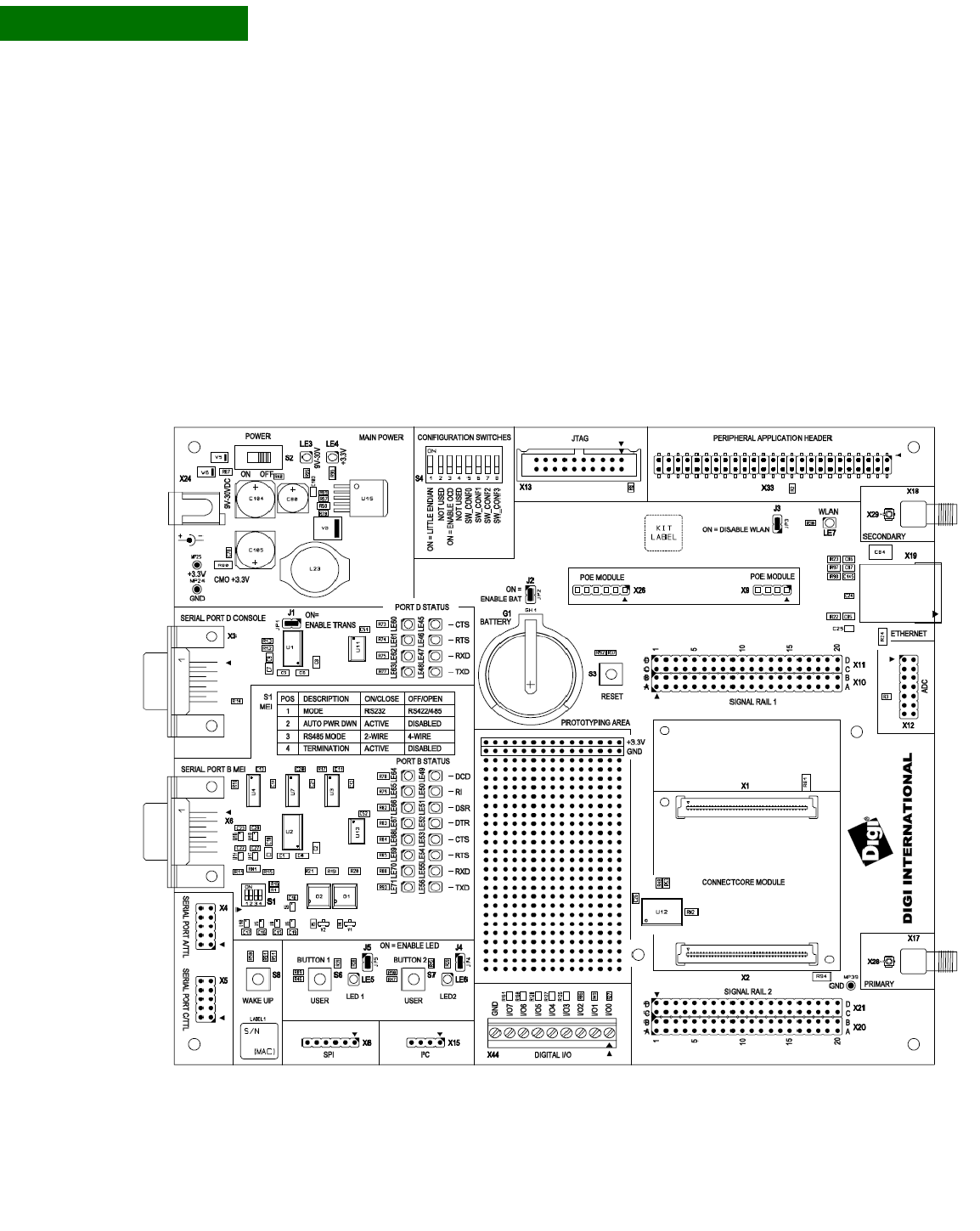
40 ConnectCore 9P 9215 and Wi-9P 9215 Hardware Reference
Chapter 2
Four each for hardware/software configuration
–GPIO screw-flange connector
–+9/30VDC power supply
Current measurement option
–Development board + module, and module alone
–3.3V coincell battery with socket
–PoE connectors for optional application kit (IEEE 802.3af)
–Prototyping area (15 x 28 holes) with +3.3V and GND connections
The development
board

. . . . .
www.digiembedded.com 41
. . . . . . . . . . . . . . . . . . . . . . . . . . . . . . . . . . . . . . . . . . . . . . . . . . . . . . . . . . . . . . . . . . . . . . . . . . . . . . . . . .
User interface
The ConnectCore 9P 9215 Development board implements two user buttons and two
user LEDs in addition to those provided on the module.
The user LEDs on the development board can be enabled or disabled by correctly
setting jumper J5&6.
The table below shows which NS9215 GPIO is available for implementing the user
interface.
. . . . . . . . . . . . . . . . . . . . . . . . . . . . . . . . . . . . . . . . . . . . . . . . . . . . . . . . . . . . . . . . . . . . . . . . . . . . . . . . . .
General information
The module uses the same antennas to transmit and receive the 802.11b/g RF
signal. An antenna switch is required to isolate the transmit signal from the receive
signal. The antenna switch works by alternately connecting the antennas to either
the transceiver PA transmit output or the transceiver receive input. To support this
antenna sharing scheme, the module operates in half-duplex mode; receive and
transmit operations do not occur at the same time.
Antenna switch The antenna switch is a digitally controlled 2.4 GHz, 50 ohm, multi-function solid
state switch, controlled by software.
The receive port can be switched between antenna 1 or antenna 2.
The transmit port can be switched between antenna 1 or antenna 2.
The switch can handle >28dBm of signal on the transmit port. The insertion loss of
the antenna switch is <0.5dB and the receive to transmit port isolation is >23dB.
Signal name GPIO used Comments
USER_BUTTON1 GPIO81 10k pull-up to +3.3V on the
development board
USER_LED1# GPIO82
USER_BUTTON2 GPIO84 10k pull-up to +3.3V on the
development board
USER_LED2# GPIO85
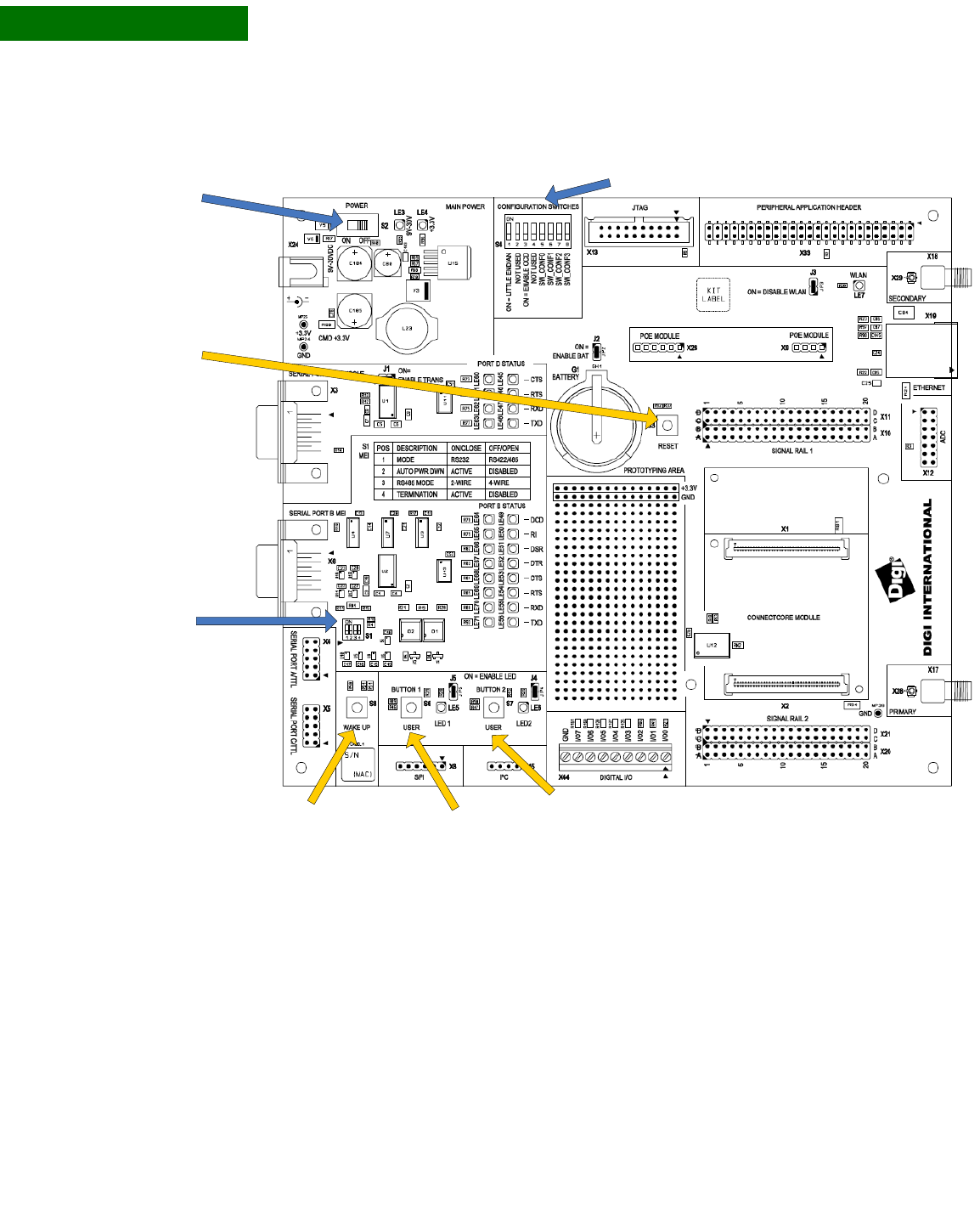
42 ConnectCore 9P 9215 and Wi-9P 9215 Hardware Reference
Chapter 2
. . . . . . . . . . . . . . . . . . . . . . . . . . . . . . . . . . . . . . . . . . . . . . . . . . . . . . . . . . . . . . . . . . . . . . . . . . . . . . . . . .
Switches and pushbuttons
Reset control, S3 The reset pushbutton, S3, resets the module. On the module, RSTOUT# and
PWRGOOD are produced for peripherals. A pushbutton allows manual reset by
connecting RSTIN# to ground. The reset controller is located on the ConnectCore 9P
9215 and Wi-9P 9215 modules.
Power switch, S2 The development board has an ON/OFF switch, S2. The power switch S2 can switch
both 9V-30V input power supply and 12V coming out of the PoE module. However, if
a power plug is connected in the DC power jack, the PoE module is disabled.
Power Switch, S2 Configuration switch, S4
Reset button
S3
Serial Port B
(MEI)
configuration
switch S1
Wake Up button
S8
User Button 1
S6
User Button 2
S7

. . . . .
www.digiembedded.com 43
User pushbuttons,
S6 and S7
Use the user pushbuttons to interact with the applications running on the
ConnectCore 9P 9215 and Wi-9P 9215 modules. Use these module signals to
implement the pushbuttons:
Legend for multi-
pin switches
Switches 1 and 4 are multi-pin switches. In the description tables for these
switches, the pin is designated as S[switch number].[pin number]. For example, pin
1 in switch 4 is specified as S4.1.
Module
configuration
switches, S4
Use S4 to configure the module:
Wake-up button,
S8
The wake-up pushbutton, S8, generates an external interrupt to the module's
NS9215 processor using the EIRQ2 signal.
Serial Port B MEI
configuration
switches, S1
Use S1 to configure the line interface for serial port B MEI:
Signal name Switch
(pushbutton)
GPIO used
USER_PUSH_BUTTON_1 S6 GPIO81
USER_PUSH_BUTTON_2 S7 GPIO84
Switch pin Function
S4.1 On = Little endian
Off = Big endian
S4.2 Not used
S4.3 On = ARM Debug
Off = Boundary Scan
S4.4 Not used
S4.5 – S4.8 Not defined. Software configuration signals, which can be available for user
specific configuration.

44 ConnectCore 9P 9215 and Wi-9P 9215 Hardware Reference
Chapter 2
Switch pin Function Comments
S1.1 On = RS232 transceiver enabled
RS422/RS485 transceivers disabled
Off = RS232 transceiver disabled
RS422/RS485 transceivers enabled
S1.2 On = Auto Power Down enabled
Off = Auto Power Down disabled
Auto Power Down is not supported on
this board. This signal is only
accessible to permit the user to
completely disabled the MEI interface
for using the signals for other
purposes. To disable the MEI
interface, go in RS232 mode (S1.1 =
ON) and activate the Auto Power
Down feature (S1.2 = ON) - be sure
that no cable is connected to connector
X3.
S1.3 On = 2-wire interface (RS422/RS485)
Off = 4-wire interface (RS422)
S1.4 On = Termination on
Off = No termination
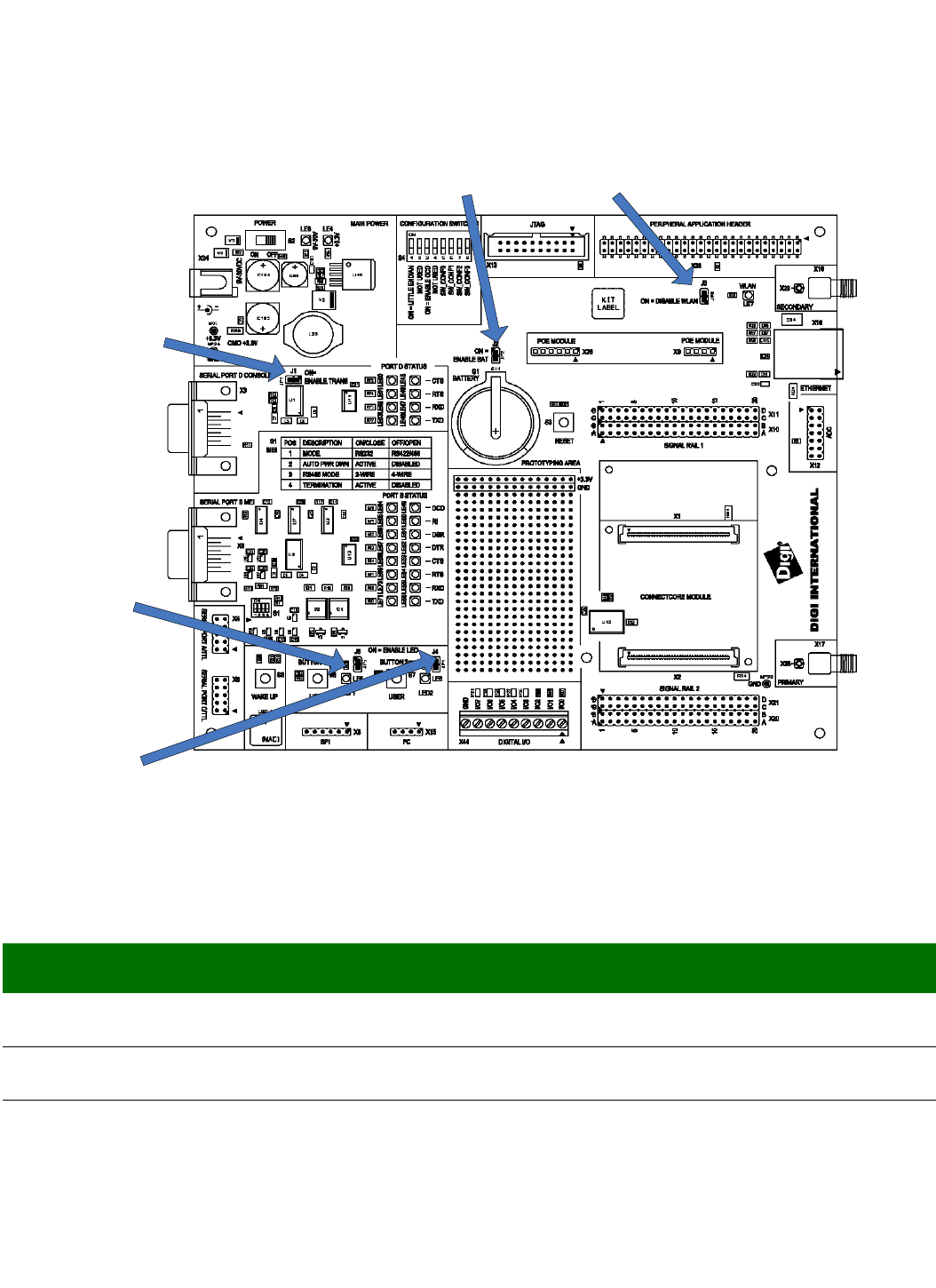
. . . . .
www.digiembedded.com 45
. . . . . . . . . . . . . . . . . . . . . . . . . . . . . . . . . . . . . . . . . . . . . . . . . . . . . . . . . . . . . . . . . . . . . . . . . . . . . . . . . .
Jumpers
Jumper functions
Battery Jumper J2
Serial Port D
transceiver
Jumper J1
User LED1
Jumper J5
User LED2
Jumper J4
WLAN Jumper J3
Jump
er
Name If connection made Default
J1 Enable transceiver This jumper allows to disable the console RS232 transceiver. Connection made =
console active
J2 Battery enable Supplies the real time clock with 3V from the battery (lithium coin cell battery,
G1) even if the board is switched off. This is for keeping time in the RTC.
Connection not made =
Backup battery disabled
J3 WLAN_DISABLE# Disables the WiFi unit on the module. Connection made =
WLAN disabled
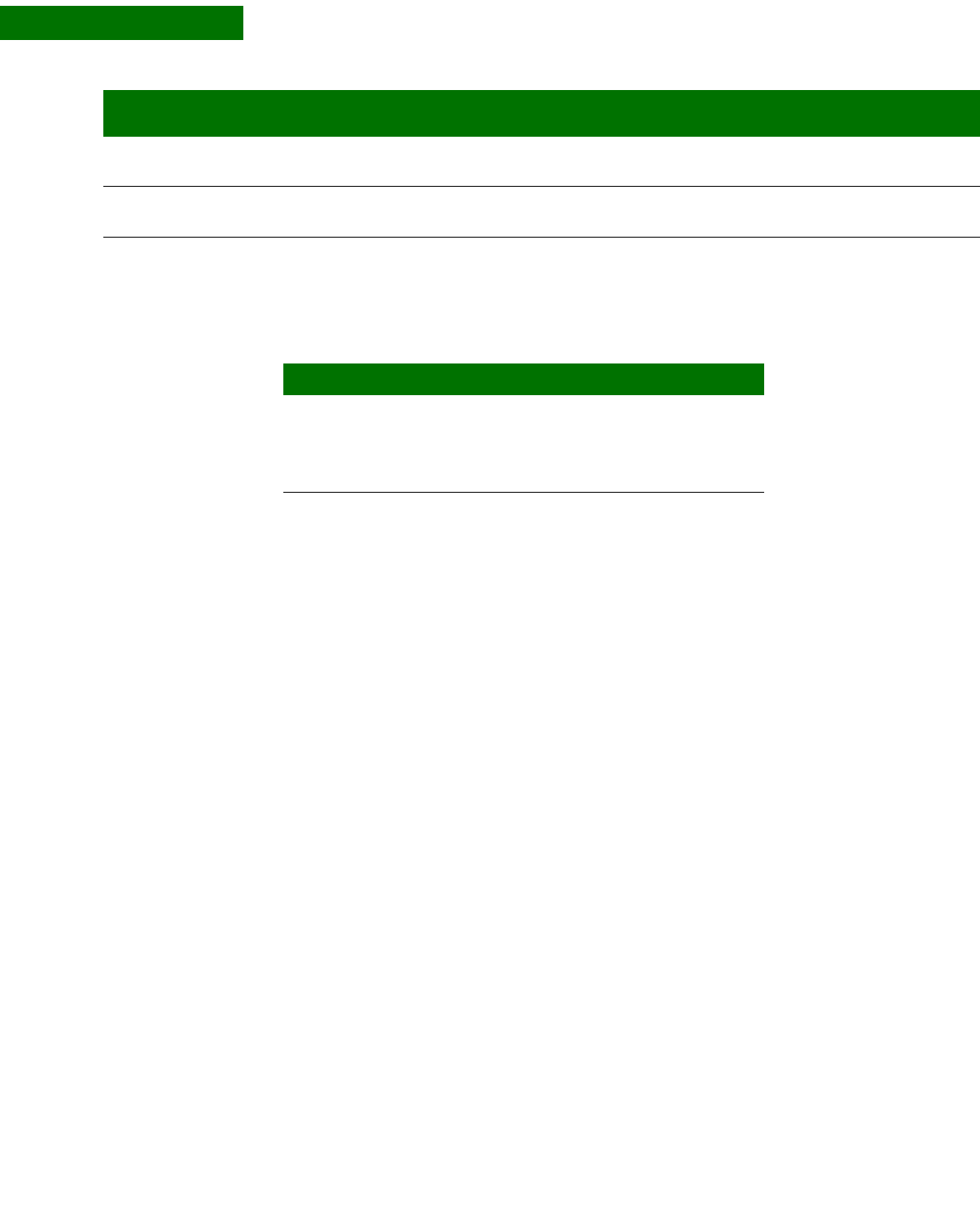
46 ConnectCore 9P 9215 and Wi-9P 9215 Hardware Reference
Chapter 2
. . . . . . . . . . . . . . . . . . . . . . . . . . . . . . . . . . . . . . . . . . . . . . . . . . . . . . . . . . . . . . . . . . . . . . . . . . . . . . . . . .
Battery and Battery Holder
J4 USER_LED2# Enables User LED2 (LE6) to show the status of this signal (lit if low). Connection made = User
LED2 enabled
J5 USER_LED1# Enables User LED1 (LE5) to show the status of this signal (lit if low). Connection made = User
LED1 enabled
Jump
er
Name If connection made Default
Battery Holder Battery
Coin-Cell Holder for CR2477 Battery,
THT
Keystone 1025-7
Ettinger 15.61.252
Lithium coin cell, CR2477, 24mm,
950mAh
Panasonic CR2477
Renata CR2477N
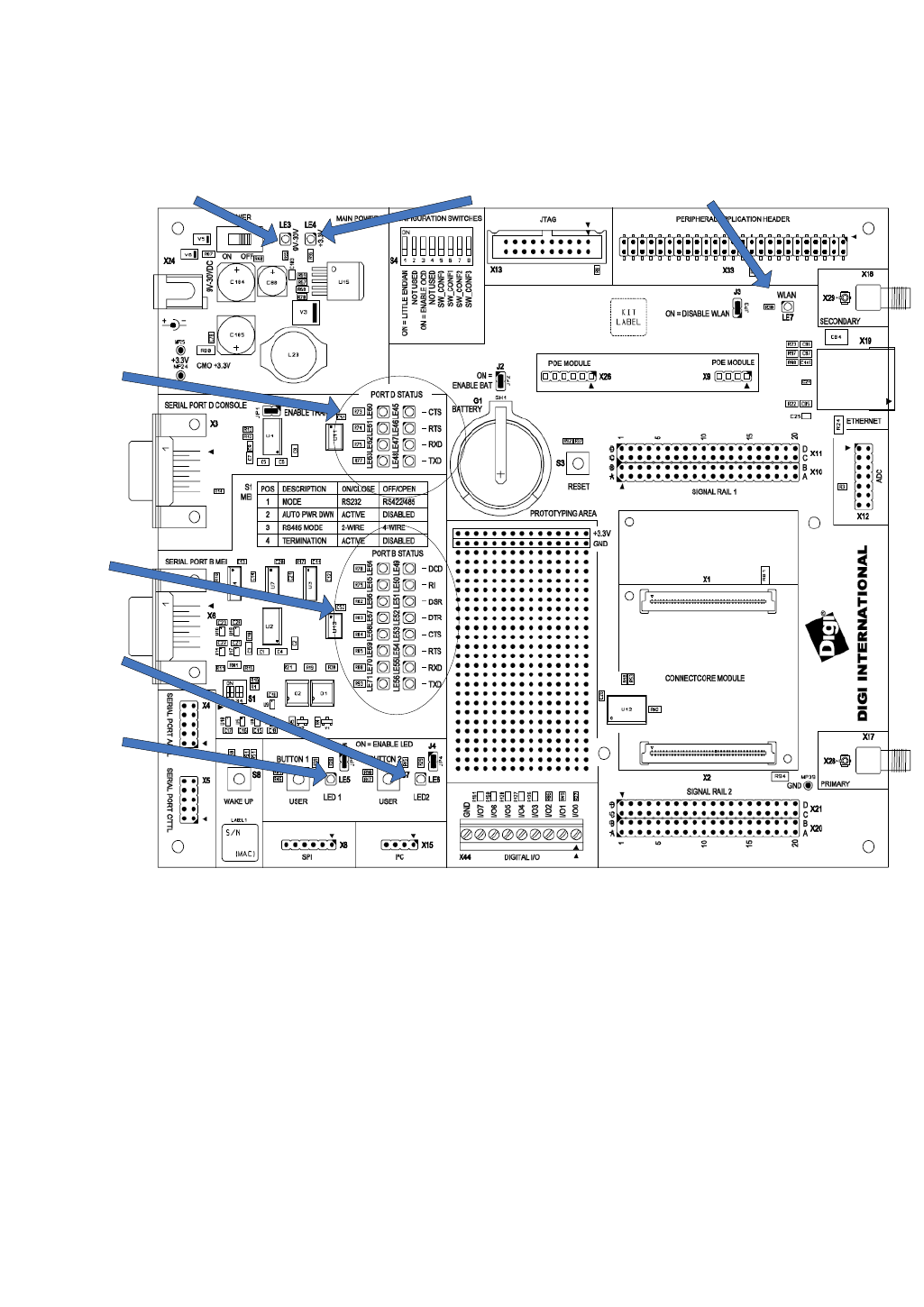
. . . . .
www.digiembedded.com 47
. . . . . . . . . . . . . . . . . . . . . . . . . . . . . . . . . . . . . . . . . . . . . . . . . . . . . . . . . . . . . . . . . . . . . . . . . . . . . . . . . .
LEDs
WLAN LED LE7 LED indicating WLAN activity.
Power LEDs, LE3
and LE4
The power LEDs are all red LEDs. These power supplies must be present and cannot
be switched.
LE3 ON indicates the +9VDC / +30VDC power is present.
LE4 ON indicates the +3.3VDC power is present.
User LEDs, LE5
and LE6
The user LEDs are controlled through applications running on the ConnectCore 9P
9215 and Wi-9P 9215 modul, if J5 and J4 are set. Use these module signals to
implement the LEDs:
Power LED +3.3V, LE4Power LED 9-30V, LE3 WLAN LED LE7
Serial Port D
status LEDs
Serial Port B
status (MEI)
LEDs
User LED2,
LE6
User LED1,
LE5
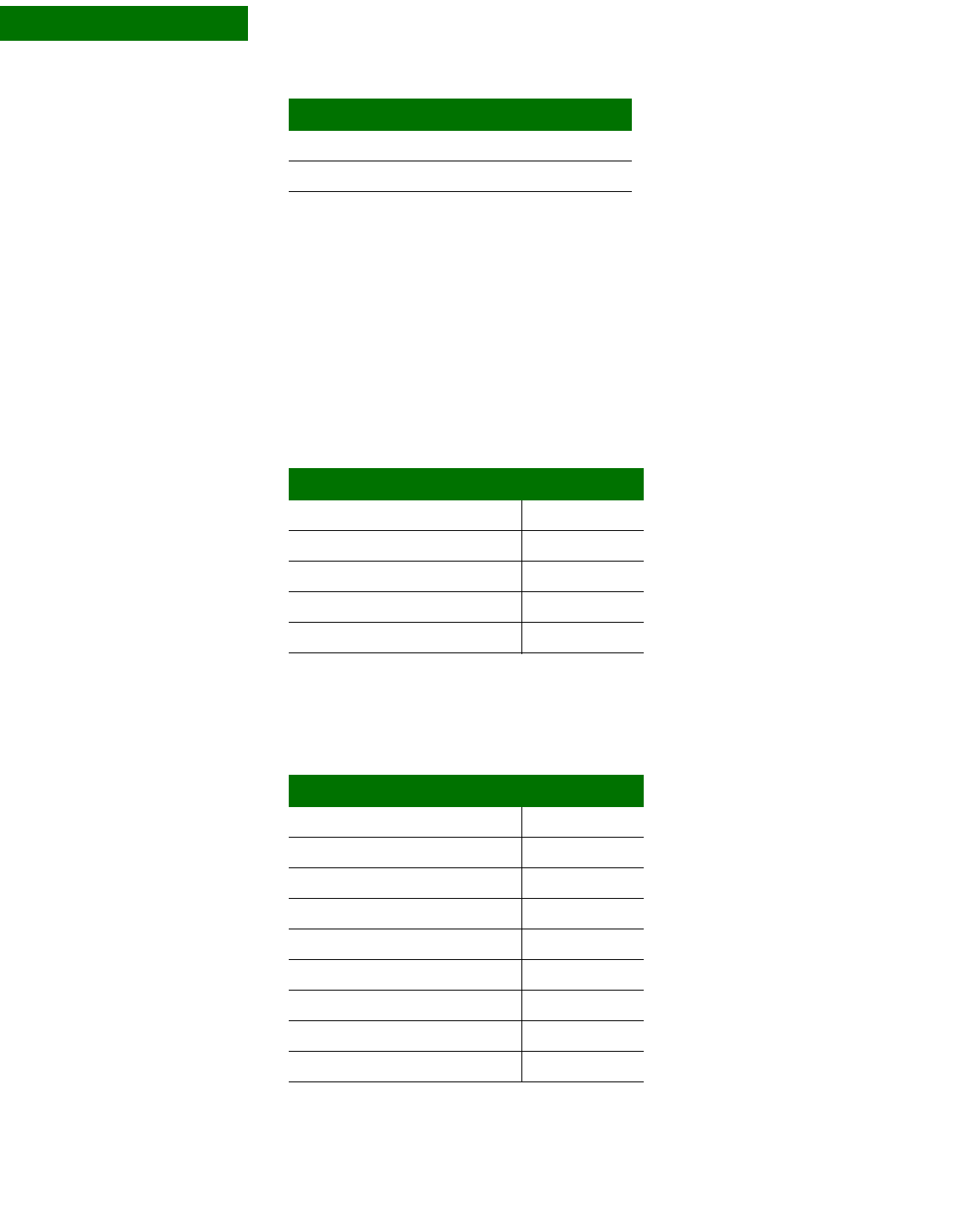
48 ConnectCore 9P 9215 and Wi-9P 9215 Hardware Reference
Chapter 2
Serial status
LEDs
The development board has two sets of serial port LEDs — four for serial port D and
eight for serial port B. The LEDs are connected to the TTL side of the RS232 or
RS422/485 transceivers.
Green means corresponding signal high.
Red means corresponding signal low.
The intensity and color of the LED will change when the voltage is switching.
Status LEDs
Serial Port D
LEDs
Status LEDs
Serial Port B
LEDs
Signal name LED GPIO used
USER_LED1# LE5 GPIO82
USER_LED2# LE6 GPIO85
LED reference Function
RED GREEN
LE60 LE45 CTSD#/GPIO60
LE61 LE46 RTSD#/GPIO64
LE62 LE47 RXDD/GPIO62
LE63 LE48 TXDD/GPIO66
LED reference Function
RED GREEN
LE64 LE49 DCDB#/GPIO51
LE65 LE50 RIB#/GPIO55
LE66 LE51 DSRB#/GPIO53
LE67 LE52 DTRB#/GPIO57
LE68 LE53 CTSB#/GPIO52
LE69 LE54 RTSB#/GPIO56
LE70 LE55 RXDB/GPIO54
LE71 LE56 TXDB/GPIO58
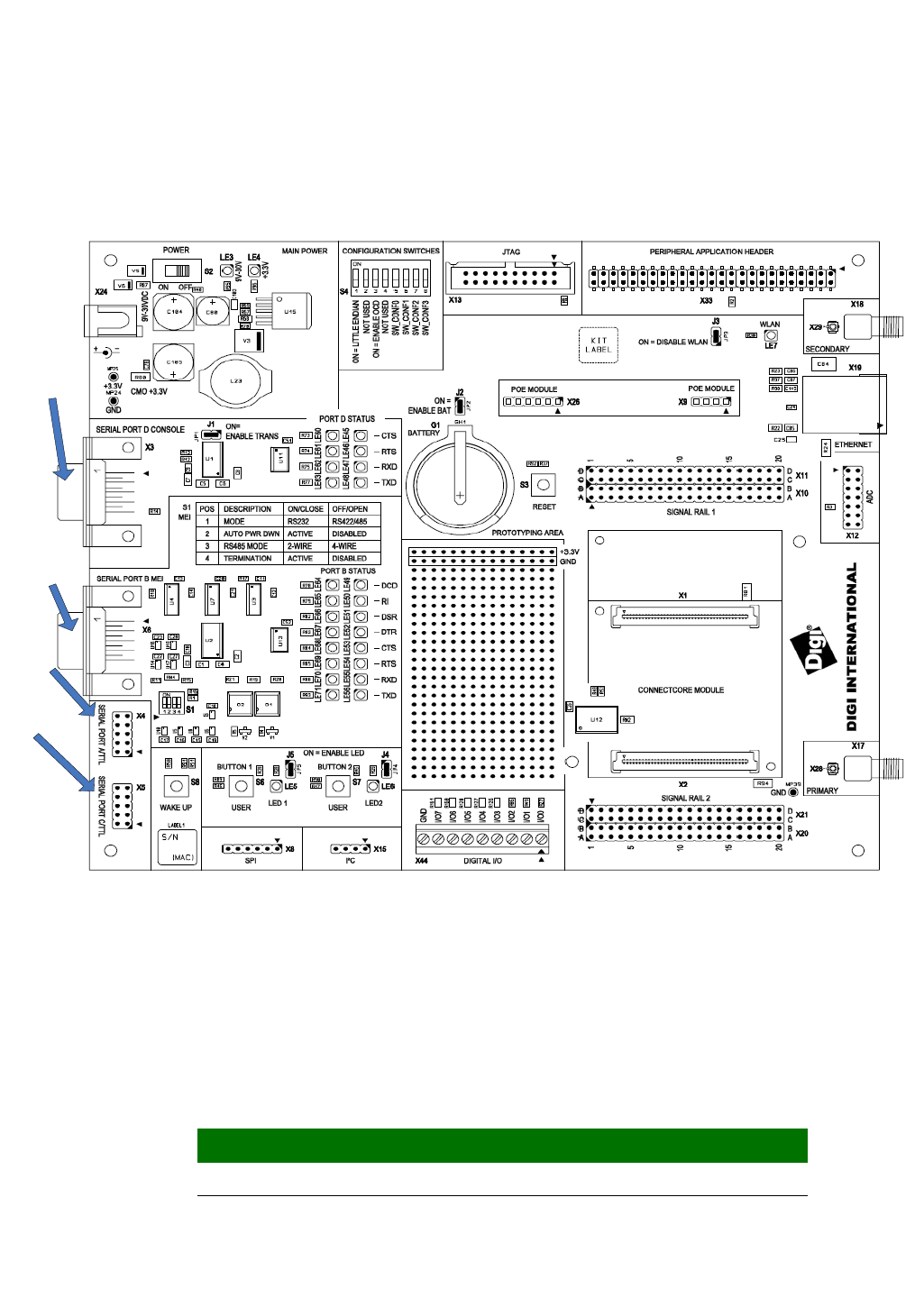
. . . . .
www.digiembedded.com 49
. . . . . . . . . . . . . . . . . . . . . . . . . . . . . . . . . . . . . . . . . . . . . . . . . . . . . . . . . . . . . . . . . . . . . . . . . . . . . . . . . .
Serial UART ports
The development board supports the four serial ports available on the ConnectCore
9P 9215 and Wi-9P 9215 modules.
Serial port D,
RS232
The serial (UART) port D connector, X3, is a DSUB9 male connector and is also used as
the standard console. This asynchronous serial port is DTE and requires a null-modem
cable to connect to a computer serial port.
The serial port D interface corresponds to NS9215 UART port D. The line driver is
enabled or disabled using the jumper J1.
Serial port D pins are allocated as shown:
Serial
Port D
(RS232),
X3
Serial
Port B
(MEI) X6
Serial
Port A
TTL X4
Serial
Port C
TTL, X5
Pin Function Defaults to
1 DCD# GPIO59
2 RXD GPIO62

50 ConnectCore 9P 9215 and Wi-9P 9215 Hardware Reference
Chapter 2
By default, Serial D signals are configured to their respective GPIO signals.
It isthe responsibility of the driver to configure them properly.
Serial port A TTL
interface
The serial (UART) port A interface is a TTL interface connected to a 2x5 pin, 0.1”
connector, X4. The connector supports only TTL level.
The serial port A interface corresponds to NS9215 UART port A.
Serial port A pins are allocated as shown:
By default, Serial A signals are configured to their respective GPIO signals. It is the
responsibility of the driver to configure them properly.
Serial Port A must not be connected if SPI or WakeUp functionality is used.
Serial port C TTL
interface
The serial (UART) port C interface is a TTL interface connected to a 2x5 pin, 0.1”
connector, X5. The connector supports only TTL level.
3 TXD GPIO66
4DTR# GPIO65
5 GND
6 DSR# GPIO61
7RTS# GPIO64
8CTS# GPIO60
9RIB# GPIO63
Pin Function Defaults to
Pin Function Defaults to Comment
1 DCDA#/SPI_EN# GPIO0 Can be programmed as SPI enable to X4
2DSRA# GPIO2
3 RXDA/SPI_RXD GPIO3 Can be programmed as SPI receive data to X4
4 RTSA#/SPI_CLK GPIO5 Can be programmed as SPI clock to X4
5 TXDA/SPI_TXD GPIO7 Can be programmed as SPI transmit data to X4
6 CTSA# GPIO1
7 DTRA# GPIO6
8 RIA#/EIRQ2 GPIO4 This signal is default configured to support the wake-
up button on the development board..
9 GND
10 3.3V

. . . . .
www.digiembedded.com 51
The serial port C interface corresponds to the NS9215 UART port C. The signals are
shared with the HDLC interface.
Serial port C pins are allocated as shown:
Note: By using GPIO12 as RIC#, be sure to populate a series resistor on the
baseboard. This is necessary to avoid conflict between the default configuration of
the GPIO when booting (RESET_DONE / output) and the chosen configuration once
booted (RIC# / input).
By default, Serial C signals are configured to their respective GPIO signals, except
for GPIO12. It is the responsibility of the driver to configure them properly.
Serial port B,
MEI interface
The serial (UART) port B connector, X6, is a DSUB9 male connector. This
asynchronous serial port is DTE and requires a null-modem cable to connect to a
computer serial port.
The serial port B MEI (Multiple Electrical Interface) interface corresponds to NS9215
UART port B. The line drivers are configured using switch S1.
Note that all pins on S1 contribute to the line driver settings for this port.
Serial port B pins are allocated as shown:
Pin Function Defaults to
1 DCDC#/TXCLKC GPIO8.
2 DSRC# GPIO10.
3 RXDC# GPIO11
4 RTSC#/RXCLKC GPIO13
5 TXDC GPIO15
6CTSC# GPIO9
7 DTRC#/TXCLKC GPIO14
8 RIC#/RXCLKC/GPIO 12 RESET_DONE See note
9GND
10 3.3V
Pin RS232
fucntion
RS232
default
RS485
function
RS485
default
1DCD# GPIO51CTS- n/a
2 RXD GPIO54 RX+ GPIO54
3 TXD GPIO58 TX+ GPIO58
4 DTR# GPIO57 RTS- n/a
5 GND GND
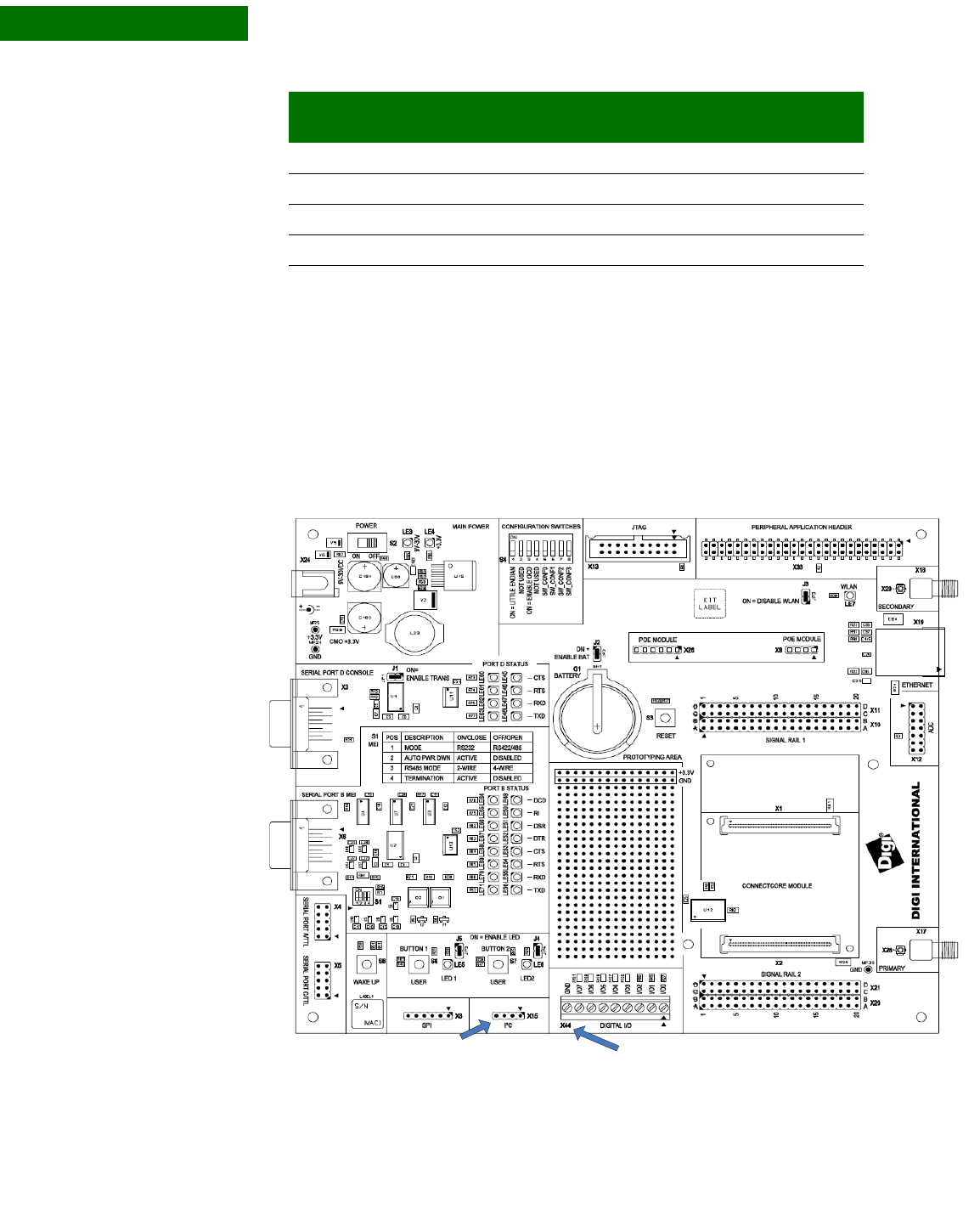
52 ConnectCore 9P 9215 and Wi-9P 9215 Hardware Reference
Chapter 2
By default, Serial B signals are configured to their respective GPIO signals.
It is the responsibility of the driver to configure them properly.
. . . . . . . . . . . . . . . . . . . . . . . . . . . . . . . . . . . . . . . . . . . . . . . . . . . . . . . . . . . . . . . . . . . . . . . . . . . . . . . . . .
I2C interface
6 DSR# GPIO53 RX- n/a
7 RTS# GPIO56 RTS+ GPIO56
8 CTS# GPIO52 CTS+ GPIO52
9RI# GPIO55TX- n/a
Pin RS232
fucntion
RS232
default
RS485
function
RS485
default
I2C digital I/Os, X44I2C header, X15

. . . . .
www.digiembedded.com 53
I2C header The I²C interface has only one device connected to the bus on the development
board - an I/O expander (see next paragraph). Otherwise, additional I²C devices
(like EEPROMs) can be connected to the module by using I²C header X15. The
pinning of this header is provided below.
I2C digital I/O
expansion
The development board provides a 3.81mm (1.50") green terminal block, X44, for
additional digital I/Os. The I2C I/O port chip is on-chip ESD-protected, 5V tolerant,
and provides an open drain interrupt output.
The I/O expander is a Philips PCA9554D at I2C address 0x20 / 0x21. The pins are
allocated as shown:
Pin Signal
1 I2C_SDA/GPIO103
2 +3.3V
3 I2C_SCL/GPIO102
4GND
Pin Signal
1IO_0
2IO_1
3IO_2
4IO_3
5IO_4
6IO_5
7IO_6
8IO_7
9GND
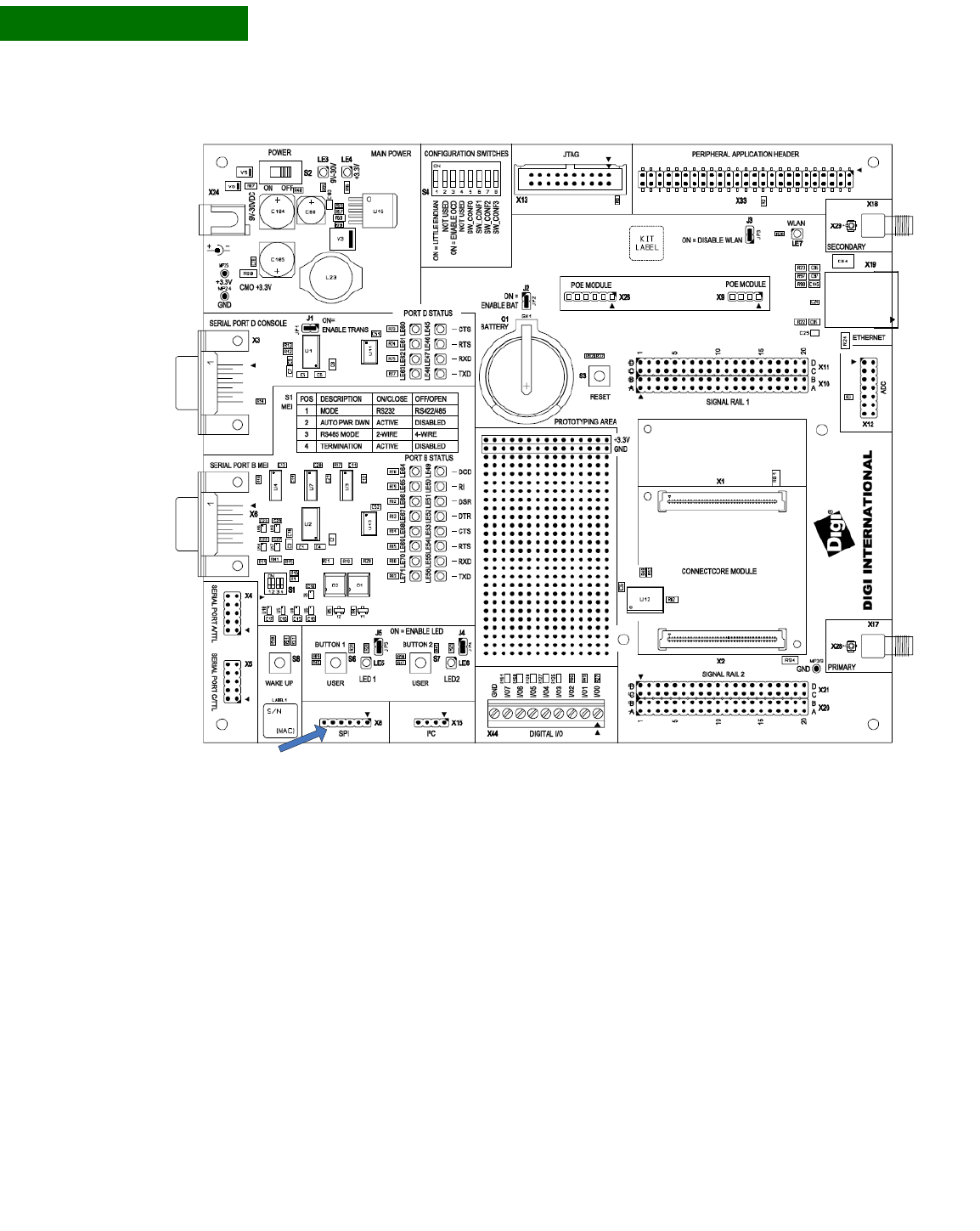
54 ConnectCore 9P 9215 and Wi-9P 9215 Hardware Reference
Chapter 2
. . . . . . . . . . . . . . . . . . . . . . . . . . . . . . . . . . . . . . . . . . . . . . . . . . . . . . . . . . . . . . . . . . . . . . . . . . . . . . . . . .
SPI interface
The development board provides access to the SPI interface on the module using
the SPI connector, X8. The SPI interface on the development board is shared with
UART_A (NS9215 port A). Because the module’s SPI interface is shared with a UART
interface, you cannot use both simultaneously.
Note: The default configuration of UART port A is to support GPIOs. To move from
GPIO to UART or SPI, you need to configure the software properly.
SPI header, X8

. . . . .
www.digiembedded.com 55
Pin allocation SPI connector pins are allocated as shown:
. . . . . . . . . . . . . . . . . . . . . . . . . . . . . . . . . . . . . . . . . . . . . . . . . . . . . . . . . . . . . . . . . . . . . . . . . . . . . . . . . .
Current Measurement Option
The Current Measurement Option uses 0.025R ohm series resistors to measure the
current. The ConnectCore 9P 9215 Development board allows to measure:
the current used by the development board and module (through R80), and
the current used by the internal NS9215 1.8V core generated from VLIO using a
high-efficiency synchronous step-down converter (through R81)
Pin Signal
1 +3.3V
2 TXDA/SPI_TXD/GPIO7
3 RXDA/SPI_RXD/GPIO3
4 RTSA#/SPI_CLK/GPIO5
5 DCDA#/SPI_EN#/GPIO0
6GND
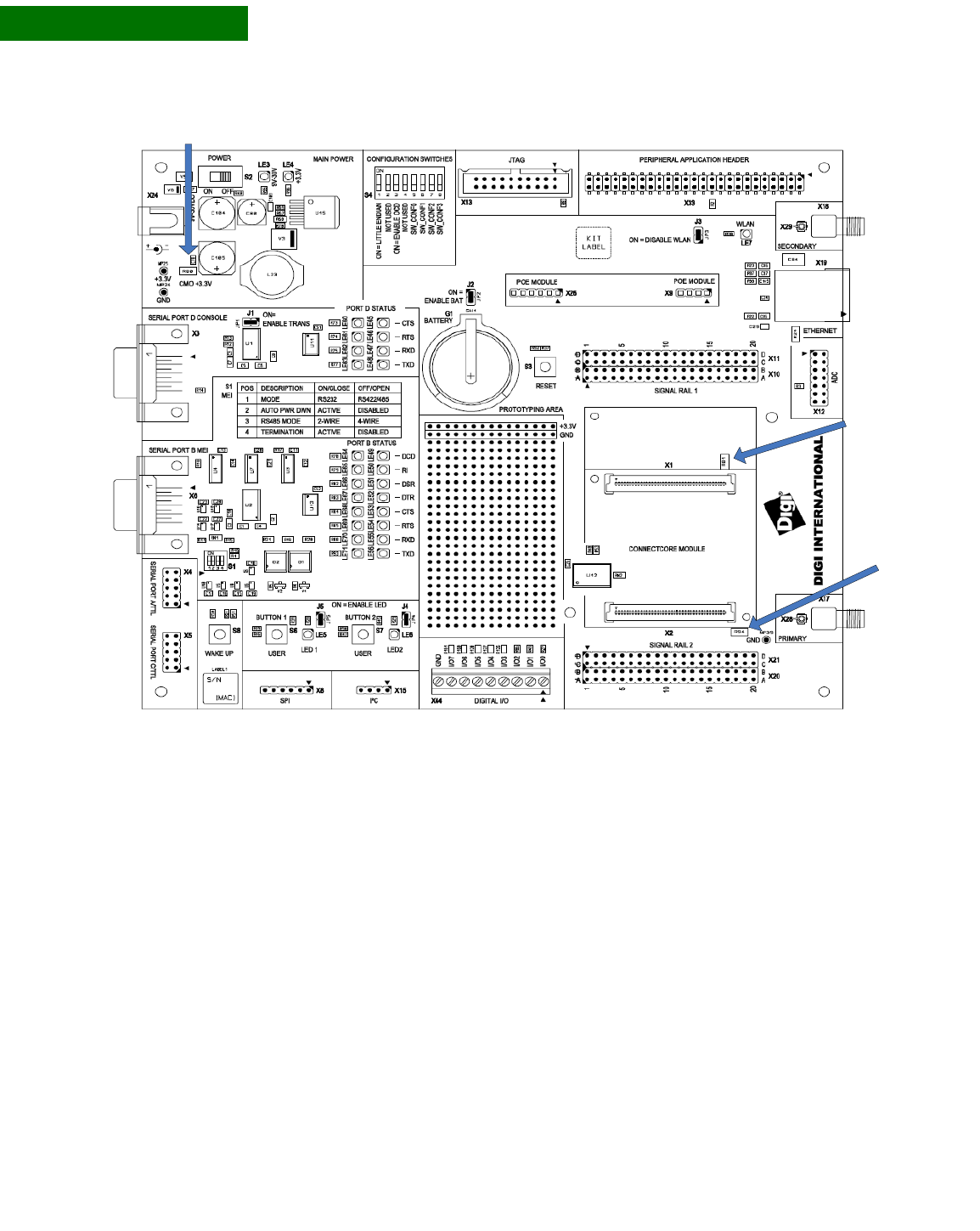
56 ConnectCore 9P 9215 and Wi-9P 9215 Hardware Reference
Chapter 2
How the CMO
works
To measure the load current used on different power supplies, measure DC voltage
across the sense (CMO) resistor. The value of the resistor is 0.025R ± 1%. Calculate
the current using this equation: I = U/R
where
I = current in Amps
U = measured voltage in Volts
R = 0.025 Ohms
Current Measurement Option (CMO) +3.3V development board and
module, R80
Current
Measurement
Option (CMO)
+3.3V VLIO
for 1.8V core,
module only,
R81
Current
Measurement
Option (CMO)
+3.3V for
module only
R94
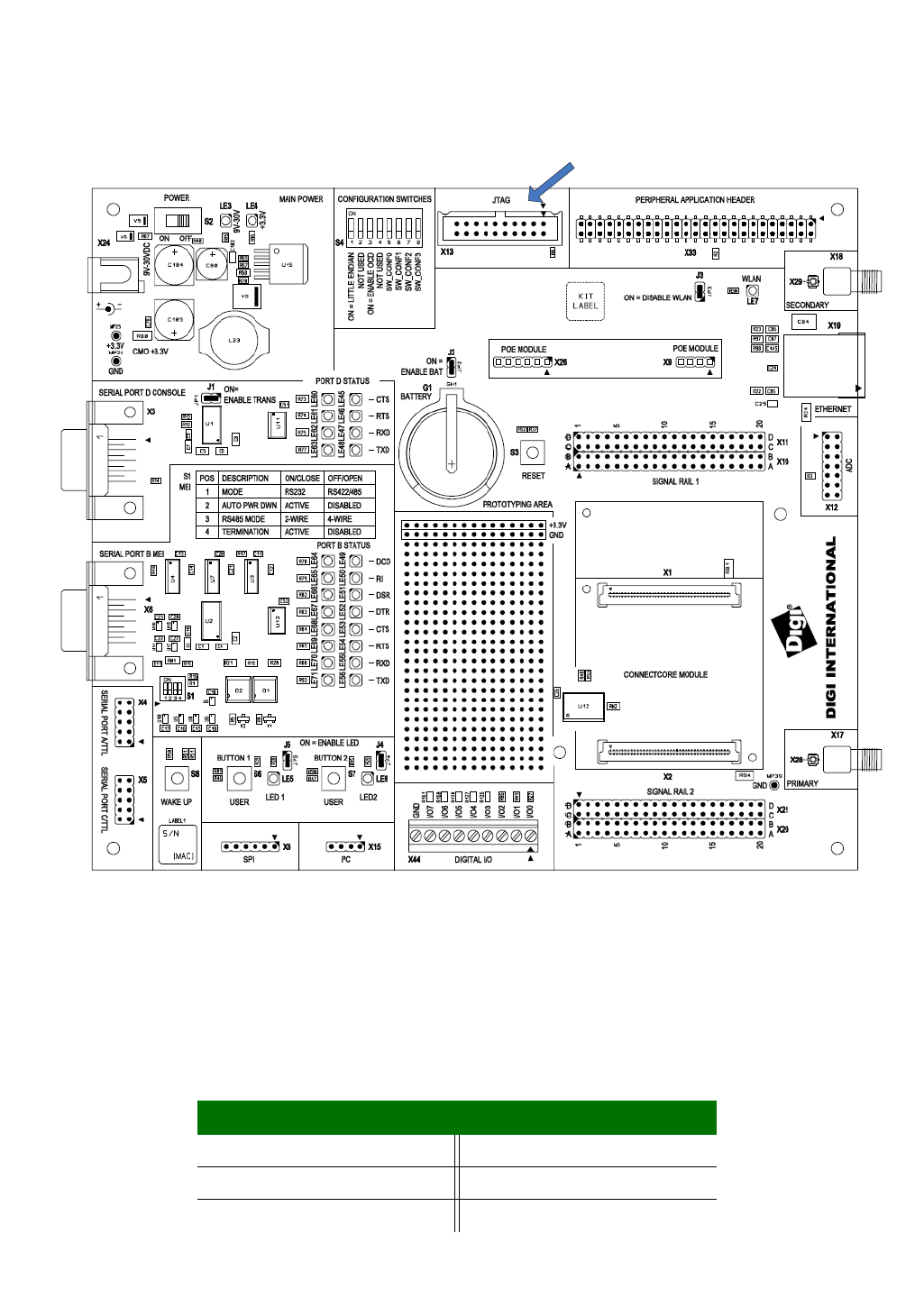
. . . . .
www.digiembedded.com 57
. . . . . . . . . . . . . . . . . . . . . . . . . . . . . . . . . . . . . . . . . . . . . . . . . . . . . . . . . . . . . . . . . . . . . . . . . . . . . . . . . .
JTAG interface
Standard JTAG
ARM connector,
X13
The standard JTAG ARM connector is a 20-pin header and can be used to connect
development tools such as Digi’s JTAG Link, ARM’s Multi-ICE, Abatron BDI2000, and
others.
JTAG Multi-Ice connector X13
Pin Signal Pin Signal
1 +3.3V 2 +3.3V
3TRST# 4GND
5TDI 6GND
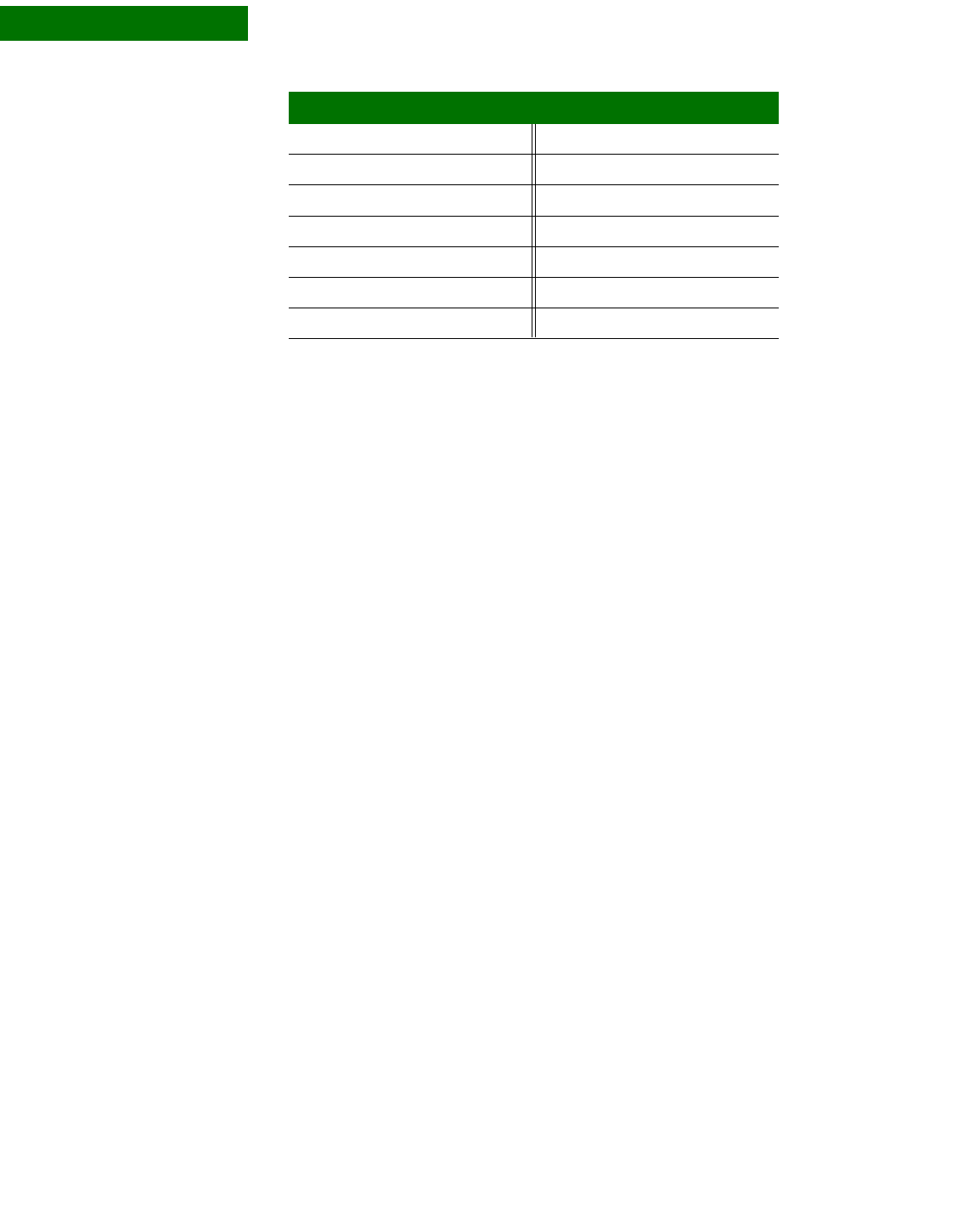
58 ConnectCore 9P 9215 and Wi-9P 9215 Hardware Reference
Chapter 2
. . . . . . . . . . . . . . . . . . . . . . . . . . . . . . . . . . . . . . . . . . . . . . . . . . . . . . . . . . . . . . . . . . . . . . . . . . . . . . . . . .
PoE module connectors - IEEE802.3af
The development board has two PoE module connectors, X9 and X26. The PoE
module is an optional accessory item that can be plugged on the development board
through the two connectors:
X9, input connector: Provides access to the PoE signals coming from the
Ethernet interface.
X26, output connector: Provides the output power supply from the PoE module.
Note: The PoE interface is only available for the ConnectCore 9P 9215 module.
7TMS 8GND
9 TCK 10 GND
11 RTCK (optional) 12 GND
13 TDO 14 GND
15 SRESET# 16 GND
17 No connect 18 GND
19 No connect 20 GND
Pin Signal Pin Signal
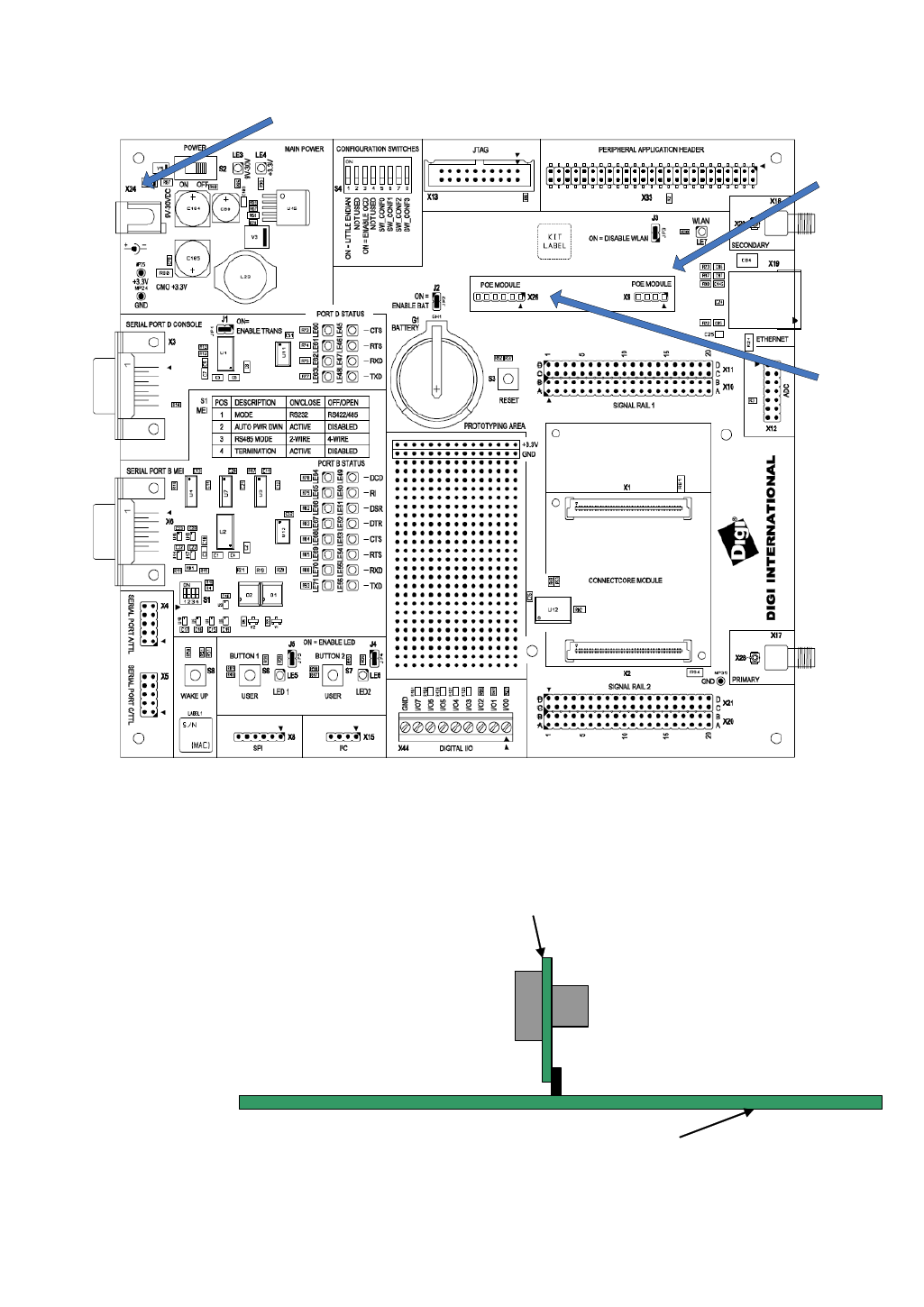
. . . . .
www.digiembedded.com 59
The PoE module Plug in the PoE module at a right angle to the development board, as shown in this
drawing:
PoE header,
X9
PoE header,
X26
Power Jack, X24
Jump Start development board
PoE module
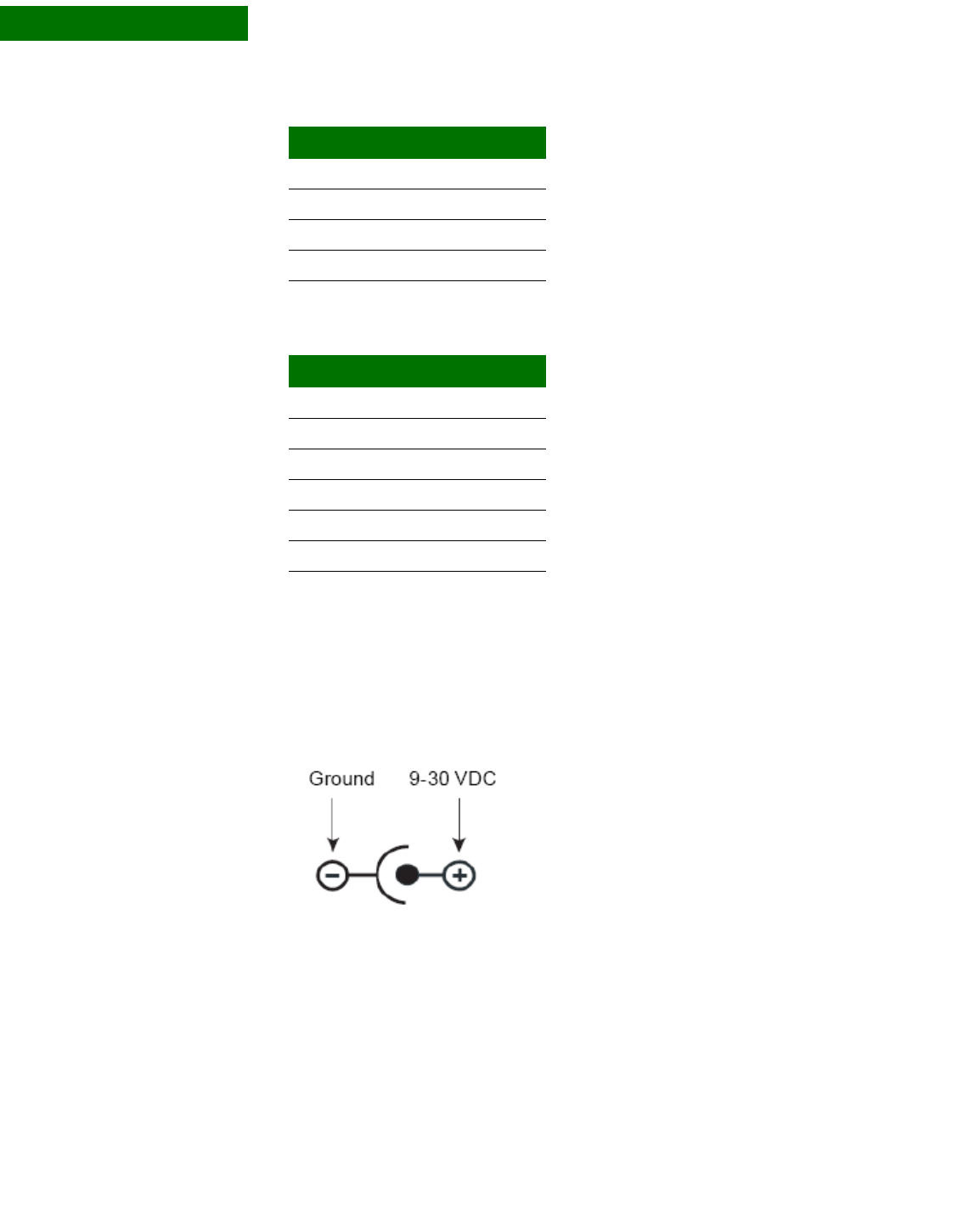
60 ConnectCore 9P 9215 and Wi-9P 9215 Hardware Reference
Chapter 2
X9 This is how the PoE input connector pins are allocated:
X26 This is how the PoE output connector pins are allocated:
POE_GND The development board provides access to POE_GND allowing it to be turned off
when power is provided through Power Jack X26.4 and X26.5.
Power Jack, X24 The power jack is a barrel connector with 9-30VDC operating range. The power jack
is labeled X24 on the development board. This figure schematically represents the
power jack’s polarity.
. . . . . . . . . . . . . . . . . . . . . . . . . . . . . . . . . . . . . . . . . . . . . . . . . . . . . . . . . . . . . . . . . . . . . . . . . . . . . . . . . .
Ethernet interface
The module provides the 10/100 Ethernet PHY chip. The development board
provides the 1:1 transformer and Ethernet connector.
The Ethernet connector is an 8-wire RJ-45 jack, labeled X19, on the development
board. The connector has eight interface pins, as well as two integrated LEDs that
provide link status and network activity information.
Pin Signal
1 POE_TX_CT
2 POE_RX_CT
3 POE_RJ45_4/5
4 POE_RJ45_7/8
Pin Signal
1 +12V_PoE
2 +12V_PoE
3 GND
4 GND
5 PoE_GND
6 PoE_GND
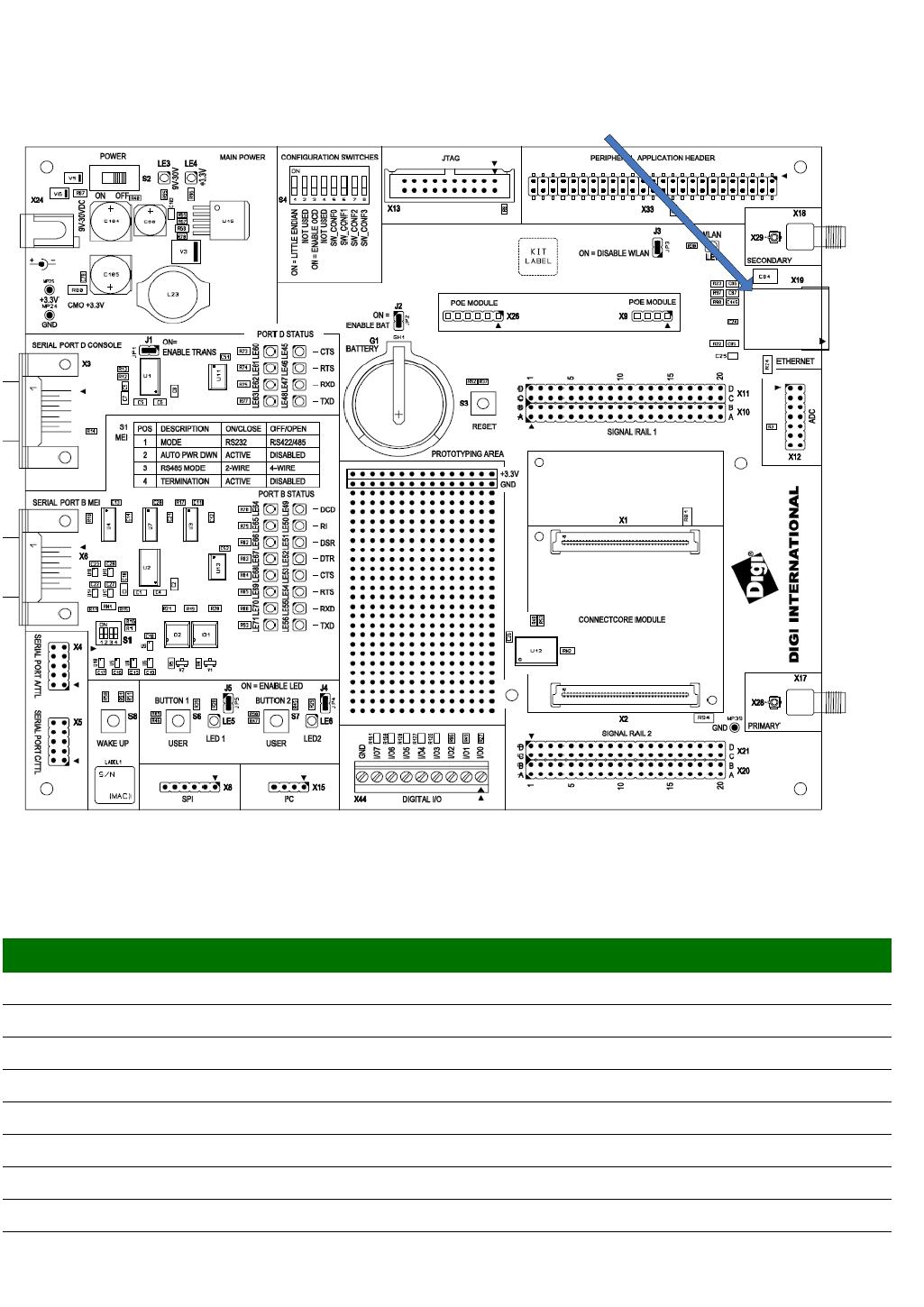
. . . . .
www.digiembedded.com 61
RJ-45 pin
allocation, X19
RJ-45 connector pins are configured as shown:
Ethernet RJ-45, X19
Pin Signal 802.3af End-Span (mode A) 802.3af Mid-Span (Mode B) Description
1 TXD+ Negative VPort Transmit data +
2TXD- Negative V
Port Transmit data -
3 RXD+ Positive VPort Receive data +
4 EPWR+ Positive VPort Power from switch +
5 EPWR+ Positive VPort Power from switch +
6 RXD- Positive VPort Receive data -
7 EPWR- Negative VPort Power from switch -
8 EPWR- Negative VPort Power from switch -
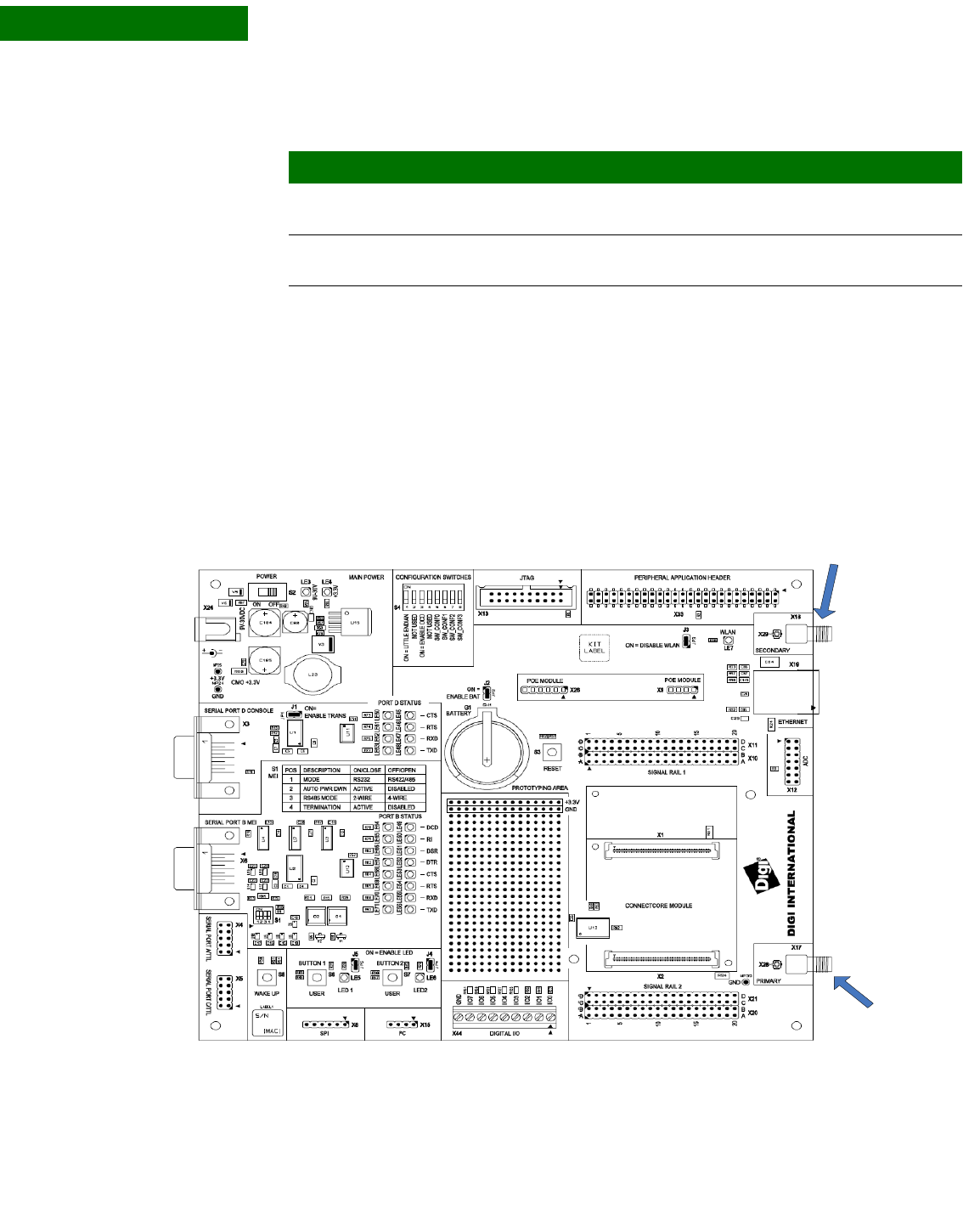
62 ConnectCore 9P 9215 and Wi-9P 9215 Hardware Reference
Chapter 2
LEDs The RJ-45 connector has two LEDs located near the outer lower corners of the
connector. These LEDs are not programmable.
. . . . . . . . . . . . . . . . . . . . . . . . . . . . . . . . . . . . . . . . . . . . . . . . . . . . . . . . . . . . . . . . . . . . . . . . . . . . . . . . . .
WLAN interface
For the ConnectCore Wi-9P 9215, attach the antenna to the primary connector [X17]
and the secondary connector [X18] on the development board. See figure below.
LED Description
Yellow Network activity (speed): Flashing when network traffic detected; Off when no network
traffic detected.
Green Network link: On indicates an active network link; Off indicates that no network link is
present.
Secondary
antenna
connector [X18]
Primary antenna
connector [X17]

. . . . .
www.digiembedded.com 63
. . . . . . . . . . . . . . . . . . . . . . . . . . . . . . . . . . . . . . . . . . . . . . . . . . . . . . . . . . . . . . . . . . . . . . . . . . . . . . . . . .
Peripheral (expansion) headers
The development board provides one, 2x25-pin, 0.10” (2.54mm) pitch header for
supporting application-specific daughter cards/expansion boards:
X33, Peripheral application header. Provides access to an 16-bit data bus, 10-
bit address bus, and control signals (such as CE#, IRQ#, WE#), as well as I2C and
power (+3.3V). Using these signals, you can connect Digi-specific extension
modules or your own daughter card to the module’s address/data bus.
Peripheral
application
header, X33
Peripheral application pins are allocated as shown:
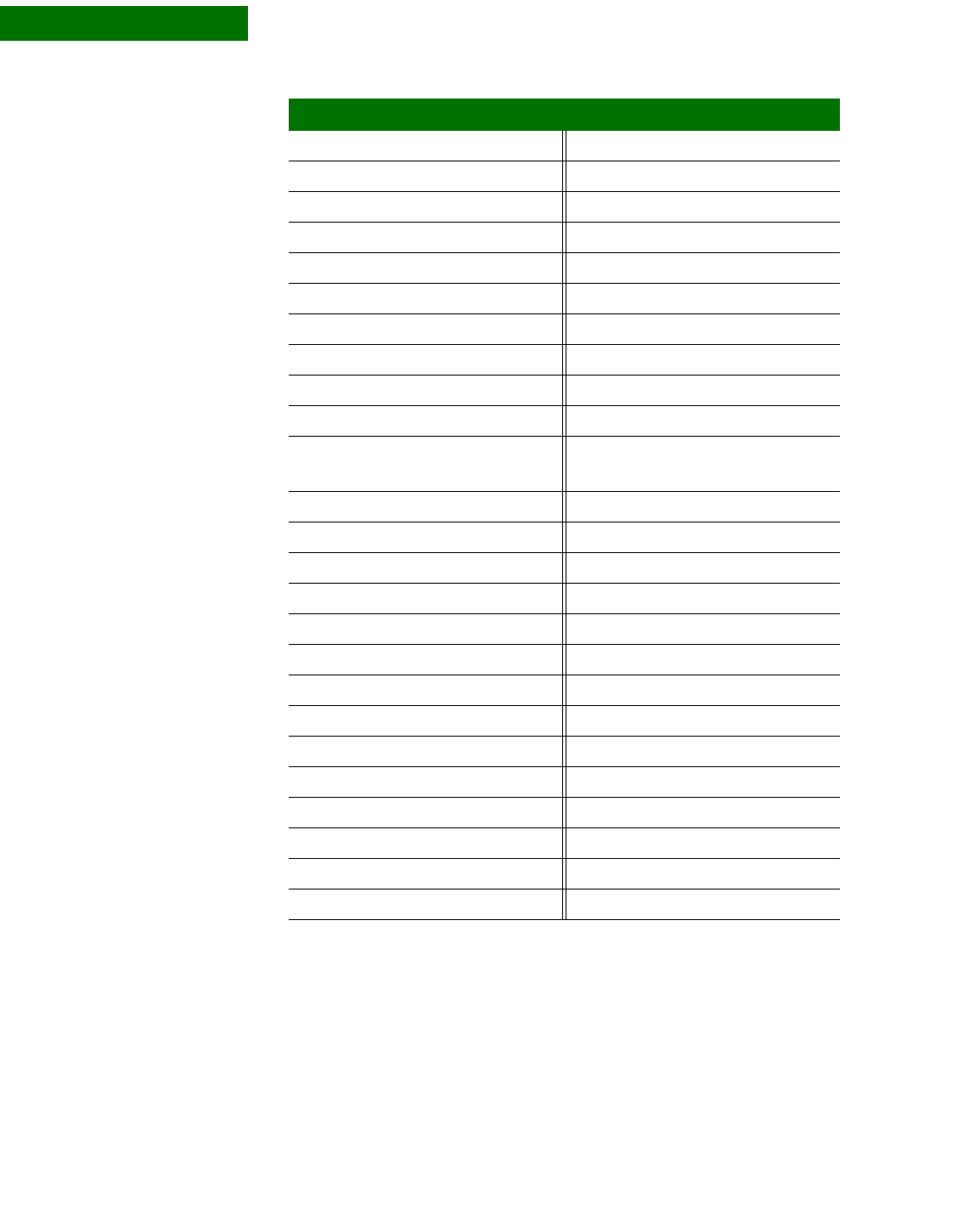
64 ConnectCore 9P 9215 and Wi-9P 9215 Hardware Reference
Chapter 2
. . . . . . . . . . . . . . . . . . . . . . . . . . . . . . . . . . . . . . . . . . . . . . . . . . . . . . . . . . . . . . . . . . . . . . . . . . . . . . . . . .
Module and test connectors
The ConnectCore 9P 9215 and Wi-9P 9215 modules plug into the module connectors
X1 and X2 on the development board.
Pin Signal Pin Signal
1 GND 2 BDO
3BD1 4BD2
5 BD3 6 GND
7BD4 8BD5
9BD6 10BD7
11 GND 12 BD8
13 BD9 14 BD10
15 BD11 16 GND
17 BD12 18 BD13
19 BD14 20 BD15
21 GND 22 * 8-bit / 16-bit#
GND selects 16-bit data bus
23 GND 24 +3.3V
25 +3.3V 26 BA0
27 BA1 28 BA2
29 BA3 30 GND
31 BA4 32 BA5
33 BA6 34 BA7
35 GND 36 BA8
37 BA9 38 GND
39 EXT_CSO# 40 I2C_SDA/GPIO103
41 EXT_WE# 42 EXT_OE#
43 I2C_SCL/GPIO102 44 EIRQ3/GPIO101
45 +3.3V 46 +3.3V
47 GPIO86 48 GPIO87
49 EXT_CLK 50 GND
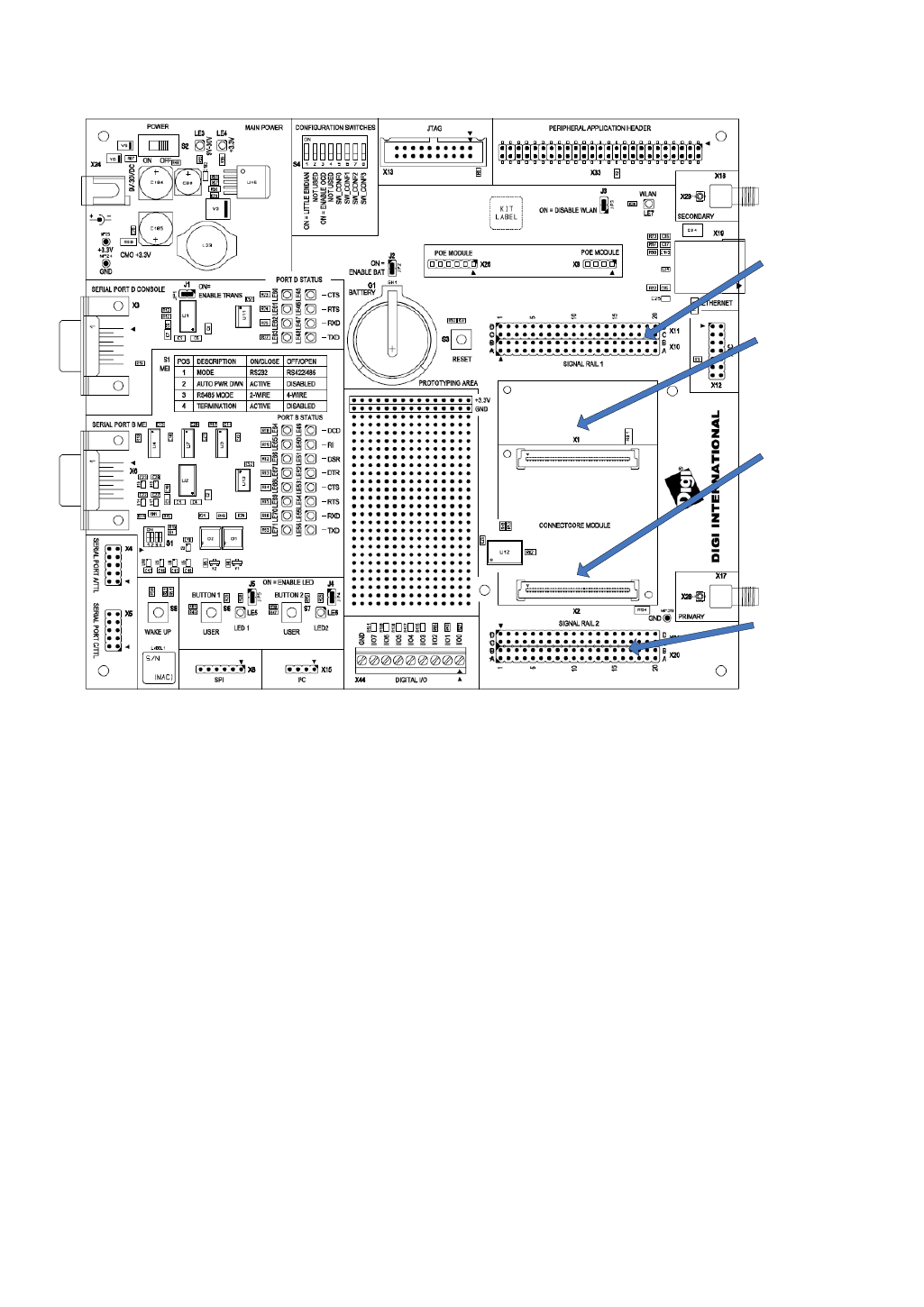
. . . . .
www.digiembedded.com 65
Module
connectors
See “Module pinout” on page 13 for related information.
Test connectors The development board provides two 4x20 pin test connectors, labeled X10/X11 and
X20/X21. These connectors are 1:1 copies of the module pins and are used for
measurement or test purposes.
X10 and X11 correspond to module connector X1.
X20 and X21 correspond to module connector X2.
Module
connector,
X1
Module
connector,
X2
Test
connector,
X20, X21
Test
Connector,
X10, X11
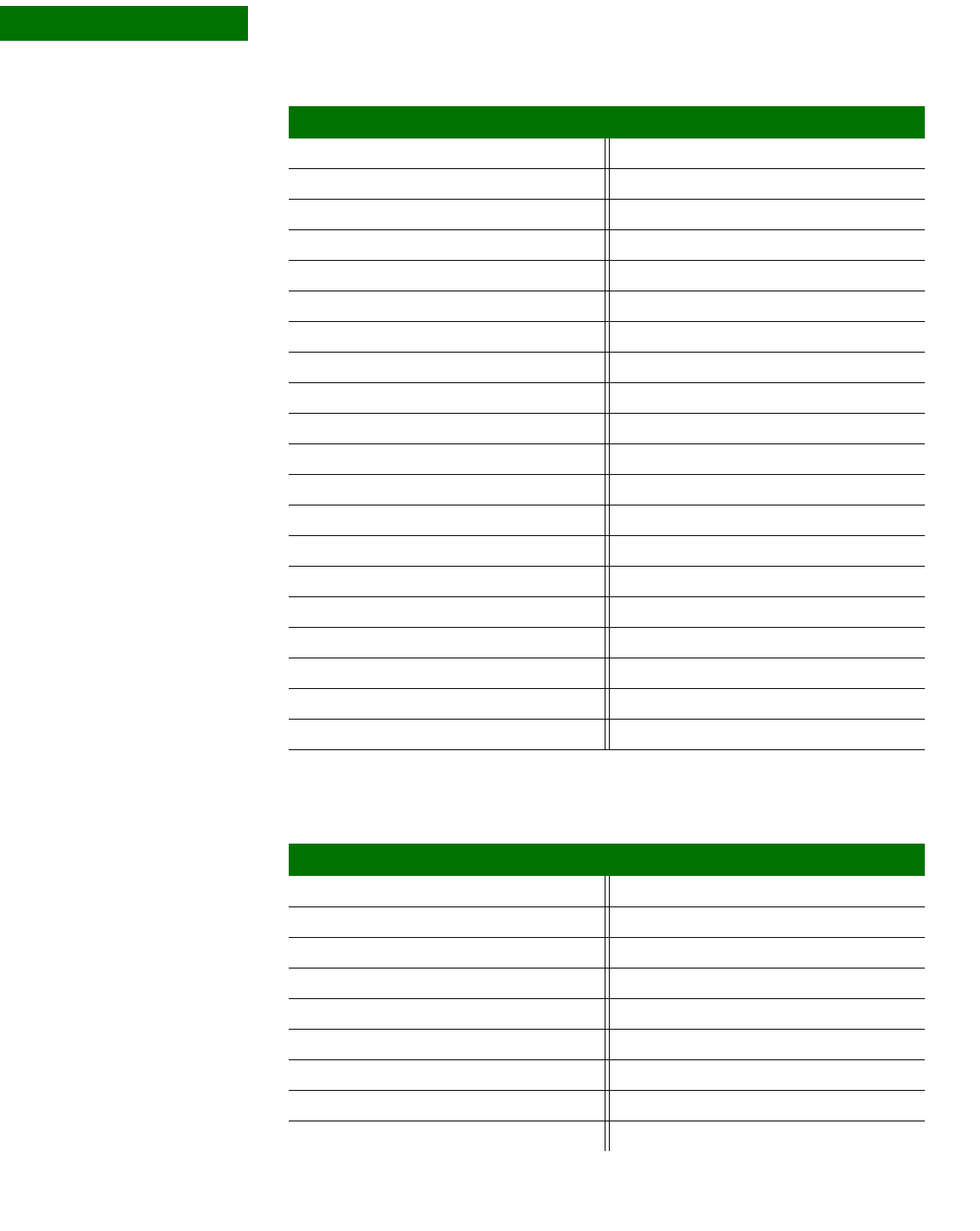
66 ConnectCore 9P 9215 and Wi-9P 9215 Hardware Reference
Chapter 2
X10 pinout
*USB signals are reserved for future use.
X11 pinout
X10 pin Signal X10 pin Signal
A1 GND B1 GND
A2 RSTOUT# B2 TCK
A3 TDO B3 TRST#
A4 LITTLE#/BIG_ENDIAN B4 WLAN_DISABLE#
A5 SW_CONF2 B5 SW_CONF3
A6 BD0 B6 BD1
A7 BD4 B7 BD5
A8 BD8 B8 BD9
A9 BD12 B9 BD13
A10 GND B10 BA0
A11 BA3 B11 BA4
A12 BA7 B12 BA8
A13 BA11 B13 BA12
A14 BA15 B14 BA16
A15 EXT_WE# B15 EXT_CS0#
A16 BE3# B16 EXT_WAIT#
A17 (ETH_TPIN) NC B17 NC (ETH_ACTIVITY#)
A18 (ETH_TPON) NC B18 NC (ETH_TPOP)
A19 Reserved* B19 Reserved*
A20 Reserved* B20 VBAT
X11 pin Signal X11 pin Signal
C1 RSTIN# D1 SRESET#
C2 TMS D2 TDI
C3 RTCK D3 OCD_EN#
C4 SW_CONF0 D4 SW_CONF1
C5 WLAN_LED# (CC Wi-9P 9215) D5 GND
C6 BD2 D6 BD3
C7 BD6 D7 BD7
C8 BD10 D8 BD11
C9 BD14 D9 BD15
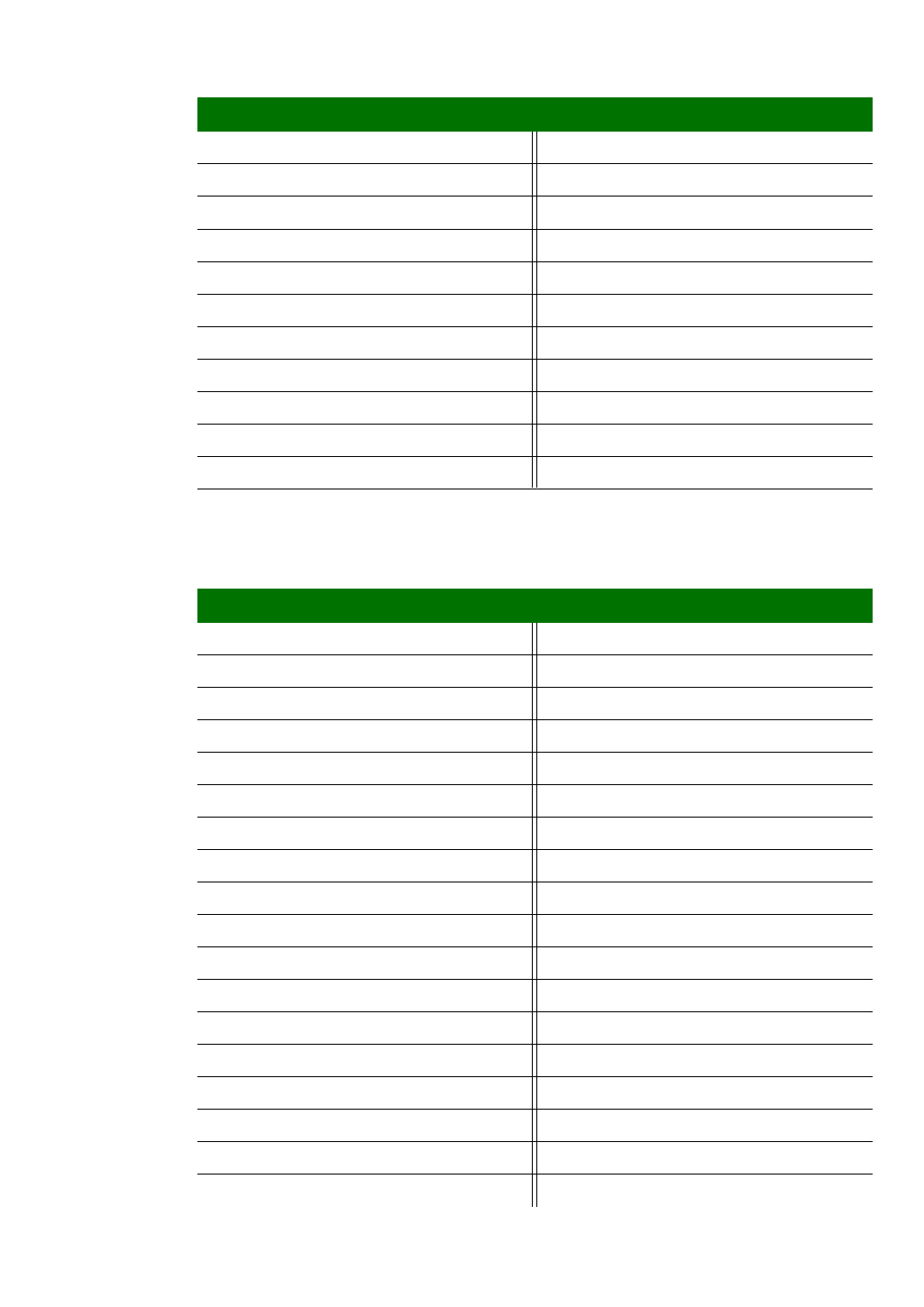
. . . . .
www.digiembedded.com 67
*USB signals are reserved for future use.
X20 pinout
C10 BA1 D10 BA2
C11 BA5 D11 BA6
C12 BA9 D12 BA10
C13 BA13 D13 BA14
C14 GND D14 EXT_OE#
C15 EXT_CS2# D15 BE2#
C16 EXT_CLK D16 GND
C17 (ETH_TPIP) NC D17 NC (ETH_LINK#)
C18 GND D18 Reserved*
C19 Reserved* D19 Reserved*
C20 3.3V D20 GND
X11 pin Signal X11 pin Signal
X20 pin Signal X20 pin Signal
A1 GND B1 GND
A2 DSRA#/GPIO2 B2 RXDA/SPI_RXD/GPIO3
A3 DTRA#/GPIO6 B3 TXDA/SPI_TXD/GPIO7
A4 DSRC#/GPIO10 B4 RXDC/GPIO11
A5 DTRC#/TXCLKC/GPIO14 B5 TXDC/GPIO15
A6 DSRB#/GPIO53 B6 RXDB/GPIO54
A7 DTRB#/GPIO57 B7 TXDB/GPIO58
A8 DSRD#/GPIO61 B8 RXDD/GPIO62
A9 DTRD#/GPIO65 B9 TXDD/GPIO66
A10 GPIO69 B10 GPIO70
A11 GPIO73 B11 GPIO74
A12 GPIO77 B12 GPIO78
A13 USER_BUTTON1#/GPIO81 B13 USER_LED1#/GPIO82
A14 USER_LED2#/GPIO85 B14 GPIO86
A15 GPIO94 B15 GPIO95
A16 CAN1_RXD/GPIO98 B16 CAN1_TXD/GPIO99
A17 I2C_SCL/GPIO102 B17 12C_SDA/GPIO103
A18 ADC_IN2 B18 ADC_IN3
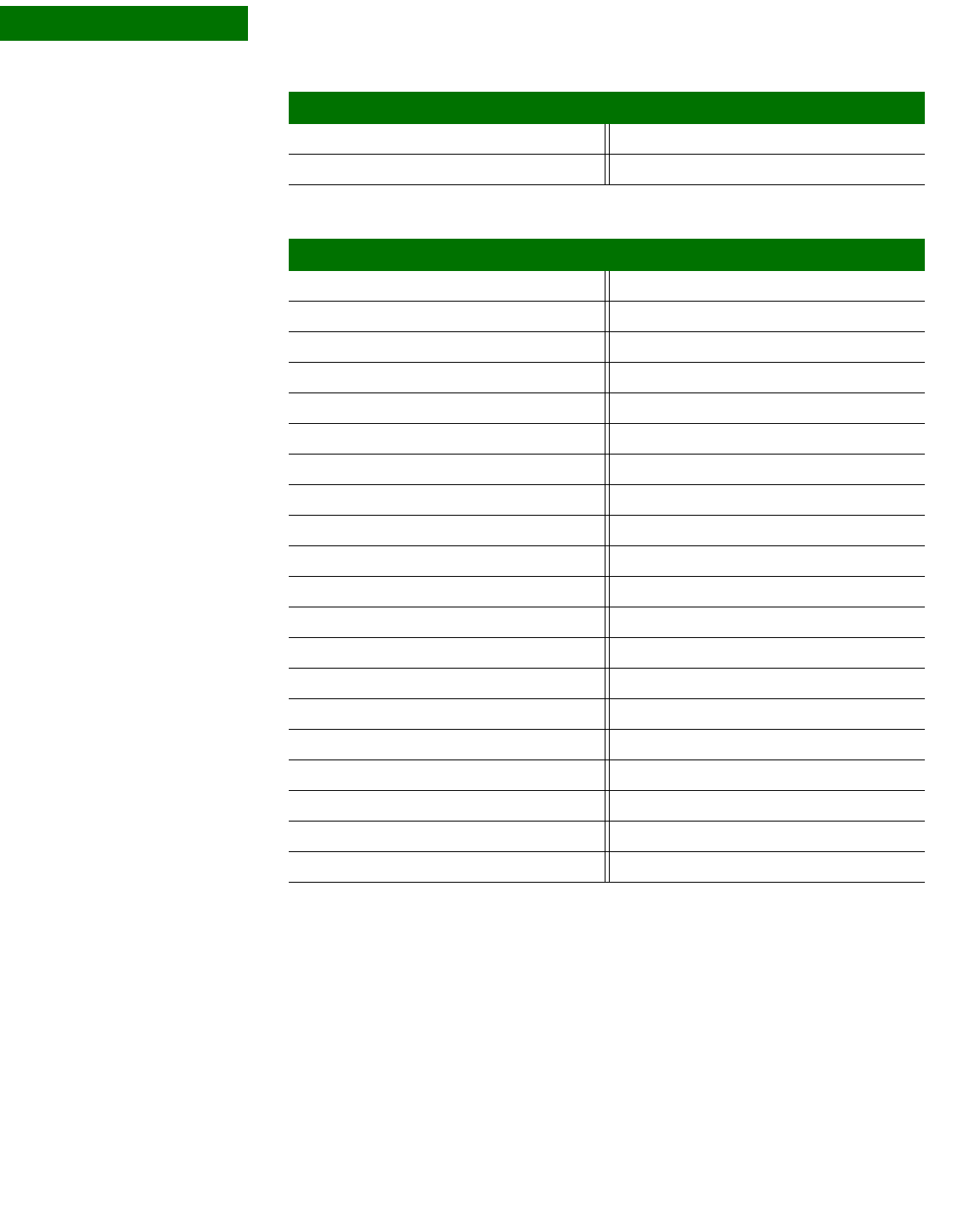
68 ConnectCore 9P 9215 and Wi-9P 9215 Hardware Reference
Chapter 2
X21 pinout
A19 ADC_IN6 B19 ADC_IN7
A20 +3.3V B20 +3.3V
X20 pin Signal X20 pin Signal
X21 pin Signal X21 pin Signal
C1 DCDA#/SPI_EN/GPIO0 D1 CTSA#/GPIO1
C2 RIA#/EIRO2/GPIO4 D2 RTSA#/SPI_CLK/GPIO5
C3 DCDC#/TXCLKC/GPIO8 D3 CTSC#/GPIO9
C4 RIC#/RXCLKC/GPIO12 D4 RTSC#/RCLKC/GPIO13
C5 DCDB#/GPIO51 D5 CTSB#/GPIO52
C6 RIB#/GPIO55 D6 RTSB#/GPIO56
C7 DCDD#/GPIO59 D7 CTSD#/GPIO60
C8 RID#/GPIO63 D8 RTSD#/GPIO64
C9 GPIO67 D9 GPIO68
C10 GPIO71 D10 GPIO72
C11 GPIO75 D11 GPIO76
C12 GPIO79 D12 GPIO80
C13 GPIO83 D13 USER_BUTTON2#/GPIO84
C14 GPIO87 D14 GPIO93
C15 CAN0_RXD/GPIO96 D15 CAN0_TXD/GPIO97
C16 GPIO100 D16 EIR03#/GPIO101
C17 ADC_IN0 D17 ADC_IN1
C18 ADC_IN4 D18 ADC_IN5
C19 AGND_ADC D19 VREF_ADC
C20 GND D20 GND

69
Appendix A:Specifications
This appendix provides environmental, mechanical, safety and power information
for the ConnectCore 9P 9215 and Wi-9P 9215 modules.
. . . . . . . . . . . . . . . . . . . . . . . . . . . . . . . . . . . . . . . . . . . . . . . . . . . . . . . . . . . . . . . . . . . . . . . . . . . . . . . . . .
Mechanical information
ConnectCore 9P 9215
The module size is 50 x 50mm.
Two board-to-board connectors are used on the module. The distance between the
module and the base board depends on the counterpart on the base board. The
minimum distance is 5mm.
The height of the parts mounted on the bottom side of the module does not exceed
2.5mm. The height of the parts mounted on the top side of the module does not
exceed 2.5mm if X3 is not populated, or 14 mm if X3 is populated.
ConnectCore Wi-9P 9215
The module size is 50 x 70mm.
Two board-to-board connectors are used on the module. The distance between the
module and the base board depends on the counterpart on the base board. The
minimum distance is 5mm.
The height of the parts mounted on the bottom side of the module does not exceed
2.5mm. The height of the parts mounted on the top side of the modules does not
exceed 5mm if X3 is not populated, or 14 mm if X3 is populated.
. . . . . . . . . . . . . . . . . . . . . . . . . . . . . . . . . . . . . . . . . . . . . . . . . . . . . . . . . . . . . . . . . . . . . . . . . . . . . . . . . .
Network interface
Ethernet Standard: IEEE 802.3

70 ConnectCore 9P 9215 and Wi-9P 9215 Hardware Reference
A
Physical layer: 10/100Base-T
Data rate: 10/100 Mbps
Mode: Full or half duplex
WLAN Standard: IEEE802.11a/b/g
Frequency: 2.4 GHz - 5GHz
Data rate: Up to 54 Mbps with fallback
Modulation: DBPSK (1 Mbps), DQPSK (2 Mbps), CCK (11,5.5 Mbps), BPSK (6,9
Mbps), QPSK (12,18 Mbps), 16-QAM (24,36 Mbps), 64-QAM (48,54 Mbps)
Connector: 2 x U.FL
Note: Please use HIROSE U.FL-LP-N-2 extraction tool for removing an U.FL cable
from the ConnectCore Wi-9P 9215.
. . . . . . . . . . . . . . . . . . . . . . . . . . . . . . . . . . . . . . . . . . . . . . . . . . . . . . . . . . . . . . . . . . . . . . . . . . . . . . . . . .
Environmental information
The module board assemblies meet all functional requirements when operating in
this environments provided below.
Typical Transmit Power
802.11a 802.11b 802.11g
13 dBm @ 6 Mbps
9 dBm @ 54 Mbps
18 dBm @ 1 Mbps
14 dBm @ 11 Mbps
16 dBm @ 6 Mbps
12 dBm @ 54 Mbps
Receive Sensitivity
802.11a 802.11b 802.11g
6 Mbps -87 dBm 1 Mbps -80 dBm 6 Mbps -90 dBm
9 Mbps -87 dBm 2 Mbps -75 dBm 9 Mbps 84 dBm
12 Mbps -85 dBm 5.5 Mbps -76 dBm 12 Mbps -82 dBm
18 Mbps -84 dBm 11 Mbps -76 dBm 18 Mbps -80 dBm
24 Mbps 81 dBm 24 Mbps -77 dBm
36 Mbps -78 dBm 36 Mbps -73 dBm
48 Mbps -73 dBm 48 Mbps -72 dBm
54 Mbps -72 dBm 54 Mbps -72 dBm

. . . . .
www.digiembedded.com 71
Note: Please refer to the thermal specifications in this manual for additional
information about operating temperature conditions
ConnectCore 9P 9215
Operating temperature: -40°C to +85°C max
Storage temperature: -40°C to +125°C
Relative humidity: 5% to 95%, non-condensing
Altitude: 0 to 12,000 feet
ConnectCore Wi-9P 9215
Operating temperature: -40°C to +85°C max
Storage temperature: -40°C to +125°C
Relative humidity: 5% to 95%, non-condensing
Altitude: 0 to 12,000 feet
. . . . . . . . . . . . . . . . . . . . . . . . . . . . . . . . . . . . . . . . . . . . . . . . . . . . . . . . . . . . . . . . . . . . . . . . . . . . . . . . . .
Thermal specifications
The table below shows the specific standard operating temperature ranges for the
entire ConnectCore 9P 9215 embedded core module family.
The lower standard operating temperature range is specified without restrictions,
except condensation must not occur.
The upper operating temperature limit depends on the host PCB layout and
surrounding environmental conditions. To simplify the customer's design process, a
maximum component case temperature has been specified.
Standard Operating Temperature Ranges
Product Operating Temperature Range
ConnectCore 9P 9215 -40 to +85°C
ConnectCore W-9P 9215 -40 to +65°C @ 100% Duty Cycle (WLAN)
-40 to +85°C @ 33% Duty Cycle (WLAN)
Maximum Component Case Temperature
Product Component Maximum Case Temperature
ConnectCore 9P 9215 U1 120°C
ConnectCore W-9P 9215 U16 95°C
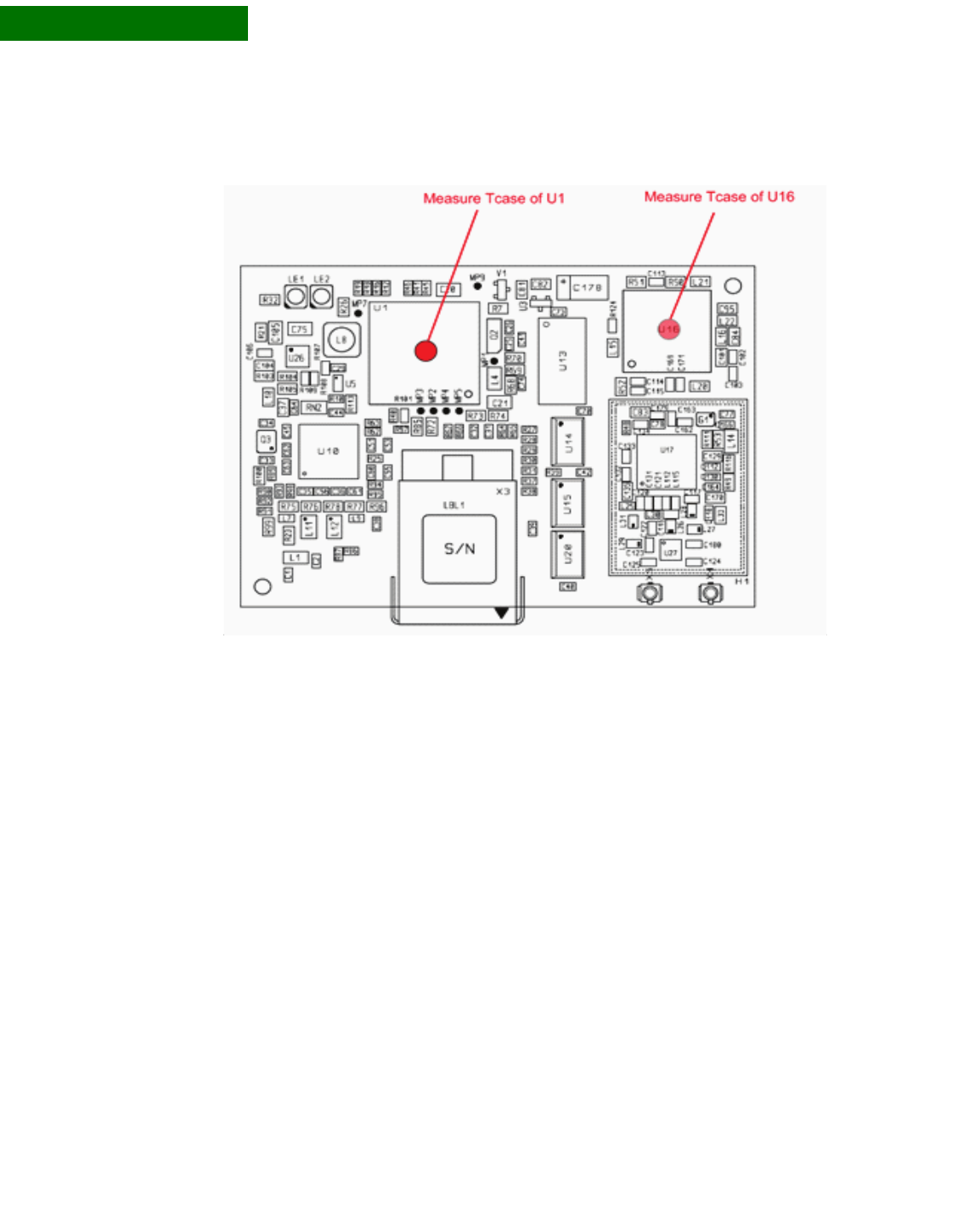
72 ConnectCore 9P 9215 and Wi-9P 9215 Hardware Reference
A
The maximum component case temperature must remain below the maximum,
measured at the locations shown in the figure below.
When attaching thermocouples, please the follow the guidelines below:
Carefully remove any labels or other foreign material from the component.
Ensure an adhesive with high thermal conductivity is used. Use as little
adhesive as possible.
Make sure the thermocouple is touching the case of the component and not
"floating" in the adhesive.
The use of precision, fine-wire K-type thermocouples is strongly recommended
–Omega Engineering P/N 5TC-TT-K-36-72, or similar
Additional design
recommendations
The following list provides additional design guidance with respect to thermal
management in applications with operating temperatures at the high end or beyond
the specified standard ambient temperature range.
Providing air movement will improve heat dissipation.
The host PCB plays a large part in dissipating the heat generated by the
module. A large copper plane located will improve the heat dissipation
capabilities of the PCB.

. . . . .
www.digiembedded.com 73
If the design allows, added buried PCB planes will also improve heat
dissipation. The copper planes create a larger surface to spread the heat into
the surrounding environment.
. . . . . . . . . . . . . . . . . . . . . . . . . . . . . . . . . . . . . . . . . . . . . . . . . . . . . . . . . . . . . . . . . . . . . . . . . . . . . . . . . .
Safety statements
To avoid contact with electrical current:
Never install electrical wiring during an electrical storm.
Use a screwdriver and other tools with insulated handles.
Wear safety glasses or goggles.
Installation of inside wiring may bring you close to electrical wire, conduit,
terminals and other electrical facilities. Extreme caution must be used to avoid
electrical shock from such facilities. Avoid contact with all such facilities.
Protectors and grounding wire placed by the service provider must not be
connected to, removed, or modified by the customer.
Do not touch or move the antenna(s) while the unit is transmitting or receiving.
Do not hold any component containing a radio such that the antenna is very
close to or touching any exposed parts of the body, especially the face or eyes,
while transmitting.
Do not operate a portable transmitter near unshielded blasting caps or in an
explosive environment unless it is a type especially qualified for such use.
Any external communications wiring you may install needs to be constructed to
all relevant electrical codes. In the United States, this is the National Electrical
Code Article 800. Contact a licensed electrician for details.
. . . . . . . . . . . . . . . . . . . . . . . . . . . . . . . . . . . . . . . . . . . . . . . . . . . . . . . . . . . . . . . . . . . . . . . . . . . . . . . . . .
Power requirements
ConnectCore 9P 9215
Parameter Limits
Input voltage (Vcc) 3.3V±5% (3.14V to 3.46V)
Input current 660mA max
Input low voltage 0.0V <VIL <0.3*Vcc
Input high voltage 0.7*Vcc <VIH <Vcc

74 ConnectCore 9P 9215 and Wi-9P 9215 Hardware Reference
A
ConnectCore Wi-9P 9215
. . . . . . . . . . . . . . . . . . . . . . . . . . . . . . . . . . . . . . . . . . . . . . . . . . . . . . . . . . . . . . . . . . . . . . . . . . . . . . . . . .
IEEE802.11 a/b/g WLAN
The ConnectCore Wi-9P 9215 provides access to an IEEE802.11a/b/g WLAN
interface. The whole circuitry is located on the module. The user can track WLAN
activity through the WLAN-LED# signal. The user can also disable the RF power
amplifier by activating the WLAN-DISABLE# signal.
Two U.FL connectors are available for dual-diversity.
The WLAN baseband controller can be reset through GPIO92. When this signal is low,
the baseband controller is in reset mode. When high, the controller is active.
The interrupt signal connected to the baseband controller is GPIO_AO.
Output low voltag
(@lol=100uA)
0.0V <VOL <0.2V
Output high voltage
(@loh=100uA)
Vcc-0.2V <VOH <Vcc
Parameter Limits
Input voltage (Vcc) 3.3V±5% (3.00V to 3.60V)
Input current 1A max
Input low voltage 0.0V <VIL <0.3*Vcc
Input high voltage 0.7*Vcc <VIH <Vcc
Output low voltage 0.0V <VOL <0.4V
Output high voltage Vcc-0.4V <VOH <Vcc
Parameter Limits
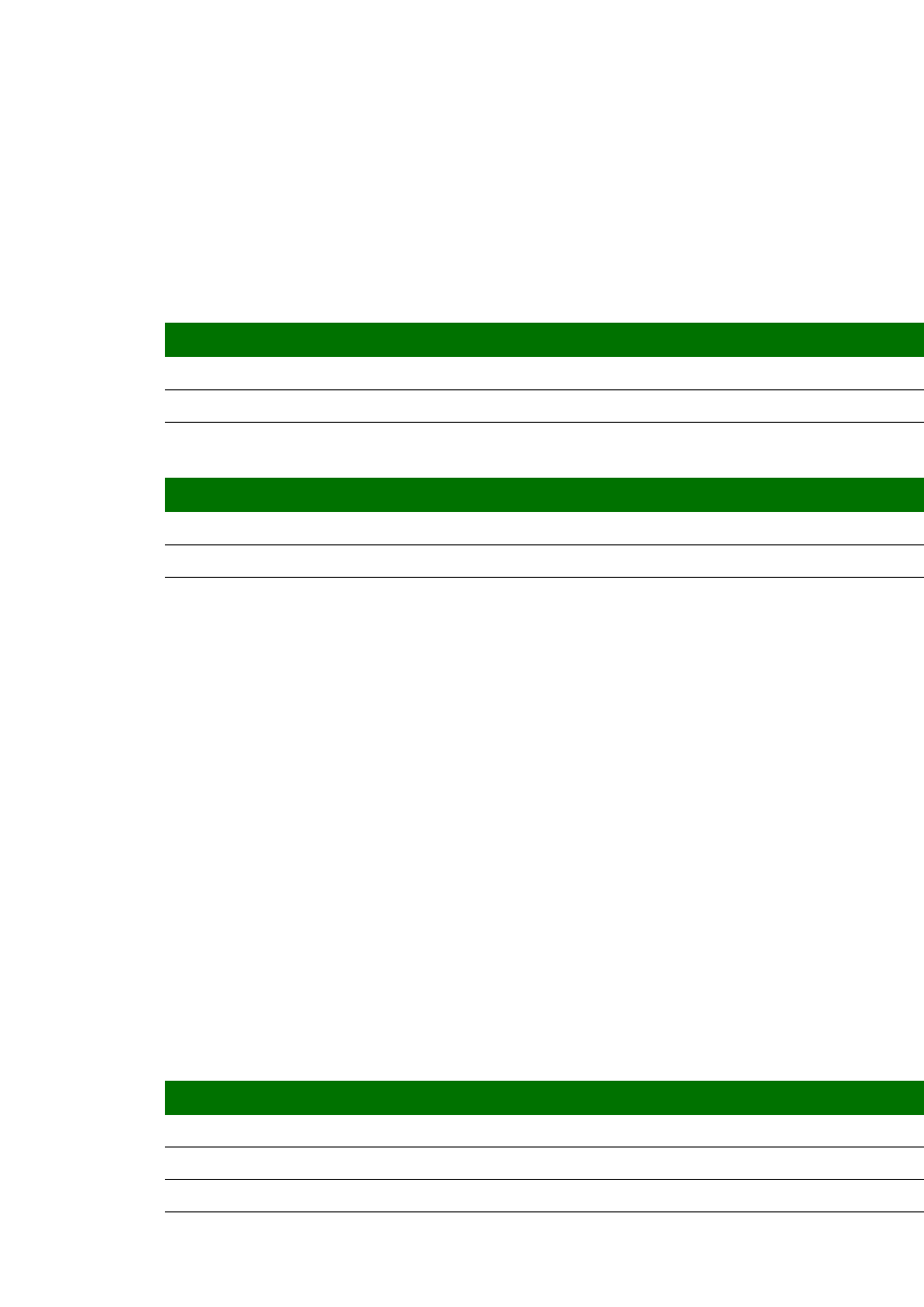
. . . . .
www.digiembedded.com 75
. . . . . . . . . . . . . . . . . . . . . . . . . . . . . . . . . . . . . . . . . . . . . . . . . . . . . . . . . . . . . . . . . . . . . . . . . . . . . . . . . .
Typical module current / power measurements
The following illustrates typical power consumption for a ConnectCore 9P 9215 and
ConnectCore Wi-9P 9215 module measured with the NET+OS napsave sample
application in function applicationStart( ), with module's Ethernet connected to a
100Mb network.
(For the ConnectCore Wi-9P 9215 module, the WiFi is enabled and associated.)
ConnectCore 9P 9215:
ConnectCore Wi-9P 9215:
1 VLIO is supplying the core voltage regulator. This typical measurement was made with VLIO and
+3.3V set to 3.3V. VLIO can vary between 2.5V to 5.0V. +3.3V can vary between 3.1V to 3.6V.
2 This is power consumption with all clocks on, NS9215 Clock Configuration register (A090017C) set
to 02013BFF hexadecimal.
3 This is the default power consumption. Note the default value of the NS9215 Clock Configuration
register (A090017C) is 02012015 hexadecimal
4FIM is the Flexible Interface Module. DRPIC is a High performance 8-bit RISC Microcontroller.
. . . . . . . . . . . . . . . . . . . . . . . . . . . . . . . . . . . . . . . . . . . . . . . . . . . . . . . . . . . . . . . . . . . . . . . . . . . . . . . . . .
Typical power save current / power measurements
The following table illustrates typical power consumption using various NS9215
power management mechanisms. These measurements were taken with all NS9215
I/O clocks disabled except UART B, UART D, Ethernet MAC, I/O Hub, and the
Memory Clock; the Ethernet connected to a 100Mb network and the WLAN interface
associated with an access point, using a standard module plugged into a JumpStart
Kit board, with nominal voltage applied.
ConnectCore 9P 9215
VLIO1+3.3V1Total Power
With FIMs (DRPIC) enabled 4 1.27 (384mA @ 3.3V) .561W (170mA @ 3.3V) 1.83W
With FIMs (DRPIC) disabled4.904W (274mA @ 3.3V) .561W (170mA @ 3.3V) 1.47W
VLIO1+3.3V1Total Power
With all clocks enabled2, 4 1.43W (432mA @ 3.3V) 1.17W (354mA @ 3.3V) 2.6W
Default configuration 3,4 1.13W (343mA @ 3.3V) 1.17W (354mA @ 3.3V) 2.30W
Module and Dev Board1Module only2
Normal operational mode31.63W (496mA) 1.45W (443mA)
Full clock scaling mode4.879W (267mA) .683W (208mA)
Sleep mode5.346W (105mA) .151W (46mA)

76 ConnectCore 9P 9215 and Wi-9P 9215 Hardware Reference
A
ConnectCore Wi-9P 9215
1 This measurement was taken from the R80 current sense resistor (0.025 ohm) on the JumpStart Kit
development board.
2 This measurement represents only the current of the VLIO and +3.3V inputs to the module, measured
from the two current sense resistors R81 and R94 (0.025 ohm) located on the JumpStart Kit develop-
ment board.
3 This is the default power consumption mode when entering application Start(), as measured with the
napsave sample application. The value of the NS9215 Clock Configuration register (A090017C) is
02012015 hexadecimal. (Note 02012015 enables USART B, UART D, the Ethernet MAC, the I/O hub,
and Memory Clock 0.)
4 This measurement was produced by selecting the "Clock Scale" menu option in the napsave sample
application. For the ConnectCore Wi-9P 9215, the clock scaling is divided by 4, for the ConnectCore
9P 9215, the clock scaling is divided by 16.
5 This measurement was produced by selecting the "Deep Sleep/Wakeup with an External IRQ" menu
option in the napsave sample application.
Module and Dev Board1Module only2
Normal operational mode32.69W (816mA) 2.36W (716mA)
Full clock scaling mode42.01W (610mA) 1.76W (533mA)
Sleep mode50.73W (220mA) 0.46W (138mA)
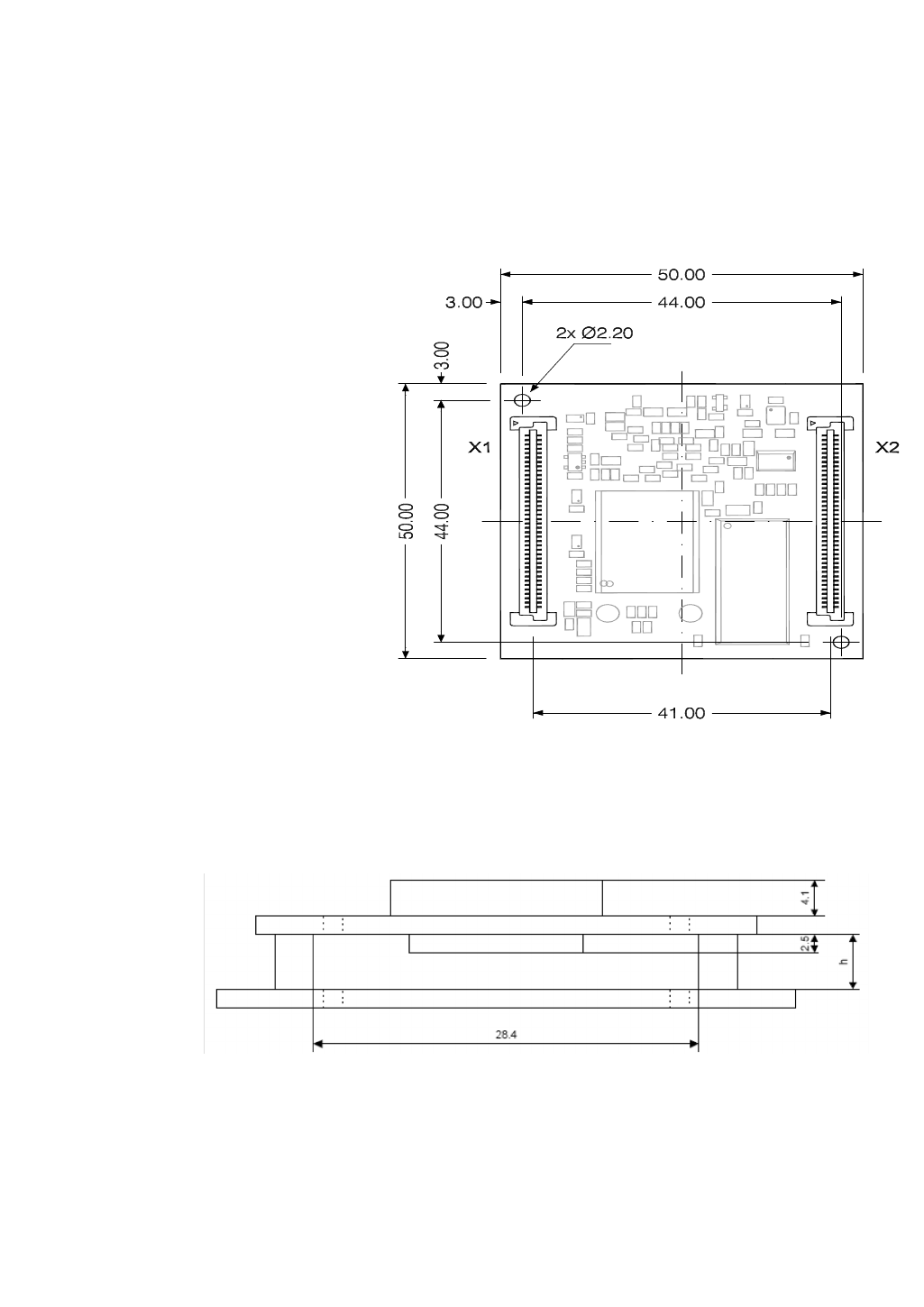
. . . . .
www.digiembedded.com 77
. . . . . . . . . . . . . . . . . . . . . . . . . . . . . . . . . . . . . . . . . . . . . . . . . . . . . . . . . . . . . . . . . . . . . . . . . . . . . . . . . .
ConnectCore 9P 9215 Module
Top vi ew
Note:
Measurements are in millimeters.
Module, side view
Note:
Measurements are in millimeters.
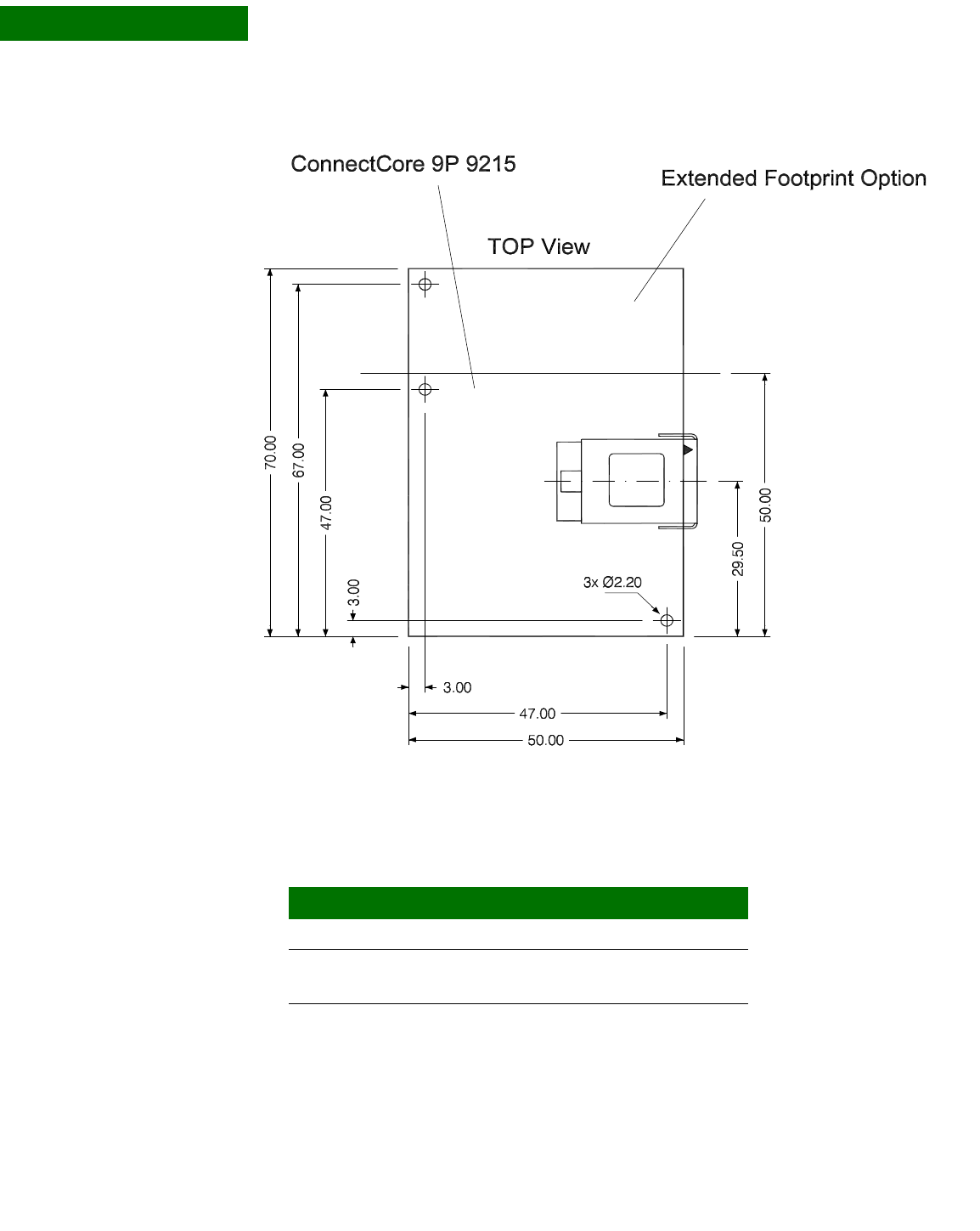
78 ConnectCore 9P 9215 and Wi-9P 9215 Hardware Reference
A
Device Berg/FCI connector
ConnectCore 9P 9215 module 61082-081409LF
ConnectCore 9P 9215 JumpStart board
(mating connector on the base board)
61083-084409LF
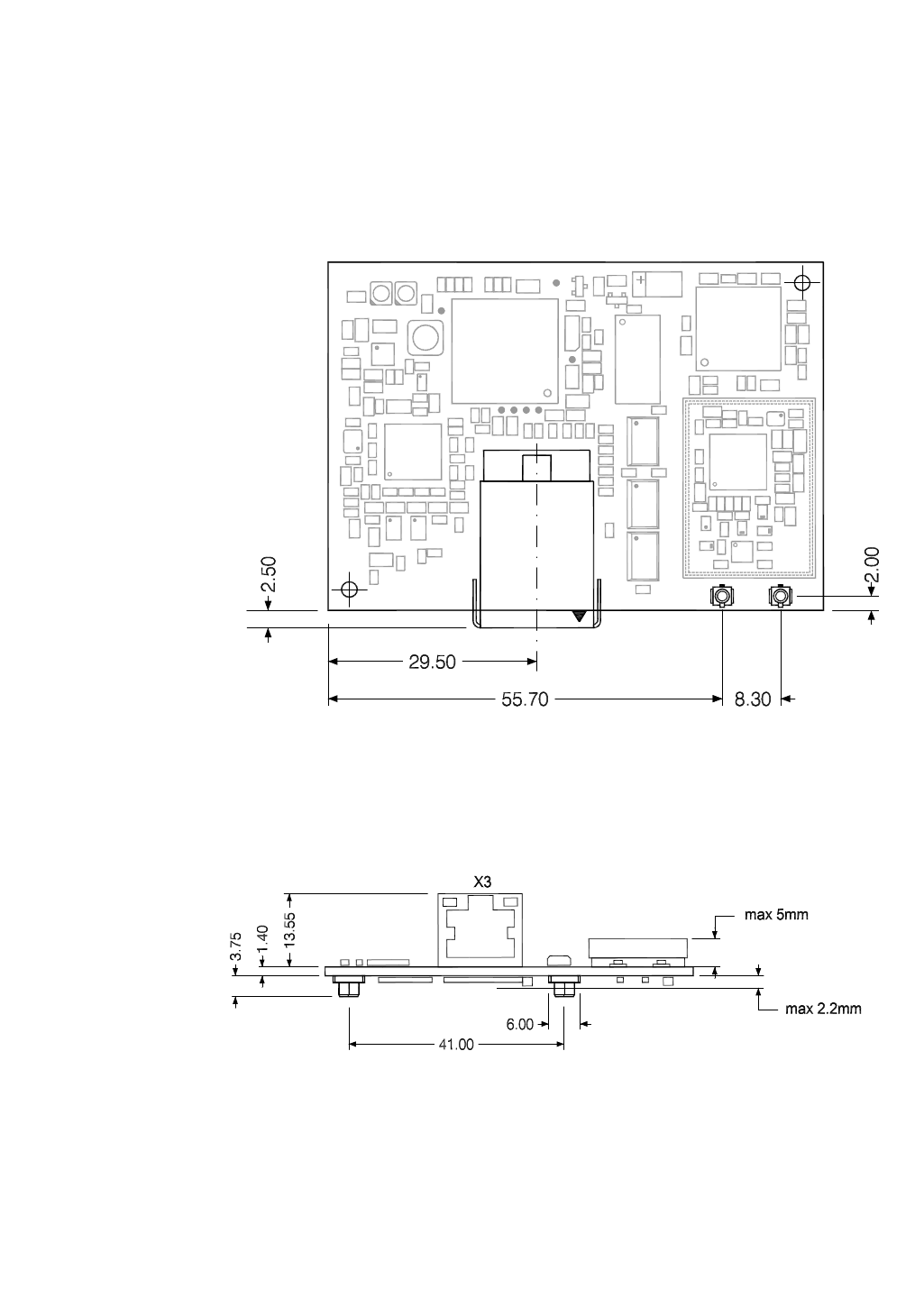
. . . . .
www.digiembedded.com 79
. . . . . . . . . . . . . . . . . . . . . . . . . . . . . . . . . . . . . . . . . . . . . . . . . . . . . . . . . . . . . . . . . . . . . . . . . . . . . . . . . .
ConnectCore Wi-9P 9215 Module
Module, top view
Note:
Measurements are in millimeters.
Module, side view
Note:
Measurements are in millimeters.
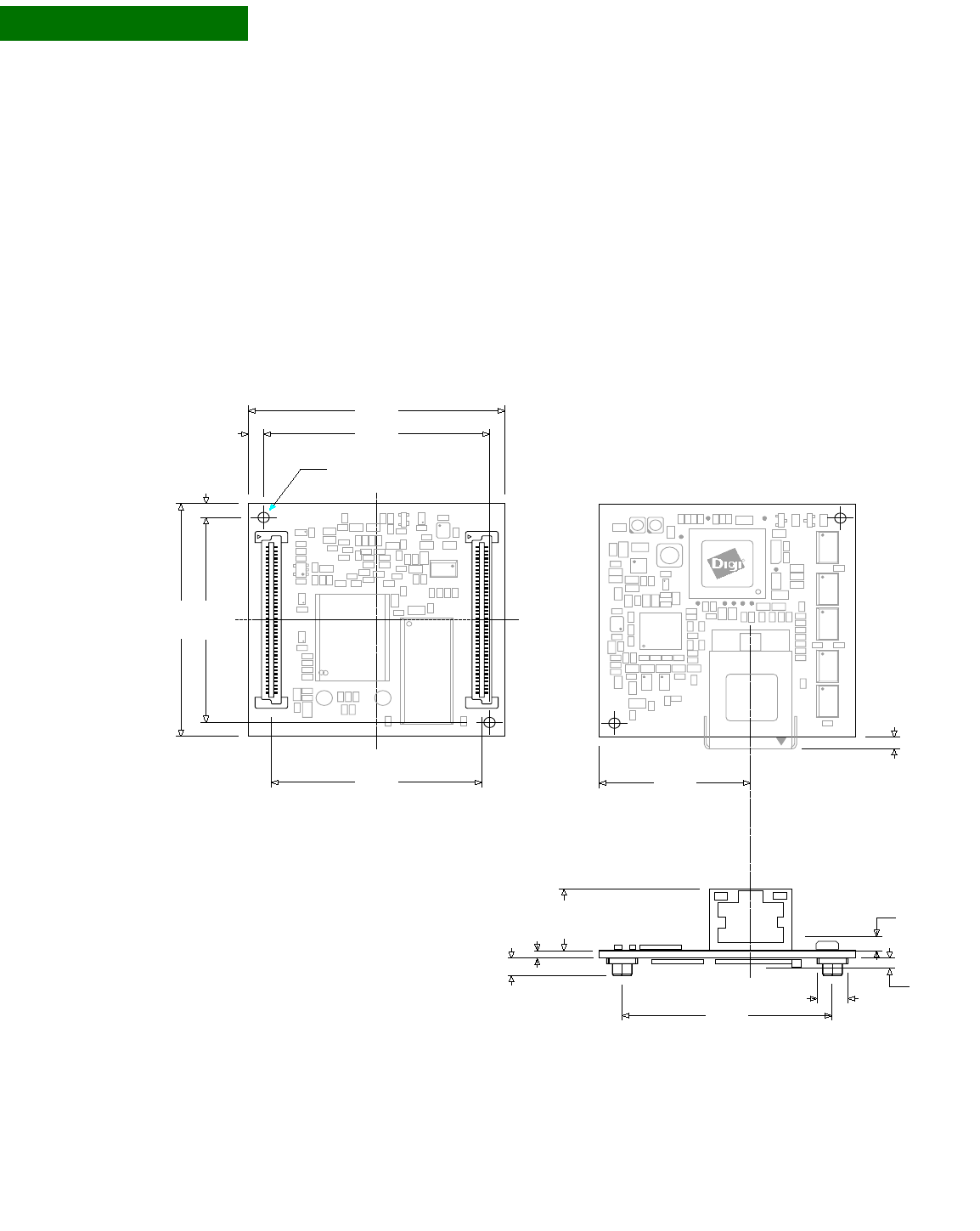
80 ConnectCore 9P 9215 and Wi-9P 9215 Hardware Reference
A
. . . . . . . . . . . . . . . . . . . . . . . . . . . . . . . . . . . . . . . . . . . . . . . . . . . . . . . . . . . . . . . . . . . . . . . . . . . . . . . . . .
Layout recommendation
Below are the mechanical dimensions of the ConnectCore 9P 9215 module.
The layout of the JumpStart board is consistent with the recommendations from
Berg/FCI for the mating connector (Berg/FCI 61083-084409LF). There is a 41mm
separation between the two module connectors. Drawing number 61083 on the FCI
web page: www.fciconnect.com shows the manufacturer recommended layout.
ConnectCore 9P 9215
BOTTOM View TOP View
2x Ӆ2.20
3.00 44.00
50.00
3.0044.00
50.00
X1 X2
29.50
2.50
3.75
1.40
41.00
6.00 max 2.2mm
max 3mm
13.55
X3
SIDE View
41.00
12
79 80 8079
12
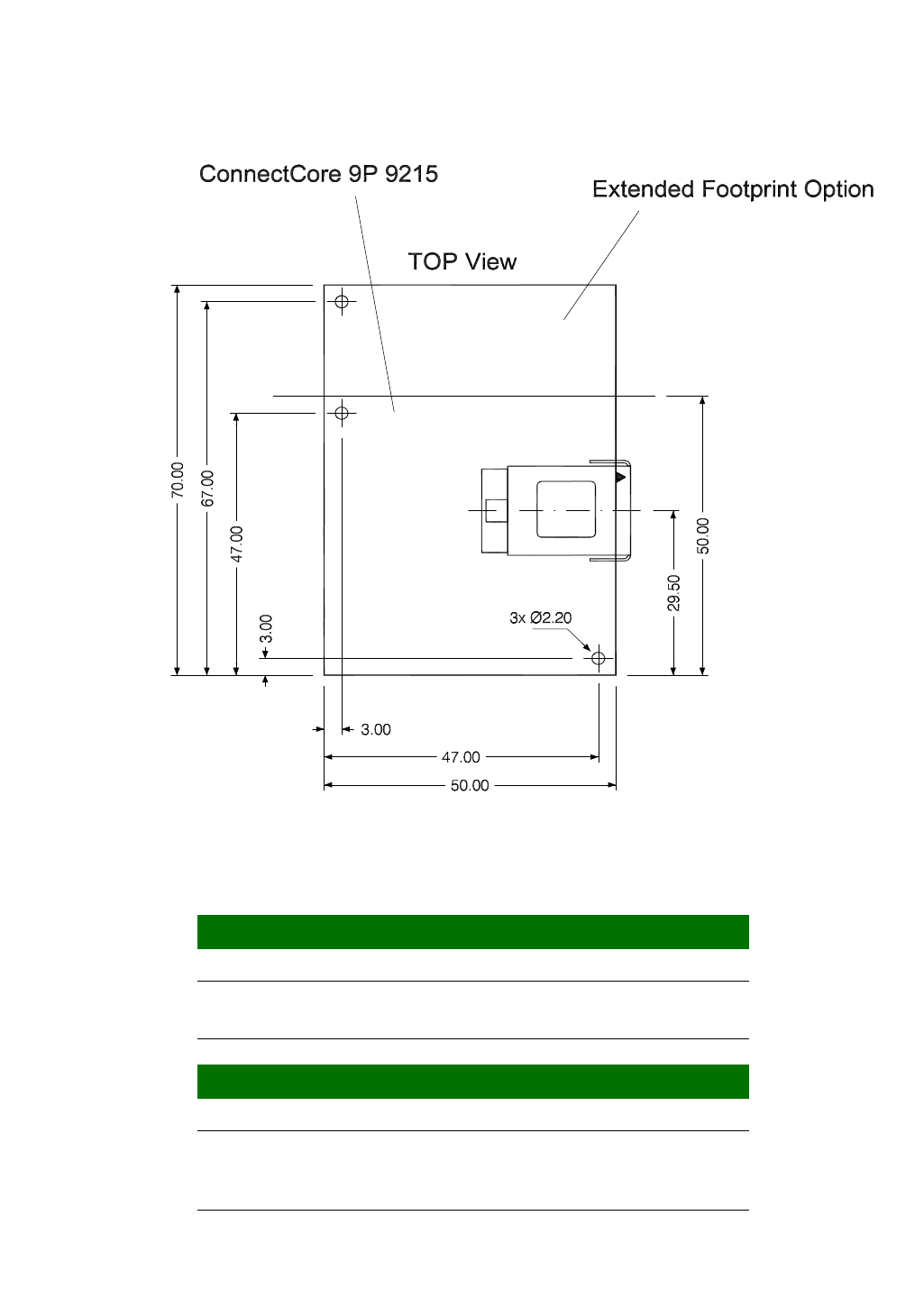
. . . . .
www.digiembedded.com 81
Device Berg/FCI connector
ConnectCore 9P 9215 module 61082-081409LF
ConnectCore 9P 9215 JumpStart board
(mating connector on the base board)
61083-084409LF
Device Berg/FCI connector
ConnectCore 9P 9215 - Wi-9P 9215 module 61082-081409LF
ConnectCore Wi-9P 9215 JumpStart board
(mating ConnectCore 9P 9215 - Wi-9P 9215
JumpStart board)
61083-084409LF
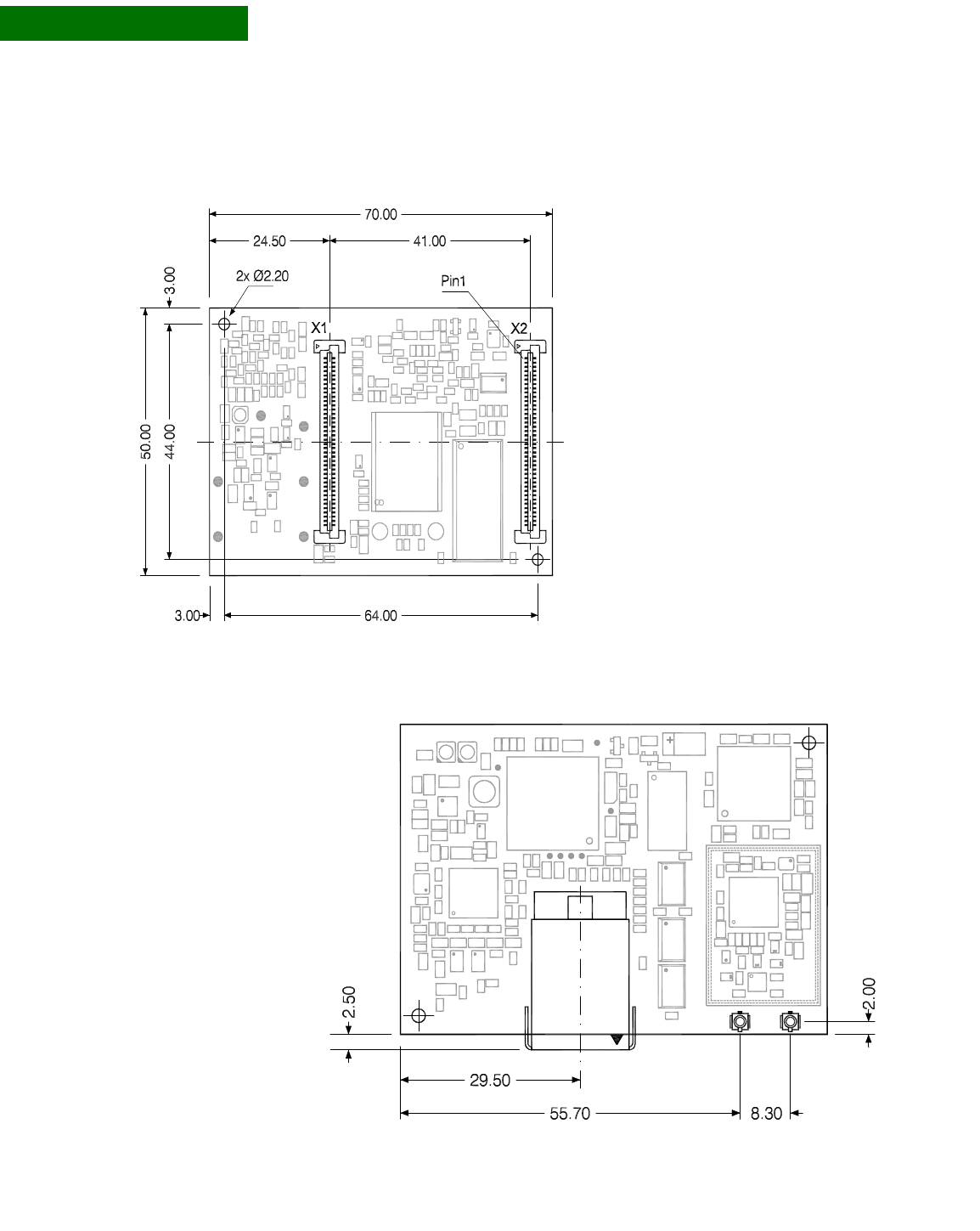
82 ConnectCore 9P 9215 and Wi-9P 9215 Hardware Reference
A
ConnectCore Wi-9P 9215
Below are the mechanical dimensions of the ConnectCoreWi- 9P 9215 module.
BOTTOM View.
TOP View
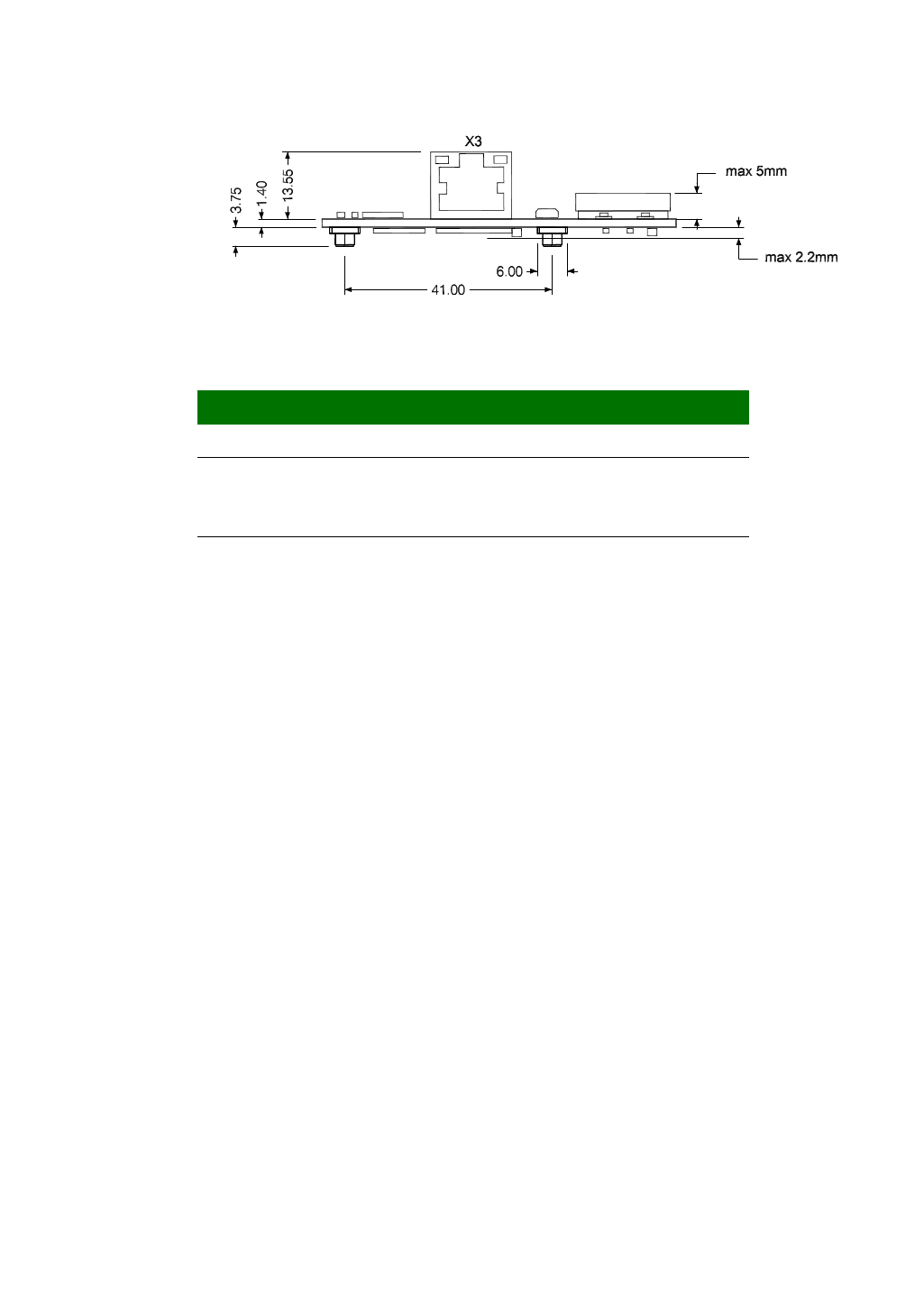
. . . . .
www.digiembedded.com 83
SIDE view
Device Berg/FCI connector
ConnectCore Wi-9P 9215 61082-081409LF
ConnectCore Wi-9P 9215 JumpStart board
(mating ConnectCore 9P 9215 - Wi-9P 9215
JumpStart board)
61083-084409LF
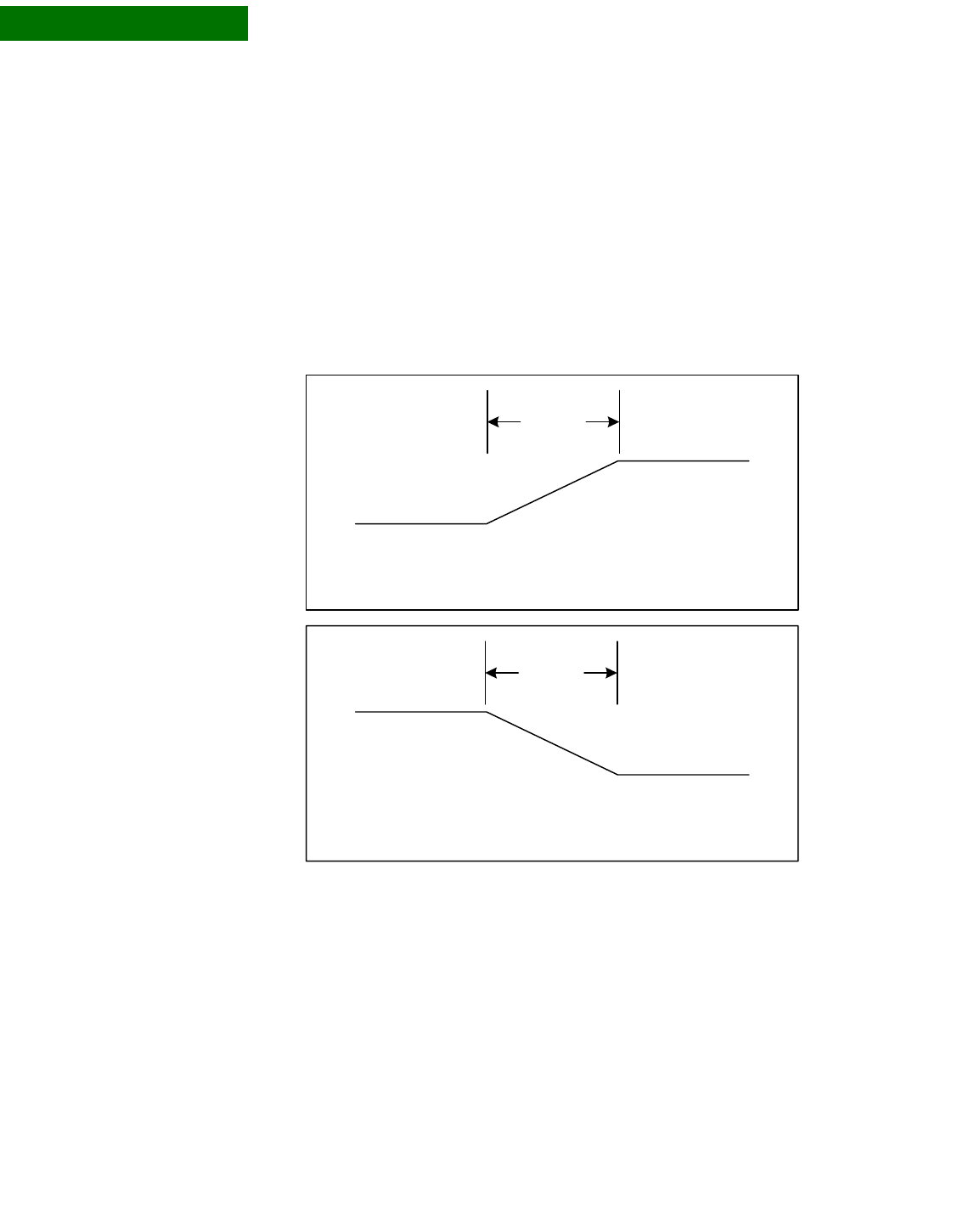
84 ConnectCore 9P 9215 and Wi-9P 9215 Hardware Reference
A
. . . . . . . . . . . . . . . . . . . . . . . . . . . . . . . . . . . . . . . . . . . . . . . . . . . . . . . . . . . . . . . . . . . . . . . . . . . . . . . . . .
Reset and edge sensitive input timing requirements
The critical timing requirement is the rise and fall time of the input. If the rise time
is too slow for the reset input, the hardware strapping options may be registered
incorrectly. If the rise time of a positive-edge-triggered external interrupt is too slow,
then an interrupt may be detected on both the rising and falling edge of the input
signal.
A maximum rise and fall time must be met to ensure that reset and edge sensitive
inputs are handled correctly. With Digi processors, the maximum is 500 nanoseconds
as shown:
On the ConnectCore 9P 9215 JumpStart there was a measurement of 220ns rise time
and 10ns fall time.
negative edge input
tF max = 500nsec
VIN = 2.0V to 0.8V
t
F
reset_n or positive edge input
tR max = 500nsec
VIN = 0.8V to 2.0V
t
R

. . . . .
www.digiembedded.com 85
. . . . . . . . . . . . . . . . . . . . . . . . . . . . . . . . . . . . . . . . . . . . . . . . . . . . . . . . . . . . . . . . . . . . . . . . . . . . . . . . . .
Antenna specifications: 2 dBi Dipole
Attributes
Dimensions Note: Dimensions are provided for reference purposes only. The actual antenna
might vary.
Attribute Property
Frequency 2.4~2.5 GHz
Power output 2W
DB gain 2 dBi
VSWR < or = 2.0
Dimension 108.5 mm x 10.0 mm
Weight 10.5g
Temperature rating -40°–+80° C
Part number DG-ANT-20DP-BG
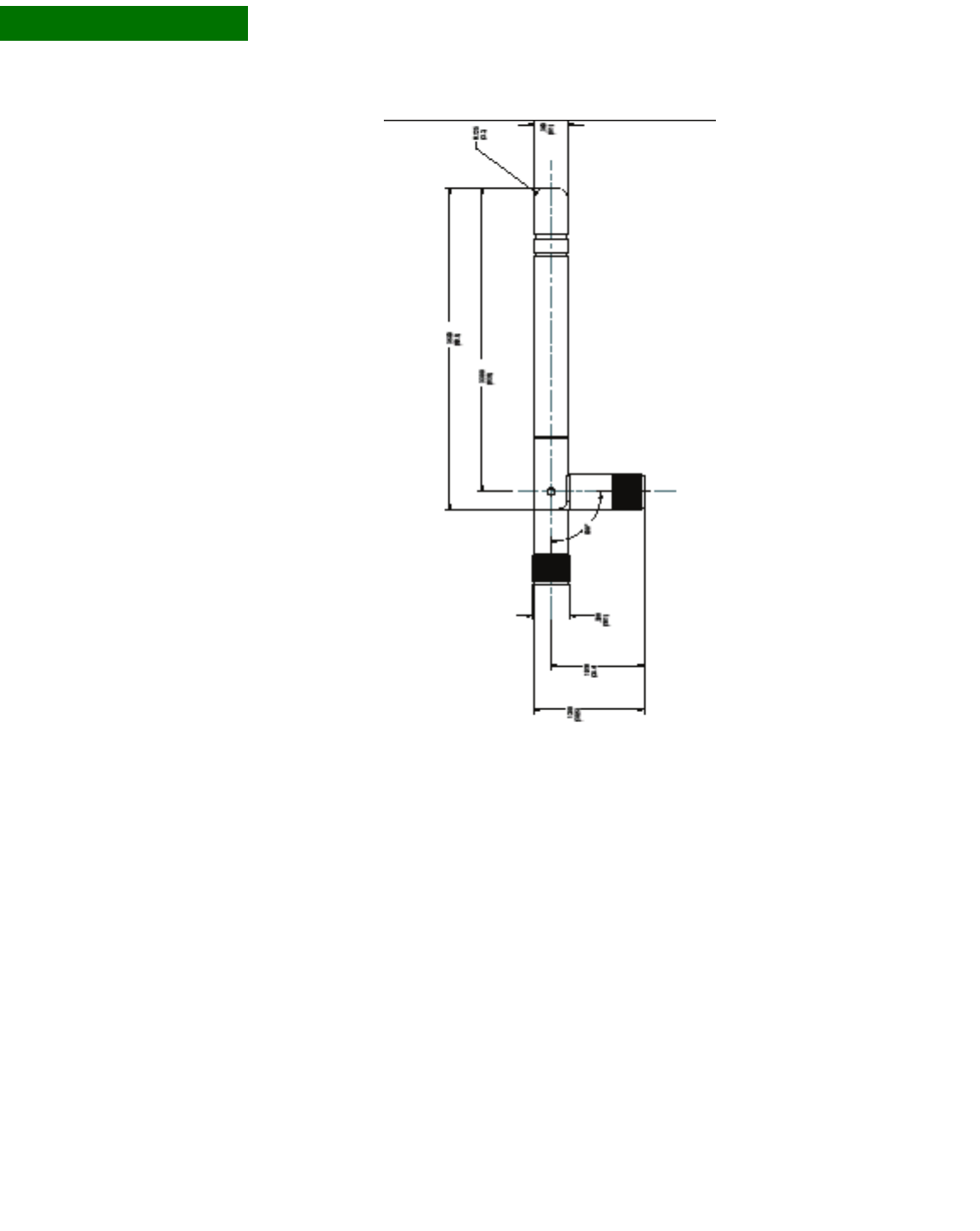
86 ConnectCore 9P 9215 and Wi-9P 9215 Hardware Reference
A
Antenna strength
(radiation
pattern) diagram
This diagram shows the strength of the signal received by the whip antenna on both
a horizontal and vertical plane. The diagram shows the magnetic field when the
antenna is in a vertical position. The red solid line represents the horizontal plane
and the green dotted line represents the vertical plane. You can see in the
illustration that at 90 degrees, the signal strength is 0 (as expected).
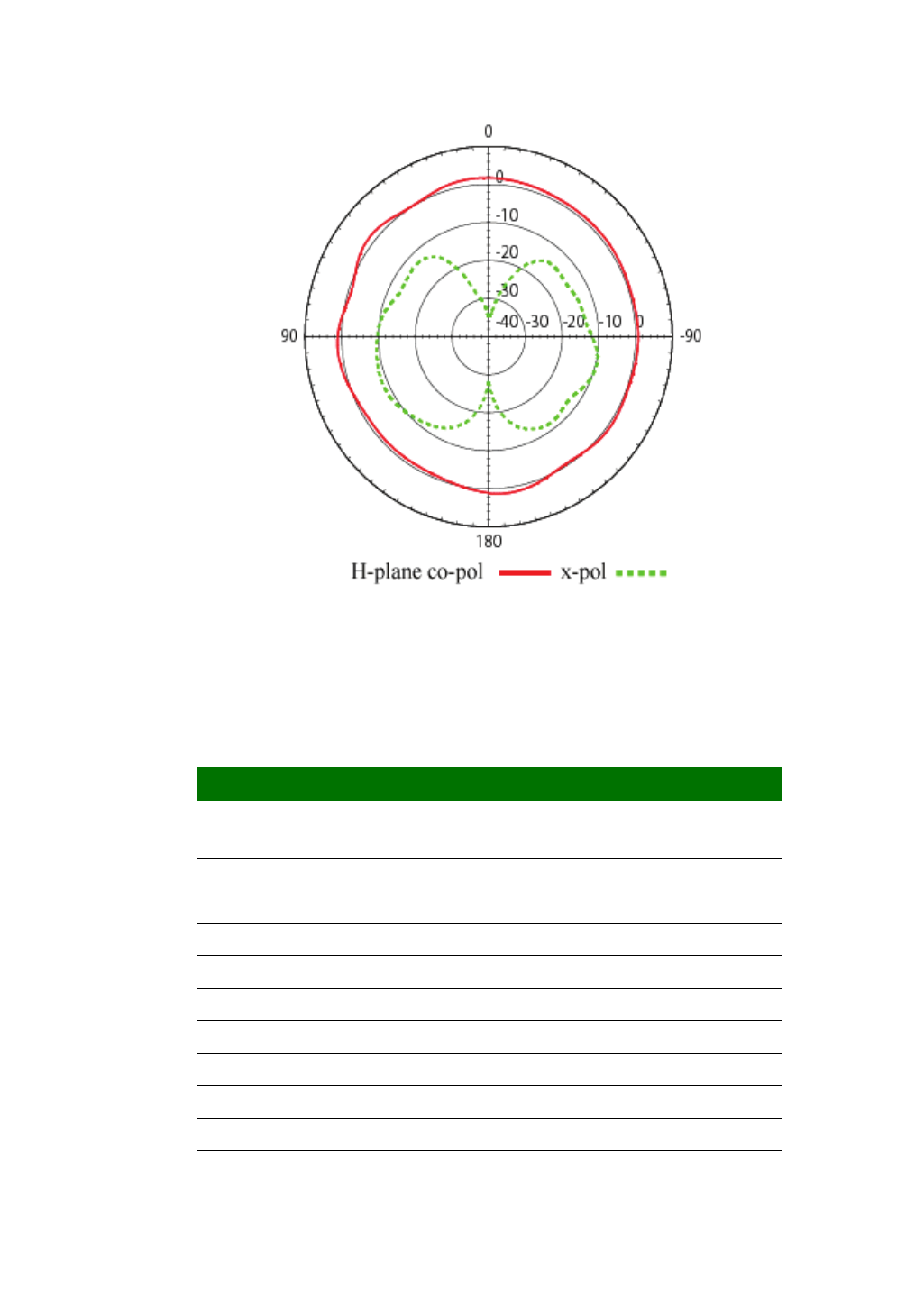
. . . . .
www.digiembedded.com 87
. . . . . . . . . . . . . . . . . . . . . . . . . . . . . . . . . . . . . . . . . . . . . . . . . . . . . . . . . . . . . . . . . . . . . . . . . . . . . . . . . .
Antenna specifications: 5.5 dBi Dipoles
Attributes
Attributes Band 1 Band 2
Frequency 2.4~2.5 GHz 5.15~5.35 GHz
5.725~5.85 GHz
VSWR 2.0 max
Return loss -10 dB max
DB gain 5 dBi (Typ)
Polarization Linear
Power output 1W
Dimension See measurements in the drawing after the table
Operating temperature -20°–+65°C
Storage temperature -20°–+65°C
Part number DG-ANT-55DP-AG
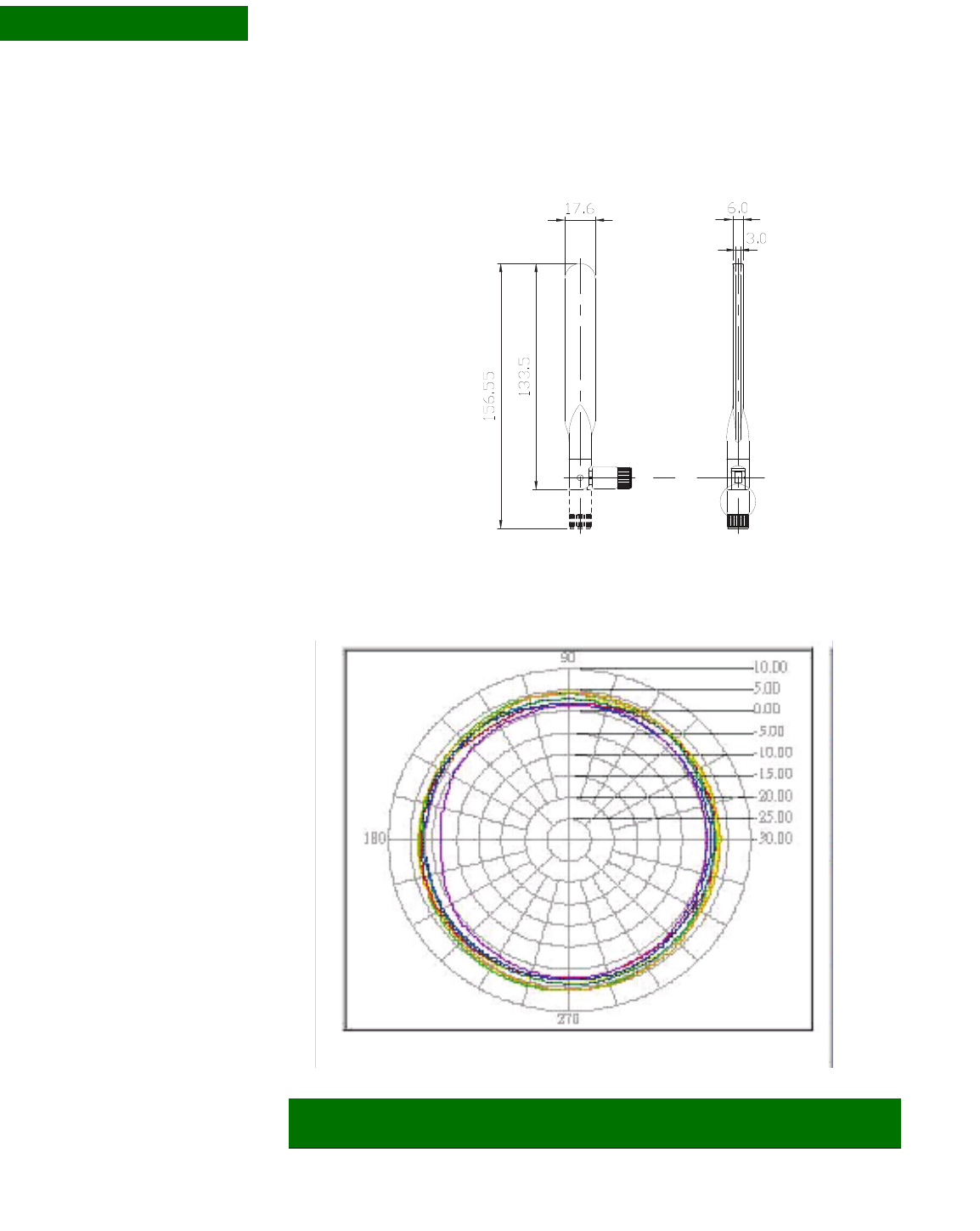
88 ConnectCore 9P 9215 and Wi-9P 9215 Hardware Reference
A
Dimensions Note:Dimensions are provided for reference purposes only. The actual antenna
might vary.
Radiation
pattern: H-Plane
(2.0 and 5.0 GHz)
Color Freq (MHz) Peak (dBi) Angle (o) Avg (dBi)
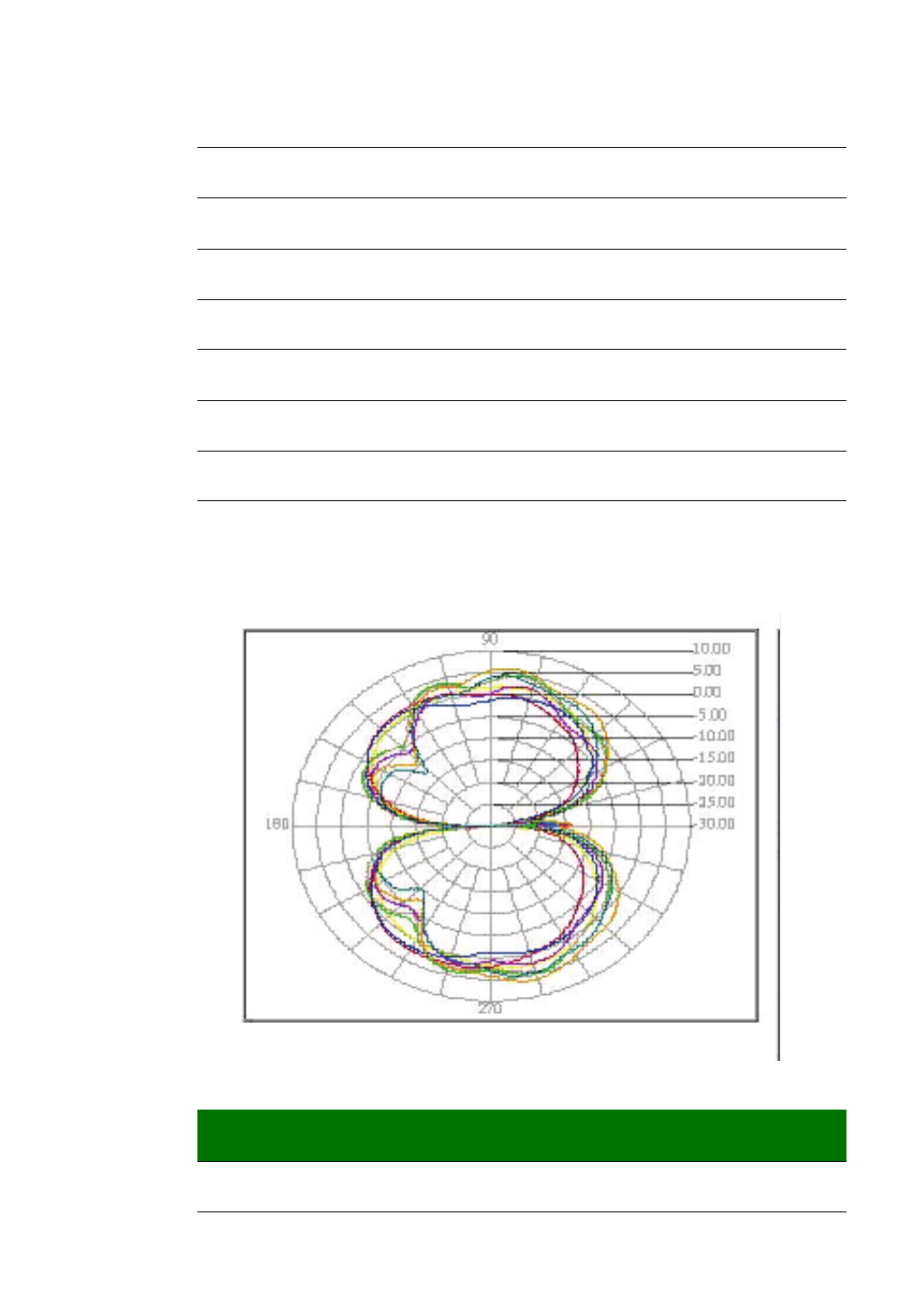
. . . . .
www.digiembedded.com 89
Radiation
pattern: E-plane
(2.0 and 5.0 GHz)
Yellow 2400.0 3.39 257.68 2.98
Red 2450.00 3.17 214.74 2.37
Blue 2500.00 2.79 288.0 1.96
Purple 5150.00 2.25 280.42 0.82
Green 5200.00 5.23 252.63 2.71
Light brown 5250.00 4.51 272.84 3.16
Orange 5750.00 5.03 267.79 3.88
Aqua 5850.00 3.83 276.63 2.74
Color Freq (MHz) Peak (dBi) Angle (o) Avg (dBi)
Yellow 2400.0 2.60 283.22 -1.10

90 ConnectCore 9P 9215 and Wi-9P 9215 Hardware Reference
A
Red 2450.00 2.57 240.42 -1.36
Blue 2500.00 1.92 237.27 -1.78
Purple 5150.00 2.37 78.67 -1.91
Green 5200.00 4.80 79.30 0.32
Light brown 5250.00 4.49 79.93 -0.01
Orange 5750.00 6.34 283.85 1.08
Aqua 5850.00 4.67 283.22 -0.46

91
Appendix B:Certifications
The ConnectCore 9P 9215 and Wi-9P 9215 products comply with the standards
cited in this section.
. . . . . . . . . . . . . . . . . . . . . . . . . . . . . . . . . . . . . . . . . . . . . . . . . . . . . . . . . . . . . . . . . . . . . . . . . . . . . . . . . .
FCC Part 15 Class B
Radio Frequency Interface (RFI) (FCC 15.105)
The ConnectCore 9P 9215 and ConnectCore Wi-9P 9215 modules have been tested
and found to comply with the limits for Class B digital devices pursuant to Part 15
Subpart B, of the FCC rules. These limits are designed to provide reasonable
protection against harmful interference in a residential environment. This
equipment generates, uses, and can radiate radio frequency energy, and if not
installed and used in accordance with the instruction manual, may cause harmful
interference to radio communications. However, there is no guarantee that
interference will not occur in a particular installation. If this equipment does cause
harmful interference to radio or television reception, which can be determined by
turning the equipment off and on, the user is encouraged to try and correct the
interference by one or more of the following measures:
Reorient or relocate the receiving antenna.
Increase the separation between the equipment and receiver.
Connect the equipment into an outlet on a circuit different from that to which
the receiver is connected.
Consult the dealer or an experienced radio/TV technician for help.
Labeling Requirements (FCC 15.19)
This device complies with Part 15 of FCC rules. Operation is subject to the following
two conditions: (1) this device may not cause harmful interference, and (2) this

92 ConnectCore 9P 9215 and Wi-9P 9215 Hardware Reference
B
device must accept any interference received, including interference that may
cause undesired operation.
If the FCC ID is not visible when installed inside another device, then the outside of
the device into which the module is installed must also display a label referring to
the enclosed module FCC ID. THis exterior label can use wording such as the
following: “Contains Transmitter Module FCC ID: MCQ-50M1355/ IC: 1846A-
50M1355”.
RF Exposure
RF exposure considerations require that a 20 cm separation distance between users
and the installed antenna location shall be maintained at all times when the module
is energized. OEM installers must consider suitable module and antenna installation
locations in order to assure this 20 cm separation, and end users must be also be
advised of the requirement.
Modifications (FCC 15.21)
Changes or modifications to this equipment not expressly approved by Digi may void
the user’s authority to operate this equipment.
Industry Canada
This digital apparatus does not exceed the Class B limits for radio noise emissions
from digital apparatus set out in the Radio Interference Regulations of the Canadian
Department of Communications.
Le present appareil numerique n’emet pas de bruits radioelectriques depassant les
limites applicables aux appareils numeriques de la class B prescrites dans le
Reglement sur le brouillage radioelectrique edicte par le ministere des
Communications du Canada.
The maximum antenna gain permitted in the bands 5250-5350 MHz and 5470-5725
MHz to comply with the e.i.r.p. limit is, according to RSS-210 section A9.2(2) :
250mW conducted power
1.0W max EIRP
This limit is met with the highest gain antenna listed, World Products Inc WPANTE3.
The maximum antenna gain permitted in the band 5725-5825 MHz to comply with
the e.i.r.p. limit specified for non point-to-point operation is, according to RSS-210
section A9.2(3):
1W conducted power.
4.0W max EIRP.

. . . . .
www.digiembedded.com 93
This limit is met with the highest gain antenna listed, World Products Inc WPANTE3.
OEM installers and users are cautioned to take note that high-power radars are
allocated as primary users (meaning they have priority) of the bands 5250-5350 MHz
and 5650-5850 MHz and these radars could cause interference and/or damage to
devices operating in these frequency bands.
Indoor/Outdoor
When the ConnectCore Wi-9P 9215 module is installed in devices that can be used
outdoors, the channels in the band 5150-5250 MHz must be disabled to comply with
US and Canadian regulatory requirements. The OEM users are encouraged to inform
end users of this restriction as well.

94 ConnectCore 9P 9215 and Wi-9P 9215 Hardware Reference
B
Declaration of Conformity
(In accordance with FCC Dockets 96-208 and 95-19)
Digi International declares that the product:
and the product:
to which this declaration relates, meet the requirements specified by the Federal
Communications Commission as detailed in the following specifications:
Part 15, Subpart B, for Class B equipment
FCC Docket 96-208 as it applies to Class B personal
Personal computers and peripherals
The product listed above has been tested at an External Test Laboratory certified
per FCC rules and has been found to meet the FCC, Part 15, Class B, Emission
Limits. Documentation is on file and available from the Digi International
Homologation Department.
Manufacturer’s Name: Digi International
Corporate Headquarters: 11001 Bren Road East
Minnetonka MN 55343
Manufacturing Headquarters: 10000 West 76th Street
Eden Prairie MN 55344
Product Name ConnectCore 9P 9215
Model Numbers: FS-3029
FS-3038
Product Name ConnectCore Wi- 9P 9215
Model Numbers: FS-3044

. . . . .
www.digiembedded.com 95
International EMC Standards
The ConnectCore 9P 9215 and the Wi-9P 9215 meets the following standards:
Standards ConnectCore 9P 9215
Emissions FCC Part 15 Subpart B
ICES-003
Immunity EN 55022
EN 55024
Safety UL 60950-1
CSA C22.2, No. 60950-1
EN60950-1

96 ConnectCore 9P 9215 and Wi-9P 9215 Hardware Reference
B

97
Appendix C:Change log
The following changes were made to this document in revisions listed below.
. . . . . . . . . . . . . . . . . . . . . . . . . . . . . . . . . . . . . . . . . . . . . . . . . . . . . . . . . . . . . . . . . . . . . . . . . . . . . . . . . .
Revision B
1Deleted the following non-applicable text: “Onboard flash: The module has
8Mx16 NOR by 2Mx16 NOR flash onboard. Greater sizes can optionally be
populated, if available.”
2Replaced “Current measurements with FIM (DRPIC) enabled” and “Current measure-
ments with FIM (DRPIC) disabled” with “Typical module current / power measure-
ments” and “Typical power save module / JumpStart board current / power
consumption measurements.”
. . . . . . . . . . . . . . . . . . . . . . . . . . . . . . . . . . . . . . . . . . . . . . . . . . . . . . . . . . . . . . . . . . . . . . . . . . . . . . . . . .
Revision C
1On page 9 updated Digi Information.
2On page 43 within Serial Port B MEI configuration switches table, deleted non
applicable reference to RS422/RS485 regarding S1.1.
3On page 48 corrected Serial UART ports figure callout arrows.
4On page 60 regarding POE_GND, corrected from X24 to X26.4 and X26.5.
5On page 72 corrected figure of module top.
. . . . . . . . . . . . . . . . . . . . . . . . . . . . . . . . . . . . . . . . . . . . . . . . . . . . . . . . . . . . . . . . . . . . . . . . . . . . . . . . . .
Revision D
Made additions necessary to accommodate additional device, CCWi-9P 9215.

98 ConnectCore 9P 9215 and Wi-9P 9215 Hardware Reference
. . . . . . . . . . . . . . . . . . . . . . . . . . . . . . . . . . . . . . . . . . . . . . . . . . . . . . . . . . . . . . . . . . . . . . . . . . . . . . . . . .
Revision E
Made corrections to current draw information.
. . . . . . . . . . . . . . . . . . . . . . . . . . . . . . . . . . . . . . . . . . . . . . . . . . . . . . . . . . . . . . . . . . . . . . . . . . . . . . . . . .
Revision F
Minor data corrections were made and Canadian certifications information was
expanded.
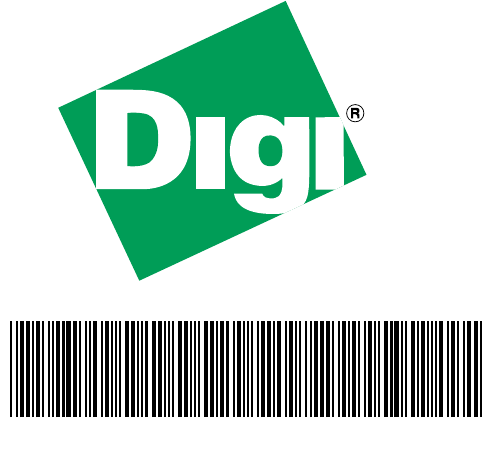
PN (1P): 90000879-88 F

100 ConnectCore 9P 9215 and Wi-9P 9215 Hardware Reference